Topic outline
UNIT 1 MEDICATIONS FOR PAIN, FEVER, SEIZURES AND INFLAMATION
Key Unit competence:
Provide appropriate medications for pain, fever, inflammation, and seizures.
Introductory activity 1.0
Observe the images above and respond to the following questions:
1. What do you observe from the images above?2. What do you think people on the images above are doing or experiencing?
1.1. Overview on pathophysiology of fever
Learning Activity 1.1
1. Ill patients can express different symptoms in their illness status which arefound during nursing assessement and managed with different medications
2. Patient on image A started complaining of health condition, and the
bassessment’s data have shown a high fever of 38.5oc. different medications
were selected for the management of the case (Image C & B). Using librarytextbooks, describe the physiology of fever.
CONTENT SUMMARY
Thermoregulation is interceded by the hypothalamus. Peripheral thermoreceptors
located in different body parts as skin, abdominal organs, as well as central
thermoreceptors found in the spinal cord and other central locations offer the
hypothalamus with information about skin and core temperatures. If these
temperatures are abnormally high, the hypothalamus responds by triggering or
heat loss mechanisms. While, when the temperatures are abnormally low thehypothalamus responds by triggering heat production, heat conservation.
Body temperature is determined by the balance between heat production by tissues,
particularly the liver and muscles, and heat loss from the periphery. Normally, the
hypothalamic thermoregulatory center maintains the internal temperature between
37° and 38° C. Fever results when something raises the hypothalamic set point,
triggering vasoconstriction and shunting of blood from the periphery to decrease
heat loss; sometimes shivering, which increases heat production, is induced. These
processes continue until the temperature of the blood bathing the hypothalamus
reaches the new set point. Resetting the hypothalamic set point downward for
example, when antipyretic drugs are given, initiates heat loss through sweating
and vasodilation. The capacity to generate a fever is reduced in certain patients likealcoholics, the very old, the very young.
Pyrogens are substances that cause fever. Exogenous pyrogens are usually
microbes or their products. The best studied are the lipopolysaccharides of gramnegative
bacteria, commonly called endotoxins and Staphylococcus aureus toxin,
which cause toxic shock syndrome. Fever is the result of exogenous pyrogens
that induce release of endogenous pyrogens, such as interleukin-1 (IL-1), tumor
necrosis factor-alpha (TNF-alpha), and IL-6 and other cytokines, which then trigger
cytokine receptors, or of exogenous pyrogens that directly trigger Toll-like receptors.Prostaglandin E2 synthesis appears to play a critical role.
Fever is a natural defense mechanism for neutralizing foreigner organisms. High
body temperature or fever destroys and kills many species of bacteria; but when it
remain high it destroy even some normal cells of human body. Medications used totreat fever are known as antipyretics
Fever is diagnosed by measuring body temperature using thermomether , The
use of thermometer to measure body temperature is the most accurate way of
diagnosing fever. Sites for fever mesearument include oral,axillary,tympanic,analdepending on available materials, age, status and preferance of the patient.
A nurse should consider as fever the temperture above 37.50c, if the thermometer
is not available touching the skin is an other alternative even though,it is less
acurate and can expose to any other health related problems such as infection
desease transmission. This is especially the case if you’re self-diagnosing. When
using touch to diagnose a fever in someone else, touch your own skin first, then
touch the other person to compare the two temperatures. If the other person is a
lot hotter than you, they may have a fever. You can also try pinching the skin on the
back of your hand to check for signs of dehydration. If the skin doesn’t snap backquickly, you might be dehydrated. Dehydration may be a sign of a fever.
Self assessment 1.1
Complete the following sentences:
1. When the body’s temperature is very low, the hypothalamus responds
by……….
2. When the body temperature is very high, the hypothalamus responds by……….
1.2 Medications for fever
Learning Activity 1.2
A 20 years old female patient went to the health facility because she was worried
about the high fever, shivering, sweating. She was experiencing the symptoms
since yesterday. After admission, they found that her axillary body temperature
is 39.0oc, and directly she received two tablets that she swallowed immediately
before other intervention that were proposed.
Using Library textbooks, respond to the following questions
1. What is an antipyretic drug?
2. Describe the mechanism of action of Paracetamol?3. Identify the forms of Paracetamol.
CONTENT SUMMARY
Fever is treated by different medications including Acetaminophen or Paracetamol
which is a commonly used antipyretic. It is classified in antipyretic analgesic drugs.
Paracetamol is a chief of group of medication used to reduce fever by direct action
at the level of the hypothalamus and dilation of peripheral blood vessels, whichenables sweating and dissipation of heat.
Acetaminophen has the equal efficacy to reduce fever as ibuprofen, and aspirin,
however this aspirin and ibuprofen have anti-inflammatory properties that is why
acetaminophen is used as the primary therapeutic usefulness for the treatment
of fever in patients. Acetaminophen is rapidly engrossed from the gastrointestinal
tract, attainment peak levels in 0.5 to 2 hours. It is extensively metabolized in theliver and excreted in the urine, with a half-life of about 2 hours.
Caution should be used in patients with hepatic or renal impairment could restrict
with metabolism and excretion of the drug. Acetaminophen crosses the placenta
and goes into breast milk; it should be used vigilantly during gestation or lactationbecause of its potential adverse effects on the fetus or neonate.
The dosage of paracetamol depends on age and the level of fever. In Adults and
adolescents, 500mg to 1000 mg every 6 to 8 hours per day the maximum is 4000 mg
in 24 hours. Whereas for paediatric clients it is 10-15 mg/kg 4-6hrly. Paracetamol is
available in many forms. Acetaminophen is available as tablets, caplets, solutions,suppositories and injectable. It is a Pregnancy category B drug.
Adverse effects associated with acetaminophen use include headache, hemolytic
anemia, renal dysfunction, skin rash, and fever. Hepatotoxicity is a potentially fatal
adverse effects that is usually associated with chronic use and overdose and is
related to direct toxic effects on the liver. The dose that could prove toxic varies
with the age of the patient, other drugs that the patient might be taking, and the
underlying hepatic function of that patient. When overdose occurs, acetylcysteinecan be used as an antidote. Life support measures may also be necessary.
Self assessment 1.2
1. Identify at least 3 medications used to manage fever
2. What is the correct dosage of paracetamol in children?
A. 10mg/kg every 6hours
B. 10mg to 15mg/kg
C. 10mg to 20mg/kg
D. 10mg to 15mg /kg every 4 to 6 hrs.
3. Choose all correct answers: The adverse effects of paracetamol are
A. Headache,
B. Kidney dysfunction
C. Bleeding
D. Skin rashE. Pruritis
1.3. Overview on pathophysiology of pain
Learning Activity 1.3
These patients above are expressing the same health problem at different sites.
Use library textbooks and internet to respond to the following question.
a) What is pain?
b) How can the pain be assessed?
CONTENT SUMMARY
Pain is a displeasing sensory and emotional experience related to real or potential
tissue impairment. It arises with many disorders, diagnostic tests, and treatments.
It incapacitates and distresses more people than any single disease. It is the most
common reason for consultation in health care facilities. Sensory experience of
pain depends on the interaction between the nervous system and the environment.
The processing of noxious stimuli and the resulting perception of pain implicate the
peripheral and central nervous systems.
Among the nerve mechanisms and structures involved in the transmission of pain
perceptions to and from the area of the brain that interprets pain are nociceptors, or
pain receptors, and chemical mediators.
Nociceptors are receptors that are preferentially sensitive to a noxious stimulus.
Nociceptors are also called pain receptors; Nociceptors are part of complex
multidirectional pathways. These nerve fibers branch very near their origin in the
skin and send fibers to local blood vessels, mast cells, hair follicles, and sweat
glands. When these fibers are stimulated, histamine is released from the mast cells,
causing vasodilation. Nociceptors answer to high-intensity mechanical, thermal,and chemical stimuli.
Some receptors respond to only one type of stimuli; others, called polymodal
nociceptors, respond to all three sorts of stimuli. These highly specialized neurons
transfer the mechanical, thermal, or chemical stimulus into electrical action or
action potentials. The cutaneous fibers located more centrally further branch and
communicate with the paravertebral sympathetic chain of the nervous system
and with large internal organs. As a result of the connections among these nerve
fibers, pain is often accompanied by vasomotor, autonomic, and visceral effects.
In a patient with severe acute pain, for example, gastrointestinal peristalsis maydecrease or stop.
Physiologically, pain occurs when sensory nerve endings called nociceptors (also
referred to as pain receptors) come into contact with a painful or noxious stimulus.
The resulting nerve impulse travels from the sensory nerve ending to the spinal
cord, where the impulse is rapidly shunted to the brain via nerve tracts in the spinal
cord and brainstem. The brain processes the pain sensation and quickly responds
with a motor response in an attempt to cease the action causing the pain.
Pain can be caused by a mechanical, chemical or inflammatory, or thermal
mechanism. Pain of mechanical origin can be caused by acute trauma, injury,or overuse. It may be constant, variable, or intermittent in nature and is affected
by movement and position. Pain of chemical or inflammatory origin is associated
with arthritis and other inflammatory disorders. It is often constant but responds to
positioning, therapy, rest, and gentle movement. Pain of thermal origin is the resultof excessive heat or cold.
If an acute pain sensation is intense enough, it can cause system-wide responses:
increased alertness; focused attention; the suppression of feeding, sleep, and
reproduction; and increased vascular tone, respiration, and blood sugar levels. If
pain persists or becomes chronic it can even change the circuitry in the central
nervous system. Medications are usually a part of the management regimen forchemical or inflammatory pain.
Table 1.3.1: Factors influencing pain perception
Factors influencing the pain response include past experiences to pain, anxiety,
culture, age, gender, and expectations about pain relief. These factors may increase
or decrease the person’s perception of pain, upswing or reduced tolerance for pain,and affect the responses to pain.
Types of Pain
Figure 1.3.2: Types of Pain
Types of pain include nociceptive pain or Physiological pain (figure A) which is a
stimulation of sensory receptors for body and feels like aching, throbbing and sharp
such us stubbing of toe or case of damage or disease. It can be Superficial when
Skin and mucous membranes are involved, deep somatic when Muscles and joints
are involved or visceral when Organs are involved.
Neuropathic pain (figure B) is an abnormal reaction to stimuli caused by damaged
nerves. It can occur as a result of injury or infection. It can also flare up any
time without an obvious pain inducing event or factor. It is mostly a burning pain.
Sympathetic pain (figure C) is due to damage to sympathetic nerves. It is a bburning
pain with vasomotor instability and most of the time it is associated with rregional
sympathetic blocks.
The pain assessment begins by observing the patient carefully; noting the
patient’s overall posture and presence or absence of overt pain behaviors and
asking the person to describe, in his or her own words, the specifics of the pain
the words used to define the pain may ppoint toward the etiologic. The features
to consider in a whole pain assessment are the intensity, timing, location, quality,
personal meaning, aggravating and alleviating factors, and pain behaviors. Pain isa subjective phenomenon.
The highly subjective nature of pain Contests its assessment and management for
every health care provider. The report of pain is a social deal; thus, assessment
and management of pain require a good rapport with the person in hurt. In pain
assessment, the health care provider reviews the patient’s report of the pain and
other factors that may impact pain as well as the person’s response to pain liberation
strategies. Documentation of the pain level as graded on a pain scale becomes part
of the patient’s medical record, as does a record of the pain relief obtained frominterventions.
Pain assessment includes defining what level of pain relief the acutely ill patient,
believes is needed to recover quickly or improve utility, or what level of relief thechronically or terminally ill patient requires to maintain wellbeing.
Many scales were designed to assess the extent of pain at different levels. The
most commonly used scale is numeric scale that uses number to rate pain forpeople aged 9years and above.
By numerical scale, the patient rate verbally his/her client from 0 to 10 depending
of his/her feeling of pain then the health care provider classify to no pain, mild pain,
moderate pain, severe pain depending on the number the client has indicated andconsidering the figure below.
Figure 1.3.3: Numerical scale
Self assessment 1.3
1. Identify different types of pain
2. Using a pain scale, a patient who scored 6/10 is considered having (which
level of pain)?
3. Respond by True or false
1. The pain is disagreeable sensory and emotional experience related
only to diseases.
2. The pain is subjective in nature.3. Pain medications always cause heavy sedation
1.4 Medication for pain management
Learning Activity 1.4
A patient was operated yesterday. He declares that the site of incision hurts very
much. He did not sleep well the last night; he is crying in his bed.
Using library textbooks, respond to the following question
1. Identify classes of analgesics. Give an example for each class
2. What are the indications of morphine?3. List the contraindication of tramadol
Analgesia is defined as insensibility of pain. Medications used to relive pain are
analgesic or painkiller. Analgesics are classified as Opioid analgesics (strong opioid
and weak opioid) and non-opioid analgesics that include salicylates (example
aspirin), non-steroidal ant inflammatory drugs like ibuprofen and acetaminophen.Strong opioid analgesic includes morphine.
It is indicated to relieve acute or chronic moderate to severe and to complement
general, local, or regional anesthesia. It Binds with and activates opioid receptors
in brain and spinal cord to produce analgesia effect. Morphine has a half-life of 1.5to 2 hours, metabolized in the liver, excreted in the urine and bile
All forms of morphine are contraindicated in case of asthma, hypersensitivity
to morphine or its components, labor with premature delivery and respiratory
depression or upper airway obstruction. Some side effects may arise when
morphine is administered for example light-headedness, dizziness, sedation,
Nausea, vomiting, dry mouth, constipation, ureteral spasm, respiratory depression,
apnea, circulatory depression, respiratory arrest, shock, cardiac arrest. Morphineis available in various forms like capsules, Tablets, Oral Solution, Syrup, infusion.
Figure 1.5: Forms of morphine
The dosage of morphine varies considering the form, intensity of pain, route
of administration, indications and age of the patient. Tablets of morphine are
administered as initial dose of 15 to 30 mg orally every 4 hours as needed to manage
pain. For oral solution initial dose is 10 to 20 ml orally every 4 hours as needed.
For maintenance dose individually titrate to a dose that provides an appropriatebalance between pain management and opioid-related adverse reactions.
It is important to note that oral solution is available in 3 concentrations 2 mg/mL,
4 mg/mL, and 20 mg/mL; reserve use of 20 mg/mL concentration for patients who
are opioid-tolerant. For the parenteral use, intravenous dosage is 0.1 mg to 0.2
mg/kg via slow IV injection every 4 hours, intramuscular administration is 10 mg
IM every 4 hours alternatively, 2 to 10 mg IV as needed to manage pain (based on
70 kg adult). The dose of morphine is adjusted for pediatric patients .morphine isclassified in pregnancy category c.
Tramadol is among the commonly used weak opioid. It is used to relieve moderate
pain. It binds to the receptors and inhibits the reuptake of norepinephrine and
serotonin this enhance tramadol analgesic effect. In adults and adolescents over
age 16, it is administered 50 to 100 mg every 4 to 6 hr. as needed to manage pain
without exceeding 400mg daily. It is reduced in hepatic and renal conditions. Themaximum for patient aged 75 and above is reduced to 300 mg daily.
Tramadol should not be used for patient with history of addictions. Tramadol is
contraindicated for persons with alcohol intoxication; excessive use of centralacting
analgesics, hypnotics, opioids, or other psychotropic drugs; hypersensitivity
to tramadol or its components. Tramadol is a pregnancy category C drug. Tramadolis available in different forms: capsules (a), tablet (b), caplets(c) and injectable(d).
Figure 1.6: Forms of tramadol
Adjuvant drugs can be used to enhance the effects of pain medications, treat
concurrent symptoms, and provide analgesia for other types of pain. Adjuvant
analgesics are particularly useful when evidence of decreased opioid responsivenessis present
Self assessment 1.4
1. Choose the correct answer:
Medications used to treat pain include:
A. Amoxicillin, paracetamol, tramadol
B. Paracetamol, morphine, erythromycin
C. Morphine, ibuprofen, diclofenac
D. Amoxicillin, Ibuprofen, tramadol
2. What are the contraindications for morphine administration?
A. Malaria
B. Asthma,
C. Respiratory depression
D. B and C
3. Which one among the following pain killers is a weak opioid?
A. Paracetamol
B. Tramadol
C. AspirinD. Ibuprofen
1.5 World health organization (WHO) pain management ladder
Learning Activity 1.5
Using library text books and internet search respond to the following questions,
and note the findings
1. According to WHO Ladder, what are the levels of pain?2. Explain how each level is managed?
CONTENT SUMMARY
The optimal pain control is multimodal and individualized. This does not contradict
the value of the generalized WHO pain ladder, but clinicians should feel free to
modify it, as needed, for individual patients, reflecting modern pain practice. The use
of the pain ladder offers effective and cost-effective pain relief for patients suffering
from chronic pain. The WHO pain ladder describes pain in terms of intensity and
recommends that analgesics be prescribed starting at Step 1 using non opioid
analgesics, such as acetaminophen or non-steroidal anti-inflammatory drugs such
as ibuprofen If the pain persists or worsens, the clinician prescribes pain relievers
from Step 2, described as “weak opioids,” such us tramadol with or without a
non-opioid. At this point, if pain persists or worsens, the patient is administered a
“strong opioid,” at Step 3. Thus, pain therapy is based on pain intensity and patients
progress through the steps one by one, from lowest to highest, until pain relief isobtained.
Figure 1.7: WHO LadderReference: https://www.mdpi.com/1648-9144/55/9/584/htm
Myths about Pain
There are many barriers and myths regarding use of pain management medications
and on overall pain management that can result in negative patient outcomes. Even
if some myths are a part of the subculture of different medical disciplines, mistakenbeliefs are universal throughout the healthcare system.
Some persons believe that the healthcare providers do an adequate job of providing
adequate pain control. There is myth that pain medications always lead to addictionthis belief prevent some clients and health care provider to use painkillers frequently.
There is belief that Pain medications always cause heavy sedation, some clients
and professional refuse to administer prescribed dose thinking that there may be
sedation. Again, there is belief that some kinds of pain cannot be relieved. These
affect the client physically, emotionally when health care providers do not givepainkillers thinking that the pain may not be relieved.
Pain and suffering are character-building. Same people assume that in same
conditions of pain can empower the person with pain in personal resistance on
different life challenges thought pain does not affect how the person pursue theexternal life challenges.
Narcotic analgesics in older patients should be avoided. This is not true, older
person respond well on the effect of narcotic drugs if it has been administered withconsiderations for each patient specificity.
Self assessment 1.5
1. Which one among the following pain killers is a weak opioid?
A. Paracetamol
B. Tramadol
C. Aspirin
D. Ibuprofen
2. Which drug combination is true about the management of moderate pain
according to WHO pain management ladder
A. Paracetamol +Buscopan
B. Tramadol+ Buscopan
C. Morphine+ Paracetamol
D. Ibuprofen + Paracetamo3. Why do we need to use adjuvant with painkillers in pain management?
1.6. Anaesthetics
Learning Activity 1.6
Read the following case study and respond to the questions asked at the end.
Mr N.A was running on the road as usual sport as he used to do in the morning,
accidentally he falls down and a piece of glass severely cut him on the forearm.
A s you were around you approached him and advise him to directly to the health
facility, arriving there, the nurse said that Mr NA will need to be sutured. You
heard that she will give an injection of anaesthetics of the site of injury before
suturing.
Using library textbooks, respond to the following questions
1. What is an anaesthetic drug?
2. Why is it important to provide anaesthetic before suturing a wound?3. Enumerate categories of anaesthetics
Anesthetic is a drug used to cause complete or partial loss of sensation. It is called
local anesthesia when it blocks nerve preventing depolarization of nerve membranes,
blocking the transmission of pain stimuli and, in some cases, motor activity and it
is general when it causes induction of loss of consciousness, amnesia (loss of
memory), analgesia and loss of reflexes to allow surgical procedure performance.
Induction is the time from the beginning of anesthesia until achievement of surgical
anesthesia. Use of anesthetic agents suspends the sensation in parts of the body
they exist.
The anesthetics can be subdivided into general and local anesthetics, depending
on their site of action. General anesthetics are central nervous system (CNS)
depressants used to produce loss of pain sensation and consciousness. Sedatives
are agents given prior to induction of an anesthetic agent if indicated it leads on loss
of conscious and muscle relaxation to easier other procedures such us intubation.
Typically, the experience is smooth one and the patient has no recall of the events.
3 Stages of sedation
a) Minimal Sedation, the minimal sedation level is a drug-induced state during
which the patient can respond normally to verbal commands. Cognitive
function and coordination may be impaired, but respiratory and cardiovascularfunctions are not affected.
b) Moderate sedation is a form of anesthesia that may be produced intravenously.
It is defined as a depressed level of consciousness that does not impair the
patient’s ability to maintain a patent airway. And to respond appropriately tophysical stimulation and verbal command.
c) Deep Sedation is a drug-induced state during which a patient cannot be
easily aroused but can respond purposefully after repeated stimulation The
difference between deep sedation and anesthesia is that the anesthetized
patient is not arousal. Deep sedation and anesthesia are achieved when an
anesthetic agent is inhaled or administered intravenously.
Local anesthesia is the injection or application of a solution containing the local
anesthetic into/to the tissues at the planned incision site. Often it is combined with
a local regional block by injecting the nerves immediately supplying the area. Theadvantages of local anesthesia are as follows:
– It is simple, economical, and no expensive.
– Equipment needed is minimal.
– Postoperative recovery is brief.
– Undesirable effects of general anesthesia are avoided.– It is ideal for short and superficial surgical procedures.
Local anesthesia is often administered in combination with epinephrine. Epinephrine
constricts blood vessels, which prevents rapid absorption of the anesthetic agent
and thus prolongs its local action. Rapid absorption of the anesthetic agent into the
bloodstream, which could cause seizures, is also prevented. Local anesthesia isthe anesthesia of choice in any surgical procedure in which it can be used.
However, contraindications include high preoperative levels of anxiety, because
surgery with local anesthesia may increase anxiety. A patient who requests general
anesthesia rarely does well under local anesthesia. For some surgical procedures,
local anesthesia is impractical because of the number of injections and the amount
of anesthetic that would be required. The skin is prepared as for any surgical
procedure, and a small gauge needle is used to inject a modest amount of theanesthetic into the skin layers.
This produces blanching or a wheal. Additional anesthetic is then injected in the
skin until an area the length of the proposed incision is anesthetized. A larger,
longer Needle then is used to infiltrate deeper tissues with the anesthetic. Local
anaesthetics include various classes like esters examples procaine, benzocaine,
cloroprocaine, procaine, tetracaine and amides class where we find buvicaine,
lidocaine, and mepivacaine. Local anesthetics block the depolarization of nerve
membranes, preventing the transmission of pain sensations and motor stimuli(Figure B)
Local anesthetics are administered to deliver the drug directly to the desired area
and to prevent systemic absorption, which could lead to serious interruption ofnerve impulses and response
Figure 1.6.1: pain impulse transmission
Local anesthetics
Bupivacaine (marcaine), etidocaine (duranest) those anesthetics are
administered by infiltration peripheral nerve block the duration is 2–3 times longer
it is used cautiously in patients with known drug allergies or sensitivities. While
using bupivacaine should consider a period of analgesia persists after return of
sensation; therefore, need for strong analgesics.
Procaine (novocaine) is administered subcutaneously, intramuscularly,
intravenously, or spinal.it has low toxicity; inexpensive it can cause some
idiosyncrasies skin rash poor stability. There is a need to observe for reaction such
us hypotension, bradycardia, weak pulse. Usually administered with epinephrine,
causing vasoconstriction, thereby slowing absorption and prolonging nervedeadening effect
Tetracaine (pontocaine) is administered to topical infiltration nerve block it causes
topical infiltration nerve block but can cause some idiosyncrasies skin rash poor
stability, as potent as procaine usually administered with epinephrine.
Lidocaine (xylocaine) and mepivacaine (carbocaine); Lidocaine can be
administered in topical or injection, it is Rapid Longer duration of action, while
administer Lidocaine they should consider, Useful topically for cystoscopy Injected
for use in dental work and surgery, Observe for untoward reaction, drowsiness,
depressed respiration. Lidocaine is currently widely used local anaesthesia; it acts
by blocking neuronal pain impulses. It may be injected as a nerve block for spinal
and epidural anesthesia. It blocks sodium channels located within the membranesof neurons.
Figure1.6.2:Local Anesthetics
Lidocaine is available in injectable forms(A), Cream for topical use( B),spray (C) and
patches (D). Their use will depend on the client, procedure to be performed and the
desired effect. Solutions of lidocaine containing preservatives or epinephrine with
vasoconstriction effect are intended for local anesthesia only and must never begiven parenteral for dysrhythmias.
It is not advisable to apply topical lidocaine to large skin or broken areas as this
led to systemic absorption. It should not be in contact with eyes. Lidocaine is not
indicated in case of hypersensitivity to amide local anesthetics. Application or
injection of lidocaine anesthetic is also contraindicated in the presence of severe
trauma or sepsis, dysrhythmias, sinus bradycardia, and severe degrees of heart
block. Lidocaine is a pregnancy category B drug.
Local anaesthetics are generally very safe and serious problems are rare. However,
some discomfort when the injection is given, a tingling sensation as the medication
wears off, possibly some minor bruising, bleeding or soreness where the injection
was given Some people experience experience temporary side effects from a
local anesthetics, such as, dizziness, headaches, blurred vision, twitching muscles,
continuing numbness, weakness or pins and needles. In very rare cases, you could
have an allergic reaction to the local anesthetic or develop serious problems, such
as seizures or a cardiac arrest. Precautions should be taken while injecting localanesthesia.
Self assessment 1.6
1. List at least 4 advantages of using local anesthetics
2. Identify at least 5 complications of local anesthetics
3. The following are the forms of Lidocaine except
A. Tablets
B. Sprays
C. InjectableD. Cream
1.7. Overview on physiology of inflammation
Learning Activity 1.7
1. What should be the problem on those images above ?
2. What are the causes of inflammation?( Please refer to library textbooks/
internet)3. Explain the physiology of inflammation
CONTENT SUMMARY
In case the body get exposed to various stimuli like physical injury, exposure to toxic
chemicals, extreme heat, invading microorganism or cell death, it reacts by defense
mechanism called inflammation. The latter is considered nonspecific defense
mechanism as it proceds in the same way regardless of the cause that triggered
it. The main purpose of infammation is to recover the body from injury or destroy
microrganism. By neutralizing the foreign agent and removing cellular debris and
dead cells, repair of the injured area is able to proceed at a faster pace. Whether
the damage is due to pathogens, chemicals, or physical trauma, the damaged
tissue releases a number of chemical mediators that act as an alarms to notify the
surrounding area of the injury.
Chemical mediators of inflammation include histamine, leukotrienes,
bradykinin, complement, and prostaglandins. Some of these inflammatory
mediators are important targets for anti-inflammatory drugs. Signs of inflammation
include swelling, pain, warmth, and redness of the affected area. Inflammation may
be classified as acute or chronic. Acute inflammation has an immediate onset and
8 to 10 days are normally needed for the symptoms to resolve and for repair to
begin. If the body cannot contain or neutralize the damaging agent, inflammationmay continue for long periods and become chronic.
Self assessment 1.7
1. What happens to the human body when an inflammation doen’t resolve?2. What are Chemical mediators of the inflammation?
1.8 Anti-Inflammatory Drugs
Learning Activity 1.8
Use library textbooks and respond to the following questions:
1. Enumerate commonly used anti-inflammatory drugs
2. Explain the mechanism of action of Nonsteroidal anti-inflammatory drugs3. List the side effects of anti-inflammatory drugs
CONTENT SUMMARY
Anti-inflammatory agents are drugs that block the effects of the inflammation.
The inflammatory response is the body’s nonspecific response to cell injury,
resulting in pain, swelling, heat, and redness in the affected area. Anti inflammatory
drugs have antipyretic effect by blocking fever, often by direct effects on the
thermoregulatory center in the hypothalamus or by blockade of prostaglandin
mediators. Antinflammatory drugs include nonsteroidal anti-inflammatory drugs(NSAIDs), salicylates, acetic acid classes
Nonsteroidalanti-inflammatory drugs are that widely used. They act by blocking
prostaglandin synthesis and acting as anti-infl ammatory, antipyretic, and analgesic
agents. The NSAIDs are rapidly absorbed from the GI tract, reaching peak levels in
1 to 3 hours. They are metabolized in the liver and excreted in the urine. NSAIDs
cross the placenta and cross into breast milk. Therefore, they are not recommended
during pregnancy and lactation because of the potential adverse effects on the
fetus or neonate.the general side effects of NSAD include :Bleeding ,Gastric abset
and reduced kidney function . There are two main classes of antinflammatory
drugs including propionic acids and acetic acids.Among the propionic acid drug;ibuprofen is the mostly used drug to treat inflammation.
Inhibits prostaglandin synthesis by blocking Cyclooxygenase-1 and -2 receptor
sites, leading to an anti-inflammatory effect, analgesia, and antipyretic effects for
this it decreases swelling, pain, inflammation and fever. I t is indicated to relief of
the signs and symptoms of rheumatoid arthritis and osteoarthritis; relief of mild tomoderate pain; treatment of primary dysmenorrhea and fever.
Ibuprofen is available as tablets (A, B, C) either 200mg or 400mg per tablet and
oral solution (D, E) In adults, ibuprofen dose is 400 mg tid or qid with the maximum
of 1,200 mg/day and for pediatric clients the dosage is 5 - 10mg/kg 6-8hrly the
maximum being 30mg/kg/day. Ibuprofen has a half-life of 1.8 to 2.5 hours. It is
metabolized in the liver and excreted in the urine.The commonly adverse effect
of ibuprofen includes headache, dizziness, somnolence, fatigue, rash, nausea,
dyspepsia, bleeding, drug-induced peptic ulcer, constipation. Ibuprofen is apregnancy category C before the first 30weeks of gestation and D from 30 weeks.
Figure 1.8.1 Iburpfen forms
Diclofenac and indomethacin are acetic acid derivative Nonsteroidal anti
inflammatory drugs. Diclofenac is a phenylacetic acid derivative while indomethacin
is an indoleacetic acid derivative. Diclofenac is Analgesic, anti-inflammatory
that acts by blocking the activity of cyclooxygenase, the enzyme needed to
synthesize prostaglandins, which mediate inflammatory response and cause
local pain, swelling, and vasodilation. By blocking cyclooxygenase and inhibiting
prostaglandins, Diclofenac reduces inflammatory symptoms. This mechanism also
relieves pain because prostaglandins promote pain transmission from periphery tospinal cord.
Diclofenac is indicated for the treatment of acute and chronic pain associated with
inflammatory conditions in adults. In adults, diclofenac is prescribed as 50 mg t.i.d.,
p.r.n or bid–qid with the maximum of 200 mg per day, 100 mg for first dose only. The
half-life is 2hours. The dose is reduced, if needed, for elderly patients and those
with serious renal dysfunction. For injectable, the dosage is 2mg/kg/day resulting
approximately in 1ampoule bid the half-life being 1.15 hours for suppositories
100mg bid is prescribed and the half is 3 to 6 hours. Patches for topical application,
one patch is applied bid to the most painful area 12 hours.
Diclofenac is contraindicated for persons with active GI bleeding or ulcers; asthma
attacks, rhinitis, or urticarial from aspirin or other NSAIDs, hypersensitivity to
diclofenac or NSAIDs; treatment of perioperative pain after coronary artery bypass
grafting. It is a Pregnancy category B drug. Indomethacin Relief of moderate to
severe pain in PO 25 to 50 mg b.i.d. to q.i.d., increased by 25 or 50 mg daily every
week, if needed the maximum being 200 mg daily. Diclofenac comes as an oral
capsule (A, B), oral tablet (C), injectable (D, E) topical gel(G), suppository(H),
transdermal patch (I), topical solution, and powder packets for oral solution (Figure
1.8.2)Figure 1.8.2: Diclofenac forms
Salicylates are salicylic acid compounds used as anti-infl ammatory, antipyretic,
and analgesic agents.They inhibit the synthesis of prostaglandin, which is an
important prostaglandin mediator of pyrogens at the thermoregulatory center
of the hypothalamus.They are most popular and oldest anti-inflamamtory drugs
with antipyretic and analgesic properties. They are generallyavailable without
prescription and are relatively nontoxic when used as directed. Salicylates are
readily absorbed directly from the stomach, reaching peak levels within 5 to 30
minutes. They are metabolized in the liver and excreted in the urine. The half-lifeof 15 minutes to 12 hours, depending on thesalicylate.
Salicylates cross the placenta and enter breast milk; they are not indicated for
use during pregnancy or lactation because of the potential adverse effects on the
neonate and associated bleeding risks for the mother.S alicylates should not be used
by people with known allergy to salicylates or other nonsteroidal anti-inflammatory
drugs and those with active bleeding. It is the same for patients presenting nasal
polyps, those hostory of asthma, chiken pox or influenza,surgery or othe invasive
procedures within 1 week as this may lead to bleeding . They are not used by
pregnant and lactating mothers and persons with reanl impairement.
The adverse effects associated with salicylates results from its direct
effects on the stomach and these include nausea, dyspepsia, heartburn,
epigastric discomfort or its effect on clotting. When administered at higher
levels, a salicysm syndrome arises with dizziness,ringing in ears,difficult in
breathing,nausea,vomiting,diarrhea and mental confusion. Salicylate toxicity also
occur when a dose of 20to 25g in adults or 4gin children is administered and the
signs include hyperpnea,tachypnea,hemorrage,excitement,confusion, pumonary
edemaconvulsion, tetany,acidosis,fever,cardiovascular,renal and respiratory
collapse.
Aspirin is the most commonly used salicylate. At lower level, it affects platelet
aggregation by inhibiting the synthesis of thromboxane A2, a potent vasoconstrictor
that normally increases platelet aggregation and blood clot formation. At higher
levels, aspirin inhibits the synthesis of prostacyclin, a vasodilator that inhibits
platelet aggregation.Salicylates are indicated for the treatment of mild to moderate
pain, fever, and numerous inflammatory conditions, including rheumatoid arthritis
and osteoarthritis.
Aspirin inhibits the synthesis of prostaglandins by blocking the effects of pyrogens
at the hypothalamus and inhibiting platelet aggregation by blocking thromboxane
A2. The management of mild to moderate pain, fever, inflammatory conditions;
reduction of risk of transient ischemic attack or stroke and reduction of risk
of myocardial infarction. The half-life of aspirin is 15 minutes to 12 hours.It is
metabolized in the liver and excreted in the urine. pirin is available in oral tablet of75mg,100mg and 500mg.
In adults the dose is 350–650 mg every 4 h with the maximum of 4 gr per day. For
children ages 2 to 14, 10 to 15 mg/kg/dose every 4 hr, p.r.n., up to 80 mg/kg daily.
Pregnancy category: D. The adverse effects of aspirin include nausea, vomiting,heartburn, epigastric discomfort, occult blood loss, dizziness, tinnitus, acidosis.
Figure 1.8.3: Aspirin forms
Self assessment 1.8
Read carefully the text
You are working as nurse at RUBONA health center and you receive 2 clients
in consultation room. The client’s name is Mr. H aged 34 years old a man, who
complains the swelling on the left leg after has been bitten by a wood 3days
ago, while he was cutting a tree in his farm. He has joint pain for 1 week has no
fracture but the site is very hot and pain full with swelling. He has no history of
other diseases.
The second client is Miss N. aged 19 years old, who complains pelvic pain with
prostration but has normal vital signs. While you are taking history, she tells
you that she is on her first day of menstruation and she started feeling the pain
soon before menses start. Data obtained from the assessment and physical
examination revealed no any other problems noticed except the tenderness in
hypogastric region.
You are requested to manage these 2 patients’ problems.
1. Which problem does Mr. H has? Discuss how the problems of Mr. H should
be managed?
2. A. Discuss how the problems of Miss N can be treated?B. Is there any drug to avoid if yes why?
1.9 Medications for common cold and rhinitis
Learning Activity 1.9
Using library textbooks and internet, take note and respond to the following
questions.
1. What are the group of medication for common cold management?
Give an example of each group.2. Describe the mechanism of action of anti-histamines drugs.
CONTENT SUMMARY
The treatment of common cold consists of antihistamines, anti-inflammatories
and decongestant drugs. The signs and symptoms of allergic rhinitis resemble
those of the common cold. They include tearing eyes, sneezing, nasal congestion,
postnasal drip, and itching of the throat. The Goal of treating rhinitis aims at
preventing its occurance and relieve the present symptoms.The drugs used to treatrhinitis are categorized into two groups.
The Preventers which drugs used as prophylaxis include antihistamines,intranasal corticosteroids, and mast cell stabilizers.
Figure 1.9.1. Histamine action and body’s reactions
The Relievers are used to provide immediate, though temporary, relief for acute
allergy symptoms once they have occurred. Relievers include the oral and
intranasal decongestants, usually drugs from the sympathomimetic class. In
addition to treating allergic rhinitis with drugs, nurses should help patients identify
sources of the allergies and recommend appropriate interventions. These may
include removing pets from the home environment, cleaning moldy surfaces, using
microfilters on air conditioning units, and cleaning dust mites out of bedding, carpet,
or couches.
The histamine receptors responsible for allergic symptoms are called H1 receptors.
The other major histamine receptor, H2, is found in the gastric mucosa and is
responsible for peptic ulcers .Antihistamines are drugs that selectively block
histamine from reaching its H1 receptors, there by alleviating allergic symptoms.
Because the term antihistamine is nonspecific and does not indicate which of the
two histamine receptors are affected, H1-receptor antagonist is a more accurate
name.
In clinical practice, as well as in this text, the two terms are used interchangeably.
The most frequent therapeutic use of antihistamines is for the treatment of
allergies. These medications provide symptomatic relief from the characteristic
sneezing, runny nose, and itching of the eyes, nose, and throat of allergic rhinitis.
Antihistamines are often combined with decongestants and antitussives in OTC cold
and sinus medicines. The viruses that cause common cold cause inflammation of
the upper respiratory tract, by initiating the release of histamineand prostaglandins.
The inflamation leads to the increase engorgement of mucous membranes by blood
leading to tissue swelling and an increase in mucous production consequently, sinus
pain, nasal congestion, runny nose,sneezing,watery eyes,scratching the throat and
headache. In some people the eustachian tube’s outlet is blocked and the ear
becomme stuffed and painfull and more likely this results in otitis media.Rhinitis
is an inflammation of nasal cavity. This condition occurs when the upper airways
respond to a specifi c antigen like dust,pollen. The inflammatory response cause
sneezing,nasal congestion, stuffness and waterly eyes. While the treatment of the
treatment of rhinitis is antihistamines.
Antihistamines are drugs that block the release or action of histamine, a chemical
released during inflammation that increases secretions and narrows airways
in antihistamines drugs. Antihistamines are found in multiple out of the counter
preparations that are designed to relieve respiratory symptoms and to treat
allergies. When choosing an antihistamine, the individual patient’s reaction to the
drug is usually the governing factor.
Because first-generation antihistamines have greater anticholinergic effects with
resultant drowsiness, a person who needs to be alert should be given one of the
second-generation, less-sedating antihistamines. Because of their out of the counter
availability, these drugs are often misused to treat colds and influenza. Those
drug include the following: brompheniramine, carbinoxamine, chlorpheniramine,
clemastine, cyclizine, cyproheptadine, dexchlorpheniramine, dimenhydrinate,
diphenhydramine, promethazine, triprolidine these are in the first Generation.
Azelastine, cetirizine, desloratadine, fexofenadine, levocetirizine, loratadine
are in the second generation. Chlorpheniramine is a commonly used drug
in adults to treat simple common cold and rinitis while in moderate and chroniccases,desloratidin is prefered.
Figure 1.9.2. Anti histamine Drugs
Decongestants are drugs that decrease the blood flow to the upper respiratory
tract and decrease the overproduction of secretions. Decongestants decrease
the overproduction of secretions by causing local vasoconstriction to the upper
respiratory tract .This vasoconstriction leads to a shrinking of swollen mucous
membranes and tends to open clogged nasal passages, providing relief from the
discomfort of a blocked nose and promoting drainage of secretions and improved
airflow.
An adverse effect that accompanies frequent or prolonged use of these drugs
is a rebound congestion, technically called Rhinitis medicamentosa. The
reflex reaction to vasoconstriction is a rebound vasodilation, which often
leads to prolonged overuse of decongestants.They existe topical nasol
decongestant with ephedrine as prototype,oxymetazoline,phenylephrine,oral
decongestants pseudoepinephrine,topical nasol steroid decongestants such usbeclomethasone,budesonide,dexamethasone ,flunisolide is prototype.
Figure 1.9.3. Anti Decongestant Drugs
Table1.9.1: Decongestant drugs and their indications
Self assessment 1.9
Choose the best answer
1. Which drug among the following drugs is used in the treatment of common
cold?
A. Acetaminophen
B. Tramadol
C. Chlorphenamine
D. Cimetidine
2. Among the drugs below, which one is an intranasal decongestant?
A. Promethazine
B. Beclomethasone
C. Desloratidine
D. Omeprazole
3. What is the MOST COMMON side effect of nasal decongestant?
A. Nose bleeding
B. Runny nose
C. GI upsetD. Burning sensations
1.10. Overview on pathophysiology of seizures
Learning Activity 1.9
1. Based on your observations what should be the problem expressed in pictures?
2. Using library textbooks, describe the physiology of seizures?
CONTENT SUMMARY
Seizures are uncontrolled electrical activity in the brain that may lead to symptoms
ranging from mild loss of attention to violent muscular contractions that can
lead to death. Everyone has the potential to have seizures or convulsion. The
seizures occur when there is an abnormal electrical activity in the brain. They are
also known as convulsions, but not all seizures produce convulsive behavior which
is uncontrollable muscle contractions names as atonic seizures, Where there is aloss of muscular tone or strength.
The seizures’ symptoms produced dependent on which part of the brain is
experiencing the abnormal electrical activity. Seizures are generally short
lived from 15 seconds to 15 minutes however; there is a life-threatening type
of seizure, status epilepticus, in which the seizure does not end. A diversity of
conditions and substances can Cause seizures. Common trigger causes seizures
include congenital abnormalities of the brain, illicit drug use, fever, brain tumors
and metabolic imbalances, such as high levels of glucose or sodium. The epilepsy is
known as a condition in which a person experiences repeated seizures, due to anoverall electrical disturbance in the brain.
The terms convulsion and seizure are often used interchangeably and basically
have the same meaning, each different type of seizure disorder is characterized
by a specific pattern of events as well as a different pattern of motor or sensory
manifestations Partial or focal seizures arise from a localized area in the brain andcause specific symptoms.
A partial seizure can spread to the entire brain and cause a generalized seizure.Partial seizures include simple seizures in which consciousness is not impaired.
Figure 1.10.1 seizures transmission
Psychomotor seizures occur most often in children 3 years of age through
adolescence. The individual may experience an aura with perceptual alterations,
such as hallucinations or a strong sense of fear. Repeated coordinated but
inappropriate movements, such as clutching, kicking, picking at clothes, walkingin circles, and licking are characteristic. Generalized seizures include absence,
myoclonic, and tonic–clonics. Manifestations of a generalized tonic–clonic seizure
include alternate contraction (tonic phase) and relaxation of muscles, a loss of
consciousness, and abnormal behavior.
Myoclonic seizures involve sudden, forceful contractions involving the musculature
of the trunk, neck, and extremities. Absence seizures, previously referred to as
petit mal seizures, are seizures characterized by a brief loss of consciousness
during which physical activity ceases. The seizures typically last a few seconds,occur many times per day, and may go unnoticed by others.
Classification of seizures
If patients have a lower tolerance to environmental triggers; seizures may occur
when they are sleep deprived, are exposed to strobe or flickering lights, or have a
fluid and electrolyte imbalance. Seizure disorders occur throughout the life span.
Those who experience seizures, about half will experience their first seizure before
age 10. Seizure in pregnant woman requires special education to either prevent
conception or to safely prevent seizures during pregnancy. Seizure disorders in
the older adult are most often associated with an underlying comorbid condition.
Cerebrovascular disease, especially stroke, accounts for one third of all cases andis the most common risk factor for the development of epilepsy after age 6.
Febrile seizures are defined as seizures associated with fever in the absence of
central nervous system infection. Febrile seizures are common among children
and unusual in adults. In adults with hyperthermia above 40.5oc, nerve damage
coagulation of cell proteins leads to convulsions. The developing brain of child is
very sensitive to effects of mild to high fever that led to abnormal discharge of
electrical activity within the brain. The sudden rise in temperature seems to be
more important than the degree of temperature. The seizure may occur with the
initial onset of fever before a child’s caregiver is even aware the child is ill. Mostfebrile seizures are generalized when they involve the whole body.
In other words, the whole body may be involved and Stiffening of the entire body
Jerking of the arms and legs, complete lack of response to any stimuli, eyes
deviated, staring, rolling back, moving back and forth, tightness of the jaws and
mouth, urinary incontinence, noisy breathing, labored, slower than normal (unusualfor a child to stop breathing completely).
Although it may seem like infinity if you are observing a seizure, most of these
episodes last only 1-5 minutes. Afterward, the child is typically drowsy but usually
starts to become responsive within 15-30 minutes. Seizures may be focal when onepart of the body is involved.
Self assessment 1.10
1. Which of the following mostly triggers the seizures
A. Fever
B. Running
C. Pregnancy
D. Old age
2. What are the manifestations of Tonic- clonic seizures? Choose the correct
answer
A. Acute kidney injury
B. Abnormal bleeding
C. Loss of consciousness
D. Severe pain
3. True or False
A. The seizures occur when there is an abnormal electrical activity in the brain
B. Partial seizures can lead to generalized seizures
C. The young children are at higher risk of seizures associated with fever
because their developing brain is less sensitive to effects of mild to highfever.
1.11. Medications for seizures
Learning Activity 1.11
Use library textbooks, take note and respond to the following questions
1. What are the class of antiseizures? Give an example of medication on each
class.2. What are the common side effects of antiseizures drugs?
CONTENT SUMMARY
Medications for the management of seizure disorders are called antiseizures. Most
anti-seizures have specific uses; that is, they are of value only in the treatment
of certain types of seizure disorders. There are four categories of drugs used
as anticonvulsants: barbiturates, benzodiazepines, hydantoins, and the
succinimides, generally, anticonvulsants reduce the excitability of the neurons
(nerve cells) of the brain. When neuron excitability is decreased, seizures are
theoretically reduced in intensity and frequency of occurrence or, in some instances,
are virtually eliminated.
Barbiturates medications are the chemical derivatives of barbituric acid. These
drugs reduce neuronal excitability primarily by increasing GABA-mediated inhibition
through GABA RECEPTORS. They act on spinal cord, brainstem and the
Heightened GABAergic transmission at motor neurons in the spinal cord relaxesmuscles and suppresses ref exes:
1.11.1. Table: Phenobarbital
Benzodiazepine antiseizures drugs act by potentiating GABA binding by increasing
the frequency of channel opening in the presence of low GABA concentrations,
and, at GABA concentrations similar to those in synapses receptor deactivation is
slowed. Benzodiazepines drugs are not only used control seizures but also for the
treatment of anxiety, skeletal muscle spasms, and alcohol withdrawal symptoms.
Most benzodiazepines are given orally Those that can be given parenterally, such
as diazepam (Valium) and lorazepam (Ativan), should be monitored carefully owing
to their rapid onset of CNS effects, and possible respiratory depression.
Benzodiazepines are contraindicated in patients with known hypersensitivity to the
drugs. Benzodiazepines are also contraindicated in patients with acute narrowangle
glaucoma, psychosis, liver or kidney disease, and neurological disorders.
Benzodiazepines should be used cautiously during pregnancy
Adverse effects of benzodiazepines are drowsiness, ataxia, impaired judgment,
dry mouth, fatigue, visual disturbances, rebound insomnia, and development of
tolerance. Overdosage may result in CNS and respiratory depression as well
as hypotension and coma. Gradual withdrawal of these drugs is recommended.
Although the use of any of the benzodiazepines during pregnancy is likely to cause
fetal abnormalities, flurazepam is entirely contraindicated during pregnancy. As it is
category D, and in elderly or debilitated patients.
Benzodiazepines increase CNS depression with alcohol and omeprazole. They
also increase pharmacological effects if combined with cimetidine, disulfiram, or
hormonal contraceptives. The effects of benzodiazepines decrease with theophyllineand ranitidine.
Tables1.11.2. Benzodiazepine antiseizures
Figure 1.11.1: Benzodiazepine antiseizures
Hydantoins are a class of drugs mainly used to treat seizures (anticonvulsant or
antiepileptic drugs). They reduce seizures by targeting the sodium channel present
throughout the nerves. They act by desensitizing sodium channels in the CNS responsible
for neuronal responsiveness. This desensitization prevents the spread of disruptive electrical
charges in the brain that cause seizures.
Phenytoin is used for tonic-clonic seizures, psychomotor seizures, and seizures aft er head
trauma. Fosphenytoin is converted to phenytoin in the body and is parenterally used forcontrol of status epilepticus; it is a shortterm substitute for oral phenytoin.
Tables 1.11.3. Hydantoins Antiseizures:
Figure 1.11.2: Form of hydantoins antiseizures
Succinimides antiseizures act by delaying the entry of calcium into neurons by
blocking calcium channels and inhibit neuronal systems. They increase the electrical
threshold. Succinimide drugs are used to control absence seizures and myoclonic seizures.They may be given in combination with other anticonvulsants.
Table 4. Succinimide antiseizures drugs:
Forms of Succinimide antiseizures
The common side effects of antiseizures drugs are: poor concentration, short
term memory loss, drowsiness, fatigue, hyperactivity, Visual problems (blurred or
double vision), speech problems, poor coordination and balance, dizziness and
unsteadiness, nausea, vomiting and weight gain or loss.
Self assessment 1.11
1. Which of the following is a barbiturate anti -seizure?
A. Diazepam
B. Carbamazepine
C. Phenobarbital
D. Valproic acid
2. Among class of antiseizures drugs act by potentiating GABA binding capacity
A. Barbiturates
B. Benzodiazepine
C. Succinimides
D. Hydantoins
3. Among class of antiseizures drugs act by delaying the entry of calcium into
neurons.
A. Barbiturates
B. Benzodiazepine
C. SuccinimidesD. Hydantoins
4. One of the following hydantoins antiseizures has a side effect of prolonging
the bleeding time. Select the best answer
A. Tegretol
B. Dilantin
C. DepakeneD. Valproic acid
1.12. End unit assessmentEnd of unit assessment1
1. Which of the following statements indicates the properties of paracetamol?
A. Paracetamol has strong anti-inflammatory effect compared to ibuprofen
or aspirin
B. Paracetamol is a commonly used antipyretic and may have an analgesic
effect
C. Paracetamol belongs to a wide class of non-steroidal anti-inflammatory
medications
D. Paracetamol may be classified in pregnancy category C drugs like
aspirin.
2. Nociceptive pain or physiological pain may be described as an abnormal
reaction to stimuli caused by damaged nerves. True or False.
3. Name three main classes of anti-inflammatory agents
Answer: nonsteroidal anti-inflammatory drugs (NSAIDs), salicylates, acetic acid
classes
4. Which of the following enzymes is blocked by ibuprofen to exert its anti
inflammatory action?
A. Cyclo-oxygenase
B. Monoamine oxidase
C. DeoxyribonucleaseD. Glucose isomerase
5. Which of the following anti-inflammatory drugs is classified among the
salicylates?
A. Diclofenac
B. Ibuprofen
C. Aspirin
D. Indocid
6. Which of the following antiseizure medications may be classified among the
barbiturates?
A. Lorazepam
B. Clonazepam
C. Carbamazepine
D. Phenobarbital
7. What are the three main classes of medications used in the management of
common cold?
A. Antihistamines, anti-inflammatories and anticonvulsant drugs .
B. Antihistamines, anti-inflammatories and decongestant drugs .
C. Antihistamines , anti-inflammatories and antiretroviral drugs .
D. Antihistamines , anti-inflammatories and antibiotic drugs .
8. What are the features of salicysm syndrome that results from the use of
higher doses of salicylates?
A. Dizziness, ringing in ears, difficult in breathing, nausea, vomiting, diarrhea
and mental confusion
B. Dizziness, ringing in ears, difficult in breathing, nausea, vomiting, high
fever and alertness
C. Alertnes, dizziness, ringing in ears, difficult in breathing, nausea,
vomiting, and tachycardia
D. Dizziness, ringing in ears, difficult in breathing, nausea, vomiting, skin
lesions and alertness
9. All of the following are the examples of local anaesthetics, EXCEPT:
A. Benzocaine,
B. Cloroprocaine
C. Tetracaine
D. Penicillin procaine
10. Antipyretic Causes decreased platelet aggregation and causes gastric ulcers
is
A. Diclofenac
B. Ibuprofen
C. Aspirin
D. Paracetamol
11. Which of these is not a purpose of inflammation?
A. Destroy the cause of inflammation
B. Isolate the cause of inflammation
C. Initiate tissue repair
D. Alert the organism of infection
12. Why most of medications for inflammation are treating at the same fever?
13. Case study: NG is a 26 years old man who presents to Remera health center
for consultation where you are working today as a nurse. The patient is
complaining of fever, headache, and chills for 2days. You took vital signs and
found that axillary temperature is 40. 90c; pulse was 70beats/min, respiration
22cycles per minutes, blood pressure 100/72 mmhg and has the pain of 6/10
on numeric scale, his weight is 65kg. Mr. NG declared that he has history of
gastritis, soon after he started shaking, finally got convulsion.
i. List all medications you will use to manage this case and give the
reasons. Indicate the specific and drug, dosageii. Which medications will you avoid to use? Why?
UNIT 2 DRUGS ACTING ON GASTROINTESTINAL TRACT
KEY UNIT COMPETENCE:
To provide appropriate medications for common gastrointestinal medical conditions
management.
Introductory activity 2.0Observe the picture below and respond to the following questions.
1. What do you observe on images A, B, C and D?2. What do images E, F, G, H and l show you?
2.1. Definition and classification of drugs acting on gastrointestinaltract:
Learning Activity 2.1
A 22-years old male patient consults a health facility where you are placed in
the clinical practicum. He complains of lower abdominal pain, diarrhoea and
vomiting. On the arrival, you find that the patient has lost fluids, and requires
intravenous fluids. Your colleague needs you to advise him on the medications
you may use to manage his pain and vomiting.
1. Using the library textbooks, list the categories of drugs acting on the
gastrointestinal tract.
2. How can you define an antiemetic drug?
3. What are the main reasons for using the drugs acting on the gastrointestinaltract?
CONTENT SUMMARY
The anatomic structures of GI include the oral cavity, pharynx, oesophagus, stomach,
small intestine, and large intestine the digestive tract plays a role of bringing life
sustaining elements into the body, and taking waste products out of it, accessory
organs (e.g., liver, gall bladder, salivary glands, and pancreas). Regulation of these
actions is controlled by many mechanisms. One control mechanism of the GI tract
is the autonomic nervous system (ANS), which consists of the sympathetic branch
(fight-or flight response) and the parasympathetic branch (homeostatic response).
Parasympathetic stimulation increases intestinal motility and GI secretions and
relaxes sphincters. Cholinergic drugs simulate these actions. Anticholinergic
drugs inhibit these actions. Sympathetic stimulation decreases intestinal motility,
decreases intestinal secretions, and inhibits the action of sphincters. Sympatheticdrugs simulate these actions.
Gastrointestinal drugs can be administered for a variety of reasons. Some
gastrointestinal drugs encourage peristalsis, suppress it, or reduce its undesirable
by-products. Other GI drugs decrease the flow of saliva, control vomiting and
diarrhoea, loosen stool, cause vomiting, protect the GI tract, decrease acid
production, or re-establish GI normal flora.
These medications can be classified into the following categories based on their
use:
– Drugs for gastritis and peptic ulcer diseases
– Antiemetic drugs
– Oral rehydration salts (ORS)
– Intravenous fluids
– Antispasmodic drugs– Laxative drugs
Drugs that are used for gastritis and peptic ulcer disease management usually
include proton pump inhibitors, H2 receptor antagonists, antacids, and others
such antibiotics or miscellaneous drugs. Antiemetic drugs are the medications
used for management of nausea and vomiting. Dehydration can be prevented
or managed using either oral rehydration salts which are prepared solutions
administered orally or intravenous fluids. Antispasmodic dugs are medications
used in the management of different categories of visceral pain, including the pain
of gastrointestinal tract such as the pain in intestines or stomach. Finally, laxatives
are used to stimulate or facilitate evacuation of the bowels, for example in a caseof constipation.
Self assessment 2.1
A 30-year-old female patient consults a health facility where you are placed in
the clinical attachment with complaints of epigastric pain. She also complains of
nausea and vomiting associated with diarrhea. On the arrival, you find that the
patient has lost fluids, and requires intravenous fluids. Your colleague needs you
to advise him on the medications you may use to manage his pain and vomiting.
1. Which of the following classes of drugs you think may help for this patient on
pain relief?
A. Antispasmodics
B. Antiemetics
C. Laxative drugs
D. Antiulcer drugs
2. Which of the following categories of drugs you think may be helpful for this
patient?
A. Antispasmodics and Laxative drugs
B. Laxative drugs and Antiemetics
C. Antiulcer drugs and Laxative drugs
D. Antiemetics and Antispasmodics
3. Your colleague attempts to administer a laxative to the patient but needs toget your view about this decision. What can you advise him/her?
2.2. Introduction to drugs for gastritis and peptic ulcer disease
Learning Activity 2.2
Mr. MM is a middle age man who likes smoking 15 cigarettes per day. He has
history of arthritis, and for this, he used to take frequently diclofenac over the
counter to relieve his pain. Since last week, he started complaining of moderate
to severe epigastric pain and sometimes he vomits and has heartburn. Today,
he went to the pharmacy to buy medications and the pharmacist advised him to
consult the facility as he suspects Mr. MM to have peptic ulcer disease.
Using library textbooks and/internet respond to the following questions:
1. What are the risk factors for peptic ulcer diseases?
2. If you were assigned to treat that patient, suggest 4 main classes of drugs
to use in peptic ulcers with a short description of mechanism of action foreach.
CONTENT SUMMARY
An ulcer is an erosion of the gastrointestinal mucosa. It is always associated with
inflammation of the affected part. Although ulcers may occur in any portion of the
alimentary canal, the duodenum is the most common site. The term peptic ulcer is
specific to the lesion located in either the stomach that is named gastric ulcer orsmall intestine which is the duodenal ulcer.
The risk factors for developing peptic ulcers (PUD) are many and include close
family history of PUD, blood group (persons with blood group O were found at higher
risk), smoking tobacco because it leads to an increase of gastric acid secretion,
consuming the beverages and food that contain caffeine and or other irritant like
spices. Consuming some drugs expose to peptic ulcer diseases. Those drugs
are corticosteroids, nonsteroidal anti-inflammatory drugs ibuprofen for example
that causes direct cellular damage to GI mucosal cells and a reduced secretion
of protective mucus and bicarbonate ion, platelet inhibitors such as aspirin also
increase risk to PUD. In addition to that, excessive psychological stress, as well asinfection with Helicobacter pylori are the risk factors to peptic ulcer diseases.
The primary cause of PUD is infection by the gram-negative bacterium Helicobacter
pylori. Different clinical studies and research have revealed that, approximately
50% of the population has H. pylori present in their stomach and proximal small
intestine. The NSAIDs and H. pylori infection act synergistically to promote ulcers.Their combination poses a 3.5 times greater risk of ulcers than either factor alone.
The characteristic symptoms of duodenal ulcer are an aggravating or burning
upper abdominal pain that occurs 1 to3 hours after a meal. The pain is worse when
the stomach is empty and often disappears on ingestion of food. Night-time pain,
nausea, and vomiting are uncommon. If the erosion progresses deeper into the
mucosa, bleeding occurs, which may be evident as either bright red blood in vomit
or black, tarry stools. In general, most of duodenal ulcers heal spontaneously eventhough they frequently recur after months of remission.
Gastric ulcers are less common than the duodenal type and have different
symptoms. Although relieved by food, pain may continue even after a meal.
Loss of appetite, weight loss and vomiting are more common. Remissions may
be uncommon or absent. Medical follow-up of gastric ulcers should continue for
several years, because a small percentage of the erosions become cancerous.
The most severe ulcers may penetrate the wall of the stomach and cause death.
Whereas duodenal ulcers occur most frequently in males in the 30- to 50-year age
group, gastric ulcers are more common in women over age 60. The nonsteroidal
anti-inflammatory drugs related ulcers are more likely to produce gastric ulcers,
whereas H. pylori associated ulcers are more likely to be duodenal. Ulceration in
the distal small intestine is known as Crohn’s disease, and erosions in the large
intestine are called ulcerative colitis. These diseases, together categorized asinflammatory bowel disease.
Pharmacotherapy is not the first option in treating peptic ulcers and gastritis unless
the patient has helicobacter pylori infection. Before initiating drugs, the patients are
usually advised to change lifestyle factors contributing to the severity of PUD. It is
necessary to quit smoking, avoid alcohol consumption, stress reduction or completely
avoid it, avoid or limit some foods then all these measures will allow healing of ulcer
enhance it to go to. For patients who are taking NSAIDs, the initial approach to PUD
is to switch the patient to an alternative medication, such as acetaminophen or a
selective COX-2 inhibitor. This is not always possible, because NSAIDs are drugs
of choice for treating chronic arthritis and other disorders associated with pain and
inflammation. If discontinuation of the NSAID is not possible, or if symptoms persistafter the NSAID has been withdrawn, antiulcer medications are indicated.
For patients with PUD who are infected with H. pylori, elimination of the bacteria
using anti-infective therapy is the primary goal of pharmacotherapy. If the treatment
includes only antiulcer drugs without eradicating H. pylori, a very high recurrence
rate of PUD is observed. It has also been found that eradicating H. pylori
infection prophylactically decreases the incidence of peptic ulcers in patients whosubsequently take NSAIDs.
The goals of drug therapy for PUD pharmacotherapy are to provide immediate
relief from symptoms, promote healing of the ulcer, and prevent future recurrence
of the disease. Drugs for PUD are available both as on prescription and OTC drugs
are available.
The primary classes of drugs used to treat peptic ulcer diseases are:
– Proton pump inhibitors.
– H2-receptor antagonists.
– Antacids.
– Miscellaneous drugs.– Antibiotics.
Figure: Brief description on mechanism of action for main drugs for gastritis and peptic ulcerdisease.
Self assessment 2.2
An adult male patient consults the health facility where you are carrying out the
clinical attachment complaining of epigastric pain and vomiting up blood. In the
history taking, he tells you that he has been diagnosed with a gastric ulcer at
a referral hospital. He also complains of chronic arthritis that is managed with
over-the-counter pain medications.
1. Which of the following classes of drugs would you advise the client to take
with caution in order to prevent worsening the peptic ulcer disease?
A. Proton pump inhibitors
B. Antacid medications
C. NSAIDs such as diclofenac
D. H2-receptor antagonists.
2. Which of the following classes of drugs used in Peptic ulcer disease
management eradicate the Helicobacter pylori?
A. Proton pump inhibitors
B. Antibiotic medications
C. Antacid medications
D. H2-receptor antagonists.
3. Using antiulcer drugs alone suffices to cure peptic ulcer disease induced by
Helicobacter pylori. TRUE or FALSE
2.3. Proton pump inhibitors and H2-receptor antagonistsLearning Activity 2.3
The patient consulted the health facility after the symptoms of epigastric pain. In
history taking, the patient told you that he received cimetidine which did not help.
The investigations done at a teaching hospital confirmed excessive secretion of
gastric acid, and the specialist confirmed the peptic ulcer disease. The specialisttook a decision to switch to omeprazole which finally improved the client’s state.
Using library textbooks or internet, respond to the following questions
1. In which class of antiulcer drugs does cimetidine belong?
2. In which class of antiulcer drugs does omeprazole belong?
3. What are the indications of cimetidine?4. Identify the side effects of omeprazole?
CONTENT SUMMARY
The proton pump inhibitors (PPIs) are the commonly drugs used to treat
peptic ulcer diseases. They act by blocking the enzyme responsible for secreting
hydrochloric acid in the stomach. They are drugs of choice for the short-term therapy
of PUD. Proton pump inhibitors (PPIs) reduce acid secretion in the stomach by
binding irreversibly to H+, ATPase, the enzyme that acts as a pump to release acid
(also called H+, or protons) onto the surface of the GI mucosa. The PPIs reduce
acid secretion to a greater extent than the H2-receptor antagonists and have a
longer duration of action. PPIs heal more than 90% of duodenal ulcers within 4
weeks and about 90% of gastric ulcers in 6 to 8 weeks.
Several days of PPI therapy may be needed before patients gain relief from ulcer
pain. Beneficial effects continue for 3 to 5 days after the drugs have been stopped.
These drugs are used only for the short-term control of peptic ulcers. The typical
length of therapy is 4 weeks.
Among them we have Omeprazole and lansoprazole that are used concurrently
with antibiotics to eradicate H. pylori. Esomeprazole (Nexium) and pantoprazole(protonix) offer the convenience of once-a-day dosing.
Omeprazole is a widely used proton pump inhibitor. It was the first PPI to be
approved for PUD and it is available for both prescription and OTC forms. It reduces
acid secretion in the stomach by binding irreversibly to the enzyme H+, K+-ATPase.
Although this drug can take 2 hours to reach therapeutic levels, its effects last upto 72 hours.
Omeprazole is used for the short-term, 4- to 8-week therapy of active peptic
ulcers. Most patients are symptom free after 2 weeks of therapy. It is used for
longer periods in patients who have chronic hypersecretion of gastric acid, a
condition known as Zollinger–Ellison syndrome. It is the most effective drug for
this syndrome. Omeprazole is available only in oral form whereas in combination
with antacid bicarbonates, it is called Zegerid. If possible, it is better to administer it
before breakfast on an empty stomach. It may be administered with antacids. It isavailable as capsules or tablets should not be chewed, divided, or crushed.
It is pregnancy category C drug.
Adverse effects of omeprazole are generally minor and include headache, nausea,
diarrhea, rash, and abdominal pain. Although rare, blood disorders may occur,
causing unusual fatigue and weakness. Therapy is generally limited to 2 months.
Atrophic gastritis and hypomagnesaemia have been reported rarely with prolongedtreatment with PPIs.
Omeprazole interacts with other drugs, affect laboratory investigations’ results.When administered concurrently with diazepam, phenytoin, and central nervous
system (CNS) depressants may cause increased blood levels of these drugs.
Concurrent use with warfarin may increase the likelihood of bleeding; alcohol can
aggravate the stomach mucosa and decrease the effectiveness of omeprazole.
Omeprazole may increase values for ALT, AST, and serum alkaline phosphatase.There is no specific treatment for overdose for omeprazole
H2-RECEPTOR ANTAGONISTS: The discovery of the H2-receptor antagonists
in the 1970s marked a major breakthrough in the treatment of PUD. Since their
discovery, they are available as OTC and are widely used in the treatment of
hyperacidity disorders of the GI tract. Histamine has two types of receptors, H1 and
H2. Activation of H1 receptors produces the classic symptoms of inflammation and
allergy, whereas the H2 receptors are responsible for increasing acid secretion in
the stomach. The H2-receptorantagonists are effective at suppressing the volumeand acidity of parietal cell secretions. Duodenal ulcers usually heal in 6 to 8 weeks,
and gastric ulcers may require up to 12 weeks of therapy. All of the H2-receptor
antagonists are available the outer of the counter for the short-term 2 weekstreatment of gastro esophageal reflux (GERD).
All H2-receptor antagonists have similar safety profiles: Adverse effects are minor
and rarely cause discontinuation of therapy. Patients, who are taking high doses,
or those with renal or hepatic disease, may experience confusion, restlessness,hallucinations, or depression.
Cimetidine (Tagamet) is used less frequently than other H2-receptor antagonists
because of numerous drug–drug interactions that commonly lead to inhibition of
hepatic drug-metabolizing enzymes and because it must be taken up to four times
a day. Antacids should not be taken at the same time because the absorption of the
H2-receptor antagonist will be diminished. All H2-receptor antagonists have similarsafety profiles.
Cimetidine is indicated for the treatment and prevention of recurrence of duodenal
ulcer, the treatment of active and benign gastric ulcer. It is also used to manage
gastroesophageal reflux disease, to treat pathological hypersecretory conditions,
such as Zollinger-Ellison syndrome and to prevent stress-related upper GI bleedingduring hospitalization
Adverse effects are minor and rarely cause discontinuation of therapy. Patients
who are taking high doses, or those with renal or hepatic disease, may experienceconfusion, restlessness, hallucinations, or depression.
Ranitidine or zantac is a commonly used H2-Receptor antagonist. Ranitidine acts
by blocking H2 receptors in the stomach to decrease acid production. It has a higher
potency than cimetidine, which allows it to be administered once daily, usually at
bedtime. Adequate healing of the ulcer takes approximately 4 to 8 weeks, although
those at high risk for PUD may continue on drug maintenance for prolonged periods
to prevent recurrence. Gastric ulcers require longer therapy for healing to occur.
Intravenous (IV) and intramuscular (IM) forms are available for the treatment of
acute, stress-induced bleeding ulcers. Tritec is a combination drug with ranitidine
and bismuth citrate. Ranitidine is available in a dissolving tablet form (EFFER dose)
for treating GERD in children and infants older than 1 month of age. Administerafter meals and monitor liver and renal function.
Ranitidine does not cross the blood–brain barrier to any appreciable extent, so
it does not cause the confusion and CNS depression observed with cimetidine.
Although rare, severe reductions in the number of red and white blood cells and
platelets are possible; thus, periodic blood counts may be performed. High dosesmay result in impotence or loss of libido in men. It is a pregnancy category B drug.
Contraindications include hypersensitivity to H2-receptor antagonists, acuteporphyria, and OTC administration in children less than 12 years of age.
Drug–Drug Interactions: Ranitidine has fewer drug–drug interactions than
cimetidine. Ranitidine may reduce the absorption of cefpodoxime, ketoconazole, and
itraconazole. Antacids should not be given within 1 hour of H2-receptor antagonistsbecause the effectiveness may be decreased due to reduced absorption.
Smoking decreases the effectiveness of ranitidine. For the laboratory tests, ranitidine
may increase the values of serum creatinine, AST, ALT, LDH, alkaline phosphatase
and bilirubin. It may produce false positives for urine protein. With herbal and food
absorption of vitamin B12 depends on an acidic environment; thus, deficiency mayoccur. Iron is also better absorbed in an acidic environment.
Cimetidine forms:
Tables 2.2 H2-Receptor Antagonists:
Self assessment 2.3
1. Ranitidine is one of the drugs used in the management of peptic ulcer
diseases, and it belongs to the class of H2-receptor antagonists. TRUE or
FALSE
2. The proton pump inhibitors reduce acid secretion to a lesser extent than
the H2-receptor antagonists and have a shorter duration of action. TRUE or
FALSE
3. What is an ideal duration for using omeprazole in short-term management 4
of active peptic ulcers?
A. Two to three weeks
B. Four to eight weeks
C. One to three weeks
D. Three to eight weeks4. What are the adverse effects of cimetidine when taken at high doses?
2.4. Antacid drugs
Learning Activity 2.4
An associate nurse student in the clinical attachment approaches the nurse
seeking for advice on how to manage a patient who is complaining of mild
epigastric pain and heartburn for 3 days. The nurse instructs the student to
give an antacid drug (Aluminium hydroxide). In addition, the nurse instructs the
student to educate the patient to take the prescribed drug at least 2 hours before
or after other drugs he/she is taking.
1. What is the rationale for this interval in taking other drugs with antacid?
2. Due to their acidic properties, the antacids neutralize acid in the stomach.
TRUE or FALSE
3. Combining aluminium compounds with magnesium increases theireffectiveness and reduces the potential for constipation. TRUE or FALSE
CONTENT SUMMARY
Antacids are alkaline substances that are used to neutralize stomach acid.
They provide temporary relief from heartburn or indigestion and for this they are
sometimes also called anti-heartburn drugs, but they do not promote healing of
the ulcer, nor do they help to eradicate H. pylori. The anti-acid drugs are alkaline,
inorganic compounds of aluminum, magnesium, sodium, or calcium. Combinations
of aluminum hydroxide and magnesium hydroxide, the most common type,
are capable of rapidly neutralizing stomach acid. Chewable tablets and liquid
formulations are available.
A few products combine antacids and H2-receptor blockers into a single tablet;
for example, Pepcid Complete contains calcium carbonate, magnesium hydroxide,
and famotidine. Simethicone is sometimes added to antacid preparations, because
it reduces gas bubbles that cause bloating and discomfort. For example, Mylanta
contains simethicone, aluminum hydroxide, and magnesium hydroxide. Simethicone
is classified as an antiflatulent, because it reduces gas. It also is available by itselfin OTC products such as Gas-X and Mylanta Gas.
Aluminium hydroxide is an inorganic agent used alone or in combination with
other antacids. Combining aluminium compounds with magnesium (Gaviscon,
Maalox, and Mylanta) increases their effectiveness and reduces the potential for
constipation. Unlike calcium-based antacids that can be absorbed and cause
systemic effects, aluminium compounds are minimally absorbed. Their primaryaction is to neutralize stomach acid by raising the pH of the stomach contents.
Unlike H2-receptor antagonists and PPIs, aluminium antacids do not reduce the
volume of acid secretion. They are most effectively used in combination with other
antiulcer drugs for the symptomatic relief of heartburn due to PUD or GERD. A
second aluminium salt, aluminium carbonate (Basaljel), is also available to treatheartburn.
The available forms are:
Aluminium compounds should not be taken at the same time as other medications,
because they may interfere with absorption. Use with sodium polystyrene sulfonate
may cause systemic alkalosis. When this drug is administered some lab tests may
vary. For example, the values for serum gastrin and urinary pH may increase. Serum
phosphate values may decrease. About food and herbal interaction, aluminium
antacids may inhibit the absorption of dietary iron. There is no specific treatment for
overdose for hydroxide aluminium.
When taken regularly or in high doses, aluminium antacids cause constipation.
At high doses, aluminium products bind with phosphate in the GI tract and longterm
use can result in phosphate depletion. Those at risk include those who aremalnourished, alcoholics, and those with renal disease.
This drug is not indicated for patients with suspected bowel obstruction. Precaution
should be taken while administering antacid. Administer aluminium antacids at least
2 hours before or after other drugs because absorption could be affected. They arepregnancy category C.
Tables 2.3 ANTACID DRUGS:
ANTACIDS FORMS:
Self assessment 2.4
1. Antacids are alkaline substances that are effective in eradication of Helicobacter
pylori. TRUE or FALSE
2. All the following statements best describes the effects of antacids, EXCEPT:
C. They are used to neutralize stomach acid
D. They provide relief from indigestion
E. They provide relief from heartburn
F. They promote healing of the peptic ulcer
3. Which of the following is the primary action of Aluminium hydroxide?
A. To neutralize stomach acid by raising the pH of the stomach contents.
B. To neutralize stomach acid by decreasing the pH of the stomach contents.
C. To neutralize stomach acid by decreasing reducing the volume of acid
secretion.D. To neutralize stomach acid by increasing reducing the volume of acid
2.5. Other drugs used to manage gastritis and peptic ulcer disease(Miscellaneous drugs and antibiotics)
Learning Activity 2.5
A university student in management who has been treated for peptic ulcer disease
curiously wanted to discuss with a nurse about her treatment. She said that she had used
antiulcer drugs specifically proton pump inhibitors, H2-receptors antagonist, antacids
drugs. She added that, currently her friend told her that she can even use misoprostol
and different antibiotics but when she did a Google search, she found that misoprostol
is for inducing uterine contractions, and the antibiotics have other numerous indications.
Bringing her laboratory results, the nurse found that the student was tested positive for
helicobacter pylori. Now, she is worried about the treatment she will receive today after
all investigations.
Using Library textbooks/internet explain the following
1. What is the mechanism of action of misoprostol in the treatment of peptic ulcer
diseases?
2. Give one example of antibiotic used in the management of peptic ulcer disease.
3. Which properties does bismuth have to exert effect against helicobacter pyloriwhen administered?
CONTENT SUMMARY
MISCELLANEOUS DRUGS FOR PUD
Prostaglandin Analogues
Misoprostol is a synthetic analogue of prostaglandin E1 which inhibits gastric acid
secretion, causes vasodilatation in the submucosa and stimulates the production
of protective mucus.
Indications
Even though it is used some times to terminate the pregnancy, misoprostol (Cytotec)
inhibits gastric acid secretion and stimulates the production of protective mucus. Its
primary use is for the prevention of peptic ulcers in patients who are taking high
doses of NSAIDS or corticosteroids.
The purpose of its use is to enhance the healing of duodenal ulcer and gastric ulcer,
including those induced by NSAIDs and as prophylaxis of gastric and duodenal
ulceration in patients on NSAID therapy.
Side effects
The side effects of cytotec are diarrhea, abdominal pain, nausea and vomiting,
dyspepsia, flatulence, abnormal vaginal bleeding, rashes and dizziness. It is apregnancy X drug. Misoprostol is available in tablet forms
Figure 2.5.1 Misoprostol tablet forms
Bismuth Chelate
Mechanism of action
Bismuth chelate is a colloidal tripotassium dicitratobismuthate that precipitates at
acid PH to form a layer over the mucosal surface and ulcer base, where it combines
with the proteins of the ulcer exudate. This coat is protective against acid and pepsin
digestion. It also stimulates mucus production and may chelate with pepsin, thus
speeding ulcer healing. Several studies have shown it to be as active as cimetidine
in the healing o duodenal and gastric ulcers after four to eight weeks of treatment. It
has a direct toxic effect on H. pylori.
Indications
It is used as part of triple therapy in the treatment of peptic ulcer diseases associated
with helicobacter pylori.
Bismuth chelate elixir is given diluted with water 30 minutes before meals and two
hours after the last meal of the day. This liquid has an ammoniacal, metallic taste
and odour which is unacceptable to some patients and chewable tablets can be
used instead. Antacids or milk should not be taken concurrently. Ranitidine bismuth
citrate tablets are also available for the treatment of peptic ulcers and for use in H.
pylori eradication regimes.
Adverse effects
The adverse effects include blackening of the tongue, teeth and stools causing
potential confusion with melaena and nausea. Bismuth is potentially neurotoxic.
Urine bismuth levels rise with increasing oral dosage, indicating some intestinal
absorption. Although with normal doses the blood concentration remains well below
the toxic threshold.Contraindication: It should not be used in renal failure

Figure 2.5.2 Forms of Bismuth
Antibiotics Used to Treat PUD
Peptic ulcer diseases have many risk factors and cause. Helicobacter pylori; a
gram-negative bacterium is associate with duodenal ulcer in 80% of patient and
70% of patients with gastric ulcer. If not well eradicated, it is strongly associated
with gastric cancer. This explains the magnitude of several antibiotic use’s inpatient
with peptic ulcer diseases. This bacterium has adapted well as human pathogen by
creating ways to neutralize the high acidity of its surrounding by making adhesion
which is a substance that allows the bacterium to stick tightly to the mucosa of the
GI. The infecting bacterium can remain active for life if not treated appropriately.
Elimination of this organism allows ulcers to heal more rapidly and remain in
remission longer. Because acid-reducing drugs have little or no effect of H. pylori,antibiotics must be used to eliminate the bacterium
A combination of antibiotics is used concurrently to eradicate H. pylori. Once
eliminated from the stomach, reinfection with H. pylori is uncommon. Those with
peptic ulcers who are not infected with H. pylori should not receive antibiotics
because it has been shown that these patients have a worse outcome if they
receive H. pylori treatment. Thus, patients should be tested for H. pylori before
initiating treatment for infection.
Two or more antibiotics are given concurrently to increase the effectiveness of
therapy and to lower the potential for bacterial resistance. The antibiotics are also
combined with a PPI or an H2-receptor antagonist. Bismuth compounds (Pepto-
Bismol, Tritec) are sometimes added to the antibiotic regimen. Although technically
not antibiotics, bismuth compounds inhibit bacterial growth and prevent H. pylori
from adhering to the gastric mucosa. Antibiotic therapy generally continues for 7 to14 days.
Drugs used to eradicate helicobacter pylori
The presence of the bacterium helicobacter pylori is a major causative factor
in the aetiology of peptic ulcer disease. The incidence of H. pylori infection in
patients with gastric ulcer approaches 100%. The strongest evidence of a causal
relationship between H. pylori and peptic ulcer disease is the marked reduction
in ulcer recurrence and complications following successful eradication of the
organism. It has been shown that the speed of ulcer healing obtained with acidsuppressing
agents is accelerated if H. pylori eradication is achieved concomitantly.
Eradication of H. pylori infection prior to the commencement of NSAID therapy
reduces the occurrence of gastro- duodenal ulcers in patients who have not had
previous exposure to NSAIDs. H. pylori appears to be associated with increased risk
of gastric cancer of the corpus. For these reasons, it is very important to eradicatethat pathogen.
In eradication of that pathogen, Amoxicillin, clarithromycin are the commons
antibiotics used in combination for tritherapy or Quadritherapy. A combination of 3
drugs called tritherapy or 4 drugs known as Quadritherapy is necessary. TheFollowing are possible combination:
First line: Tri-therapy
PPI+ clarithromycin+ metronidazole
PPI+ amoxicillin+ Tinidazole
Anti H2+ Clarithromycin +amoxicillinAnti H2+ Amoxicillin+ metronidazole
Examples:
1. Bismuth + metronidazole+ amoxicillin for two weeks. This combination has a
success rate of 70-80%.
2. Omeprazole 20mg bid (on empty stomach) + metronidazole 500mg at the
end of the meal+ clarithromycin 500mg for one week. This combination has a
success rate of 95-100%.
Second line: Quadritherapy
Tritherapy + misoprostol (cytotec) or add bismuth to tritherapy
Note: For persons with penicillin intolerance, tetracycline should be used in placeof tetracycline.
Non pharmacological management:
In addition to pharmacological management, it is important to educate the patient
about hygienodietetic measures of ulcer prevention and enhancement for healing.
It is recommended to consume milk as it contains calcium and avoid some food
like cabbages, sombe, and spicy foods as well as quit smoking and avoid alcoholconsumption.
Self assessment 2.5
1. One of the following antibiotics is included in tritherapy for eradication of
helicobacter pylori.
A. Cotrimoxazole
B. Doxycycline
C. Amoxicillin
D. Ampicillin
2. Which of the following is a side effect of bismuth chelate?
A. Neurotoxicity
B. Dyspepsia
C. Flatulence
D. Vaginal bleeding
3. Which statement is true about misoprostol?
A. Is diluted with water and taken 30 minutes before meals
B. Inhibits gastric acid secretion
C. It is a pregnancy B category drug
D. It should be part of quadritherapy for H. pylori eradication4. List 4 drugs used in the quadritherapy for Helicobacter pylori eradication
2.6. Antiemetic drugs
Learning Activity 2.6
In this morning you receive a patient in the health clinic where you are in the
clinical attachment. The patient complains of vomiting after each meal for the
last 3 days.
1. How can define an antiemetic drug?
2. Using library and internet, identify 2 drugs that should be given to the patient
to reduce or stop vomiting.3. What are the classes of antiemetic drugs?
CONTENT SUMMARY:
Antiemetic are drugs for treating or preventing nausea and vomiting. Their
mechanism of action is of inhibiting dopamine or serotonin receptors in the brain.
Nausea is an unpleasant, subjective sensation that is accompanied by weakness,
diaphoresis, and hyperproduction of saliva. It is sometimes accompanied by
dizziness. Intense nausea often leads to vomiting, or emesis. Vomiting is a
defense mechanism used by the body to clear itself of toxic substances. Vomiting
is a reflex primarily controlled by the vomiting center of the medulla of the brain,
which receives sensory signals from the digestive tract, the inner ear, and the
chemoreceptor trigger zone (CTZ) in the cerebral cortex.
The various classes of antiemetics target different pro-emetic pathways to alleviate
nausea and vomiting. Some target more than one pathway. The classes of
antiemetics include antagonists of dopamine, serotonin, neurokinin, histamine
and acetylcholine, as summarized in table 1 below:Table 2. 6.1: Antiemetic drugs
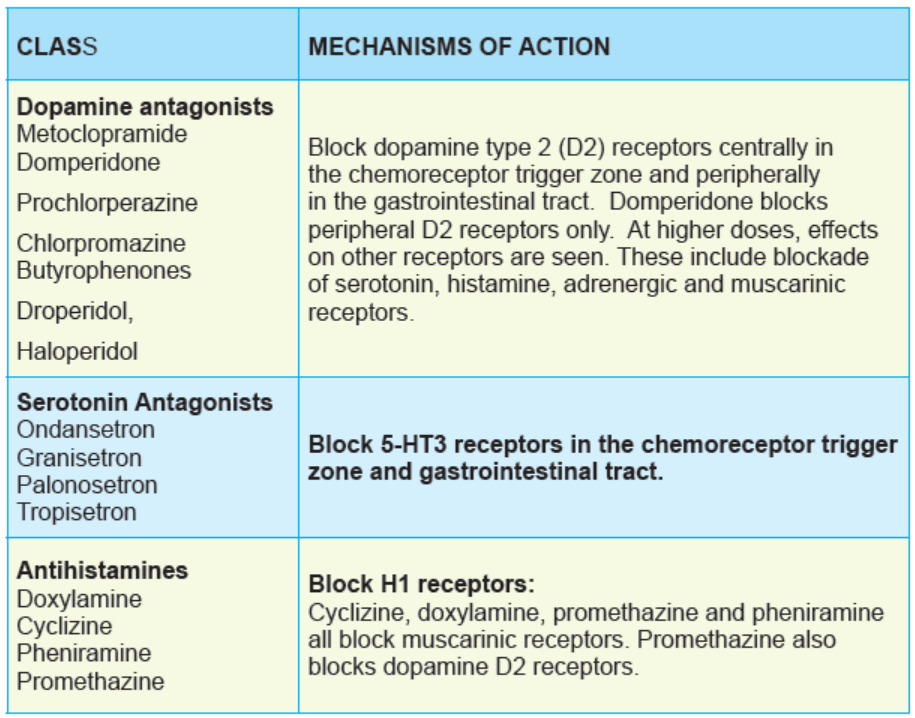
Tables 2. 6. 2. Summary of Serotonin (5-HT3) blockers:
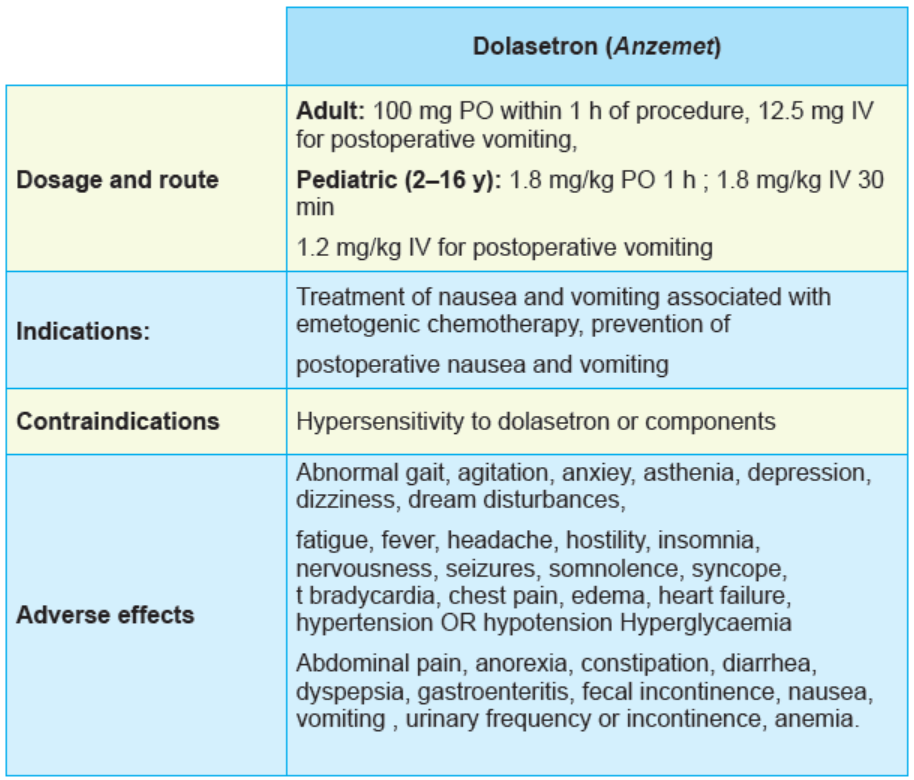
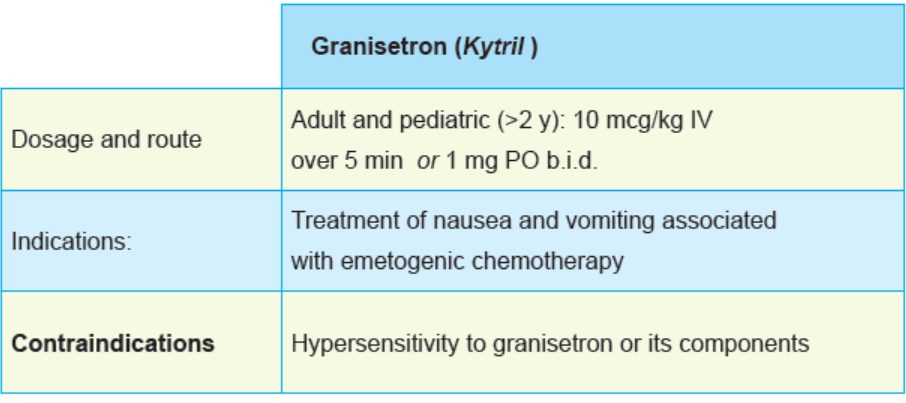

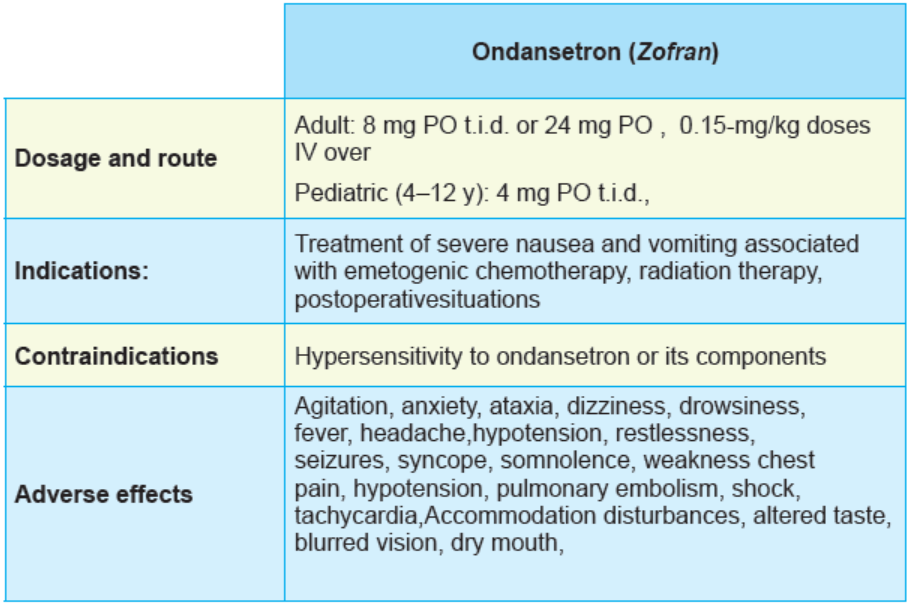
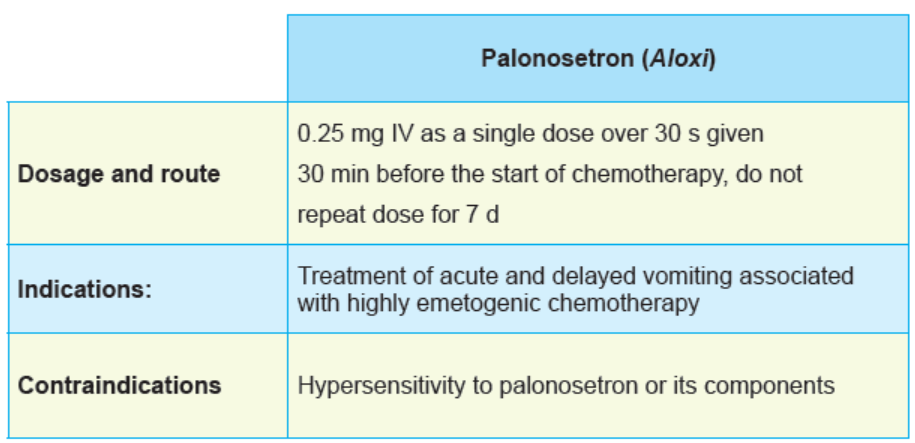

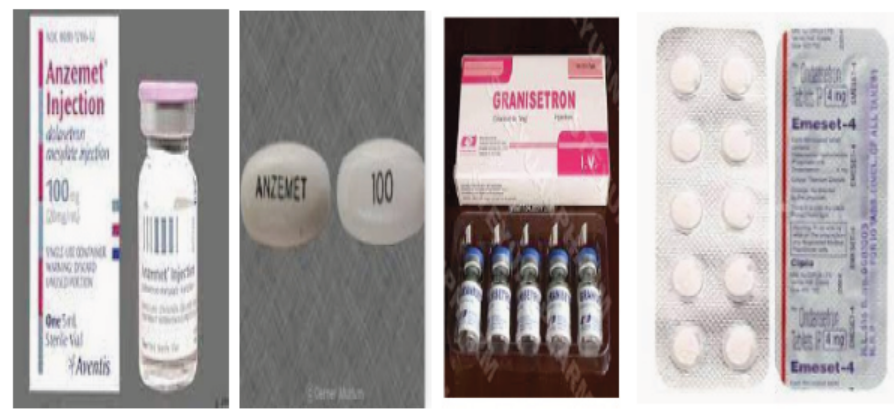
Figure 2.6.1 Serotonin (5-HT3) blockers forms
Tables 2. 6. 3. Summary of Dopamine antagonists:
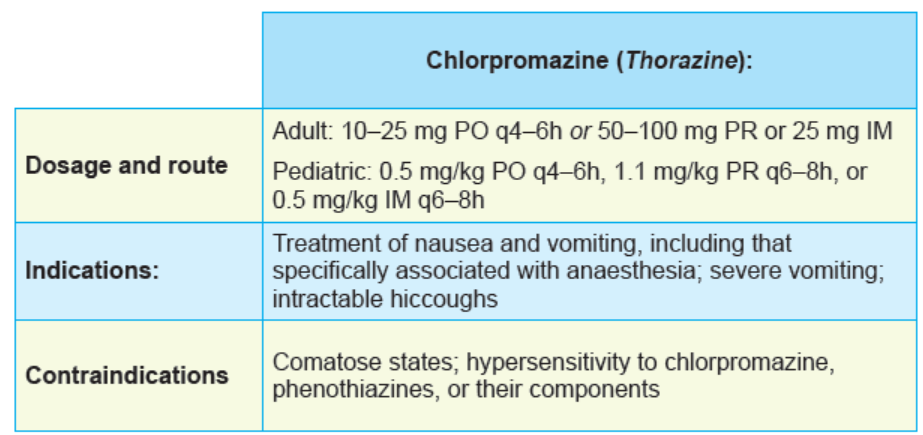

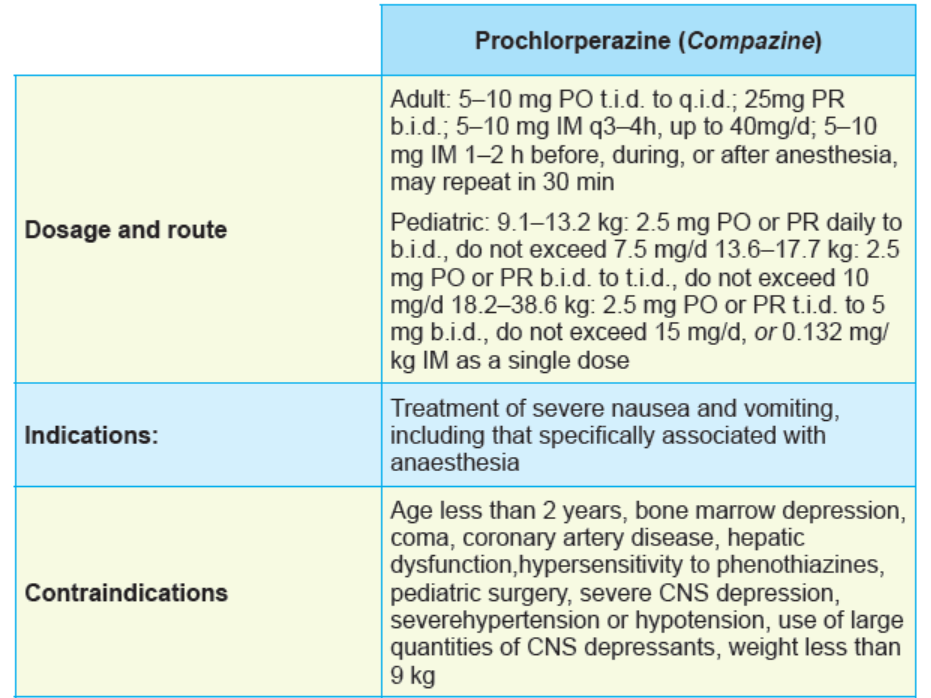
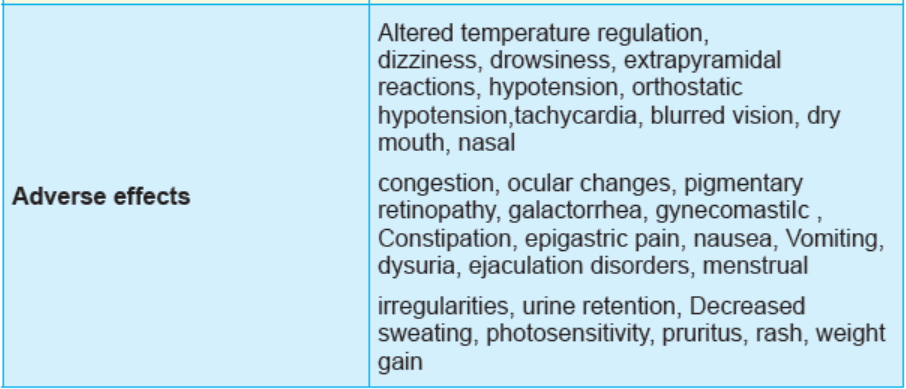
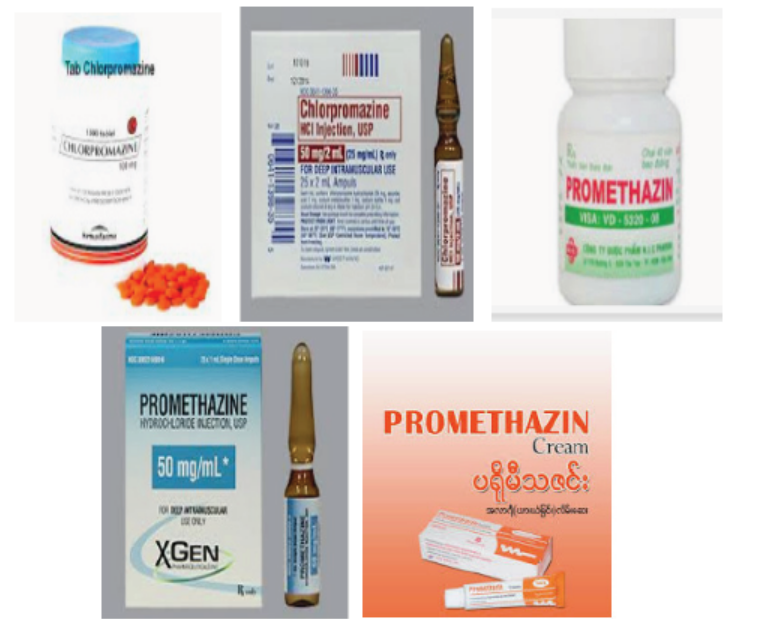
Figure 2.6.1: Dopamine antagonists
Table 2. 7. Anticholinergics/antihistamine antiemetics:
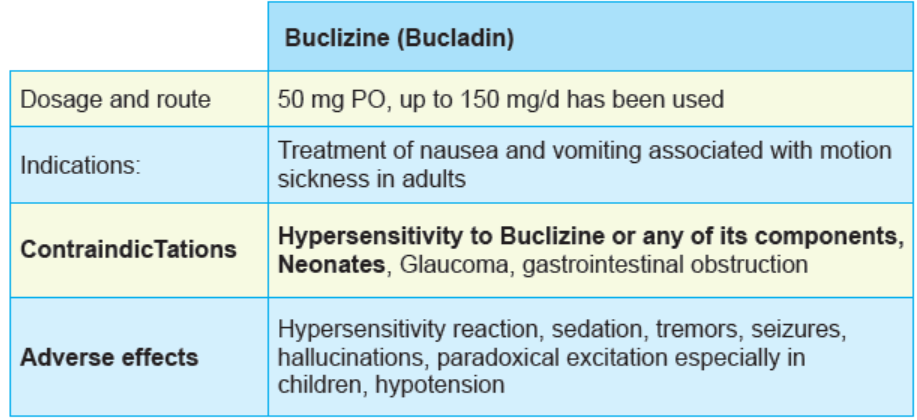
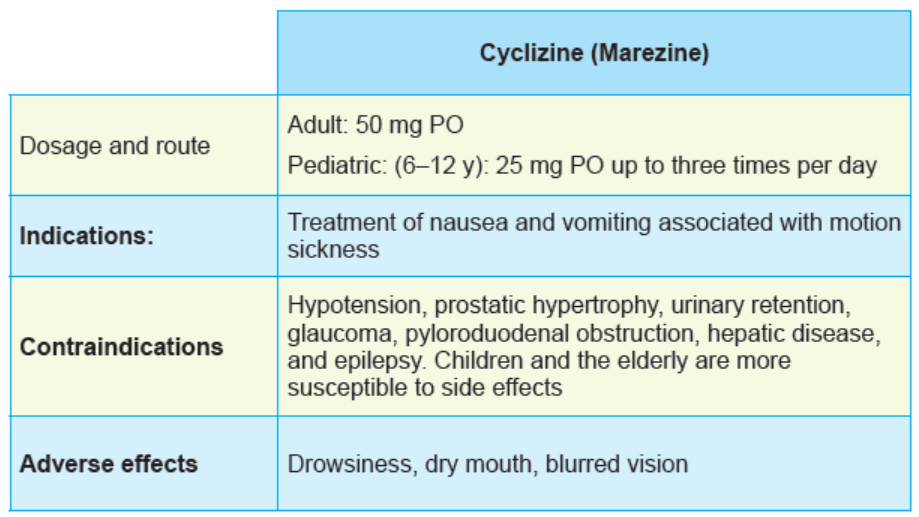
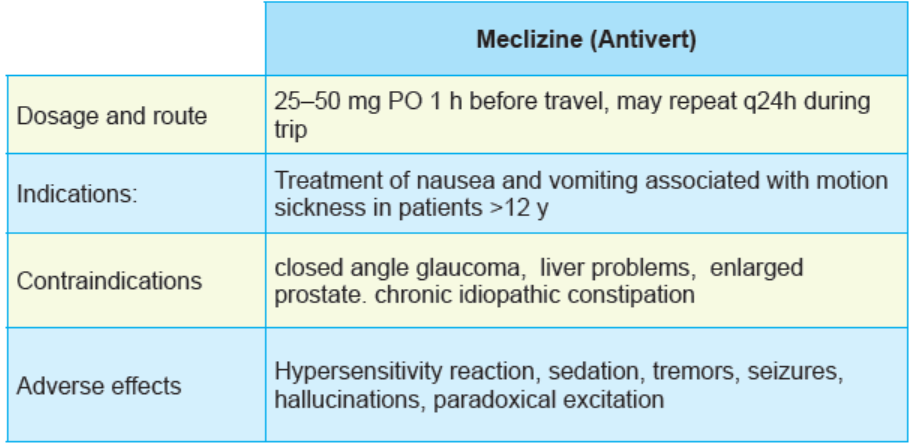
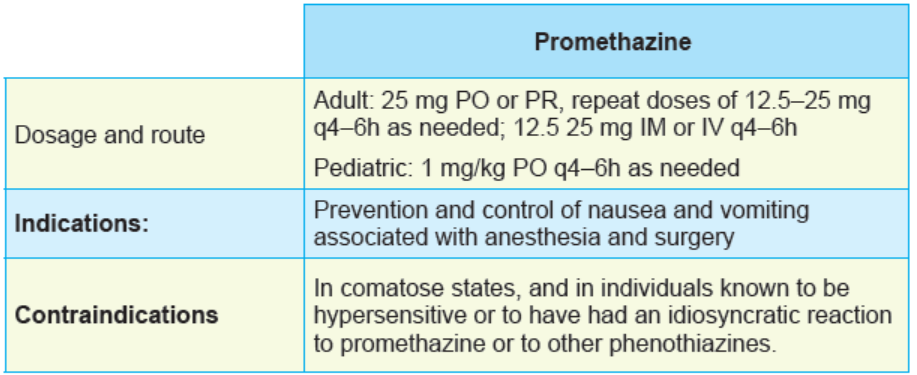
Self assessment 2.6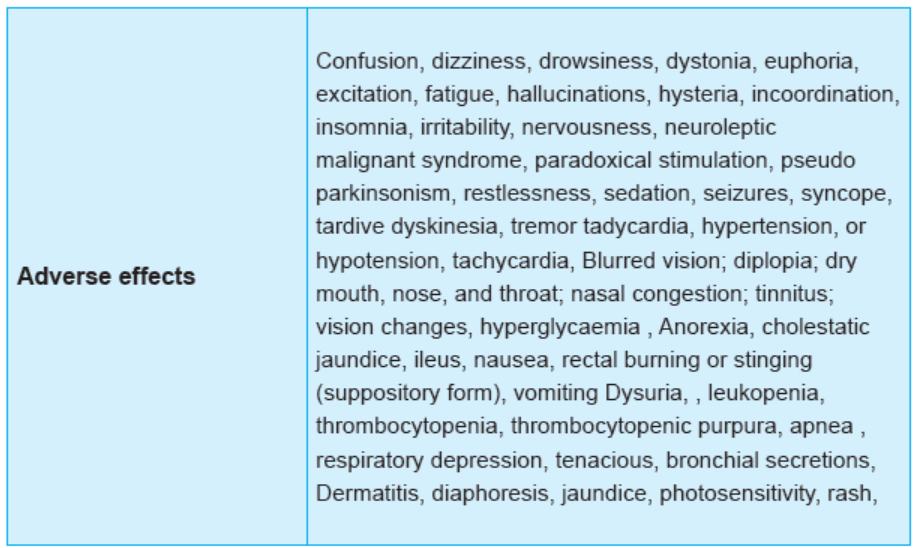
1. Which of the following antiemetic drugs is classified in antihistamine
antiemetics?
A. Promethazine
B. Chlorpromazine
C. Ondansetron
D. Metoclopramide
2. Which of the following antiemetic drugs is classified in serotonin (5-HT3)
blockers?
A. Promethazine
B. Chlorpromazine
C. Ondansetron
D. Metoclopramide
3. State the contraindications of chlorpromazine.
2.7. Laxative drugs
Learning Activity 2.7
As an associate nurse student in the clinical attachment, you receive a patient
complaining of difficulty passing stool. In your assessment, you realize that
the patient usually has a sedentary life and drinks fluids less frequently. You
diagnose the condition to be constipation, and you wish to administer drugs that
increase bowel movements.
1. How do we call a broad class of medications that increase bowel movements
such as in case of constipation?
2. List the categories of drugs used to treat constipation, and give one examplefor reach category.
CONTENT SUMMARY
Laxatives are drugs that promote bowel movements. Laxatives promote the
evacuation of the bowel, or defecation, and are widely used to prevent and treat
constipation. Indications for laxative include either the prophylaxis of constipation
or treatment of chronic constipation. Prophylactic laxative pharmacotherapy is
appropriate following abdominal surgeries. Such treatment reduces straining or
bearing down during defecation a situation that has the potential to precipitate
increased intra-abdominal, intraocular, or blood pressure. Prophylactic laxative
therapy may be initiated in pregnant women, patients and iron supplements are
just some of the medications that promote constipation. Foods that can cause
constipation include alcoholic beverages, products with a high content of refinedwhite flour, dairy products, and chocolate.
In addition, certain diseases such as hypothyroidism, diabetes, and irritable bowel
syndrome (IBS) can cause constipation. The normal frequency of bowel movements
varies widely among individuals, from two to three per day, to as few as one per
week. Constipation occurs more frequently in older adults, because faecal transit
time through the colon slows with aging; this population also exercises less and has
a higher frequency of chronic disorders that cause constipation.
All patients should understand that variations in frequency are normal, and that a
daily bowel movement is not a requirement for good health. Occasional constipation
is self-limiting and does not require drug therapy. Lifestyle modifications that
incorporate increased dietary fibers, fluid intake, and physical activity should beconsidered before drugs are used for constipation.
Chronic, infrequent, and painful bowel movements, accompanied by severe
straining, may justify initiation of treatment. In its most severe form, constipation
can lead to a fecal impaction and complete obstruction of the bowel for people who
are unable to exercise, or patients who are taking drugs that are known to causeconstipation.
The most common use for laxatives is to treat simple, chronic constipation.
Occasionally, laxatives are administered to accelerate the movement of ingested
toxins following poisoning or to remove dead parasites in the intestinal tract following
anthelminthic therapy. In addition, laxatives are often given to cleanse the bowel
prior to diagnostic or surgical procedures of the colon or genitourinary tract. Themain classes are chemical stimulants, bulk stimulants and lubricants.
CHEMICAL STIMULANT LAXATIVES
These are a group of medications that stimulate the normal gastrointestinal reflexes
by chemically irritating the lining of the gastrointestinal wall, leading to increasing
of its activity. The drugs found in this group are bisacodyl (Dulcolax), cascara
(generic), castor oil (Neoloid), and senna (Senokot). Castor oil is used when a
thorough evacuation of the intestine is desirable. All of these agents begin working
at the beginning of the small intestine and increase motility throughout the rest of the
GI tract by irritating the nerve plexus. Because castor oil blocks absorption of fats
(including fat-soluble vitamins) and may lead to constipation from GI tract exhaustion
when there is no stimulus to movement, its frequent use is not desirable. Bisacodyl
acts in a similar manner but is somewhat milder in effect; it can also be given in a
water enema to stimulate the activity in the lower GI tract. Cascara is somewhat
milder than castor oil and is often used when effects are needed overnight. Sennais available orally in tablet and syrup form and as a rectal suppository.
Most of these agents are only minimally absorbed and exert their therapeutic effect
directly in the GI tract. Changes in absorption, water balance, and electrolytes
resulting from GI changes can have adverse effects on patients with underlying
medical conditions that are affected by volume and electrolyte changes. Castor oil
has an onset of action in 2 to 6 hours; the remaining chemical stimulants have an
onset of action of 6 to 8 hours, making them preferable if one wants the drug to
work overnight and see effects in the morning.
Laxatives are contraindicated with allergy to any component of the drug to prevent
hypersensitivity reactions and in acute abdominal disorders, including appendicitis,
diverticulitis, and ulcerative colitis, when increased motility could lead to rupture or
further exacerbation of the inflammation. Laxatives should be used with caution in
heart block, coronary artery disease (CAD), or debilitation, which could be affected
by the decrease in absorption and changes in electrolyte levels that can occurand with great caution during pregnancy and lactation because, in some cases,
stimulation of the GI tract can precipitate labor and many of these agents cross theplacenta and are excreted in breast milk.
The adverse effects most commonly associated with laxatives are GI effects such
as diarrhea, abdominal cramping, and nausea. Central nervous system (CNS)
effects, including dizziness, headache, and weakness, are not uncommon and may
relate to loss of fluid and electrolyte imbalances that may accompany laxative use.
Sweating, palpitations, flushing, and even fainting have been reported after laxative
use. These effects may be related to a sympathetic stress reaction to intenseneurostimulation of the GI tract or to the loss of fluid and electrolyte imbalance.
A very common adverse effect that is seen with frequent laxative use or laxative
abuse is cathartic dependence. This reaction occurs when patients use laxatives
over a long period of time and the GI tract becomes dependent on the vigorous
stimulation of the laxative. Without this stimulation, the GI tract does not move for a
period of time which could lead to constipation and drying of the stool and ultimately
to impaction. Specifically related to chemical stimulants, cascara, although a
reliable agent, may have a slow, steady effect or may cause severe cramping and
rapid evacuation of the contents of the large intestine. Castor oil blocks absorption
of fats (including fat-soluble vitamins) and may lead to constipation from GI tractexhaustion when there is no stimulus to movement.
Interactions: because laxatives increase the motility of the GI tract and some
interfere with the timing or process of absorption, it is advisable not to take laxatives
with other prescribed medications. The administration of laxatives and othermedications should be separated by at least 30 minutes.
Tables 2. 7.1: Chemical stimulant laxatives
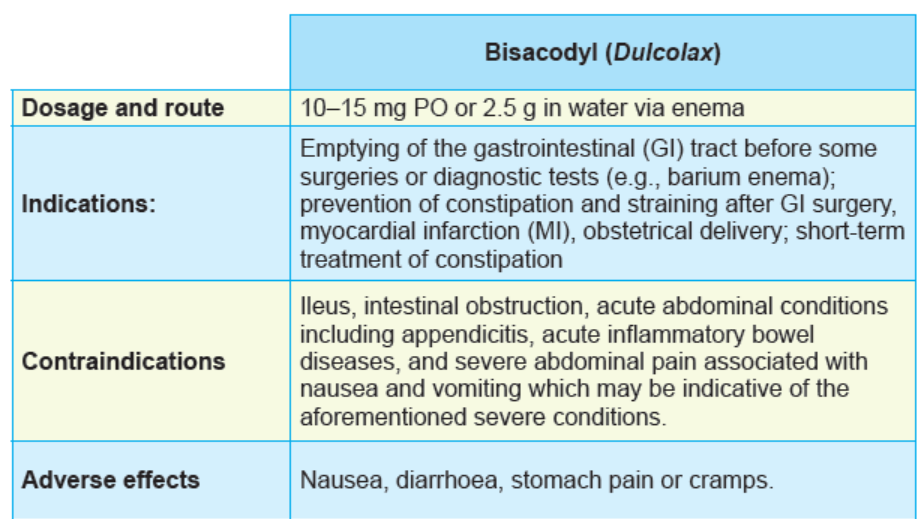
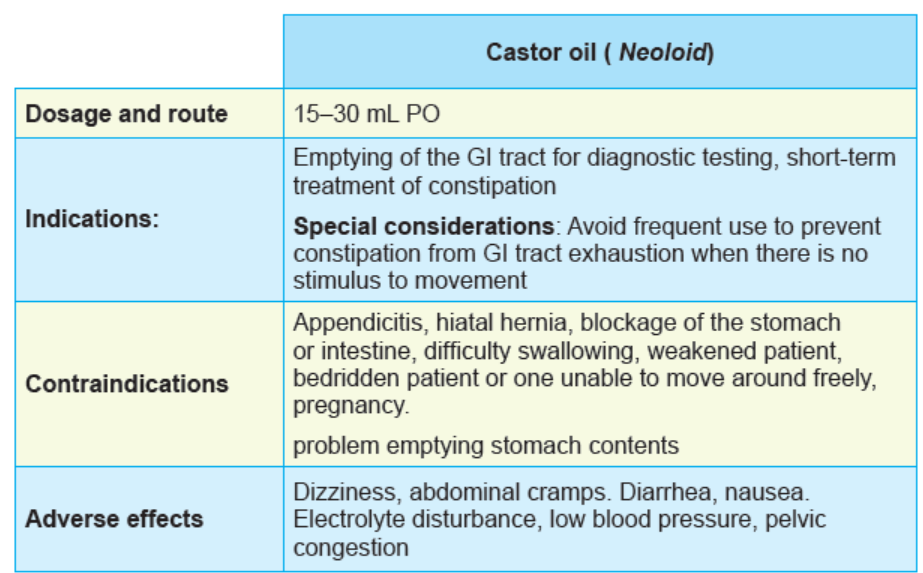
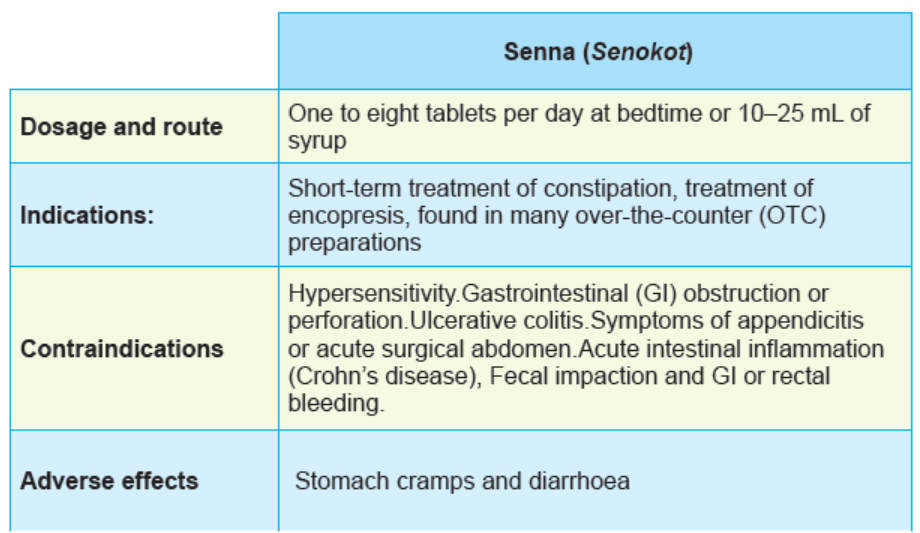
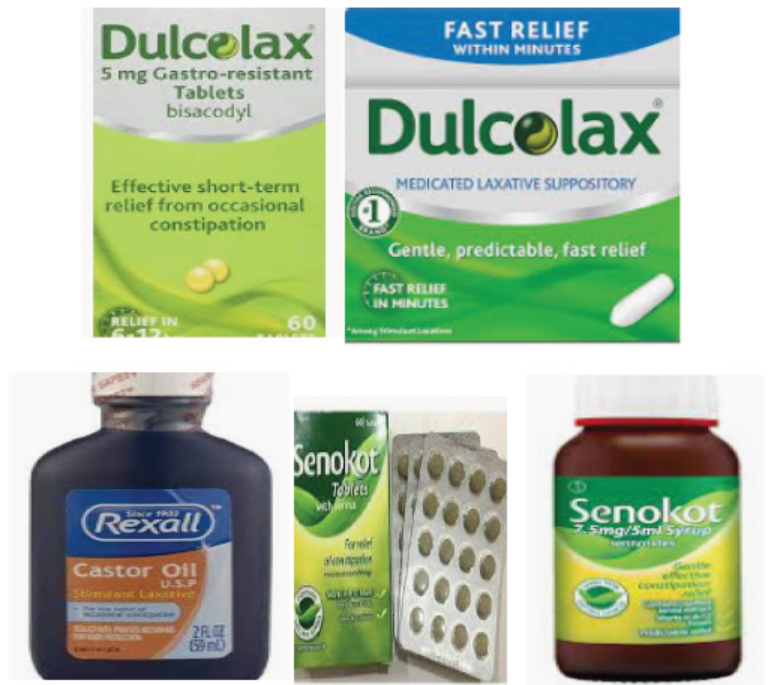
Figure 2.7. 1: Forms of chemical stimulant laxative
BULK STIMULANT LAXATIVES
Bulk stimulant laxatives increase the bulk by osmotic pull of fluid into the feces.
That increase the increased bulk stretches the gastro-intestinal wall, leading to
the stimulation and increased GI movement. The bulk stimulants are also called
mechanical stimulants. The commonly used bulk stimulants include magnesium
sulfate (Epsom salts), magnesium citrate (Citrate of Magnesia), magnesium
hydroxide (Milk of Magnesia), lactulose (Chronulac), polycarbophil (FiberCon),
psyllium (Metamucil), and polyethylene glycol-electrolyte solution (GoLYTELY,MiraLAX).
Therapeutic action
Lactulose is a saltless osmotic laxative that pulls fluid out of the venous system
and into the lumen of the small intestine. Magnesium citrate is a milder and sloweracting
laxative. It works by a saline pull, bringing fluids into the lumen of the GI tract.
Magnesium hydroxide is a milder and slower-acting laxative. It also works by a
saline pull, bringing fluids into the lumen of the GI tract. Magnesium sulfate acts by
exerting a hypertonic pull against the mucosal wall, drawing fluid into the intestinalcontents.
Polycarbophil is a natural substance that forms a gelatin-like bulk out of the
intestinal contents. This agent stimulates local activity. It is considered milder and
less irritating than many other bulk stimulants. Patients must use caution and take
polycarbophil with plenty of water. Polyethylene glycol-electrolyte solution is a
hypertonic fluid containing many electrolytes that pulls fluid out of the intestinal wallto increase the bulk of the intestinal contents.
Psyllium, another gelatin-like bulk stimulant, is similar to polycarbophil in action
and effect
These drugs are all taken orally. They are directly effective within the GI tract and
are not generally absorbed systemically. They are rapidly acting, causing effects asthey pass through the GI tract.
Bulk laxatives are contraindicated with allergy to any component of the drug
to prevent hypersensitivity reactions and in acute abdominal disorders, like
appendicitis, diverticulitis, and ulcerative colitis, when increased motility could leadto rupture or further exacerbation of the inflammation.
Laxatives should be used with caution in heart block, CAD and debilitation, which
could be affected by the decrease in absorption and changes in electrolyte levelsthat can occur.
They are used with great caution during pregnancy and lactation because, in some
cases, stimulation of the GI tract can precipitate labor and many of these agentscross the placenta and are excreted in breast milk.
Polyethylene glycol electrolyte solution should be used with caution in any patient
with a history of seizures because of the risk of electrolyte absorption causingneuronal instability and precipitating seizures.
The most common adverse effects most commonly associated with bulk laxatives
are GI effects such as diarrhea, abdominal cramping, and nausea CNS effects,
including dizziness, headache, and weakness, are not uncommon and may relate
to loss of fluid and electrolyte imbalances that may accompany laxative use,palpitations, flushing, and even fainting
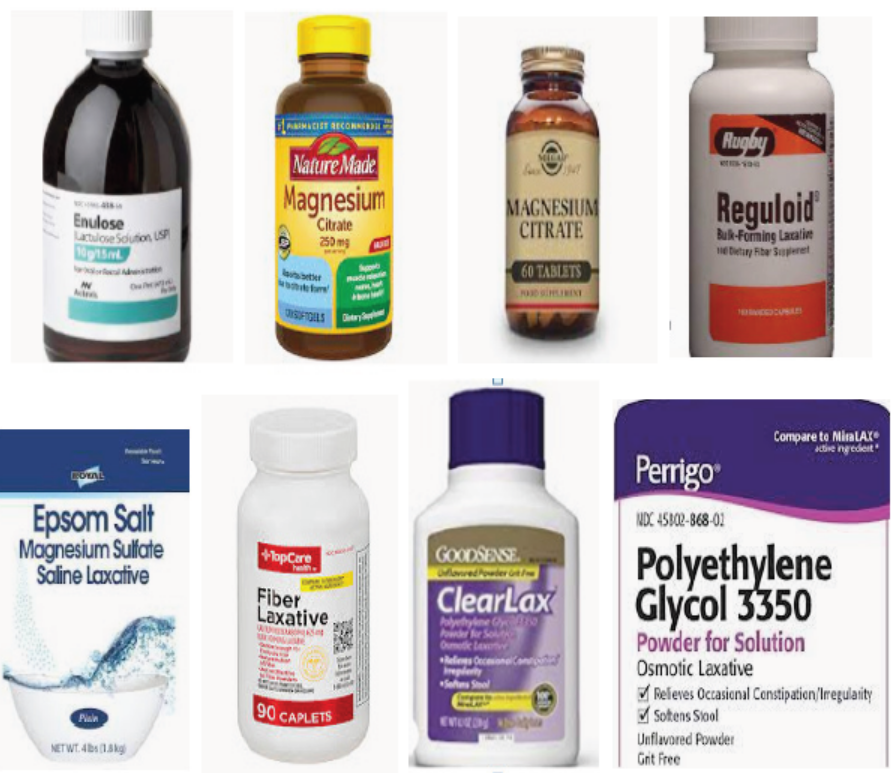
Figure 2.7.2 Forms of bulk laxatives
TABLE 2.7.2 BULK LAXATIVES DRUGS:
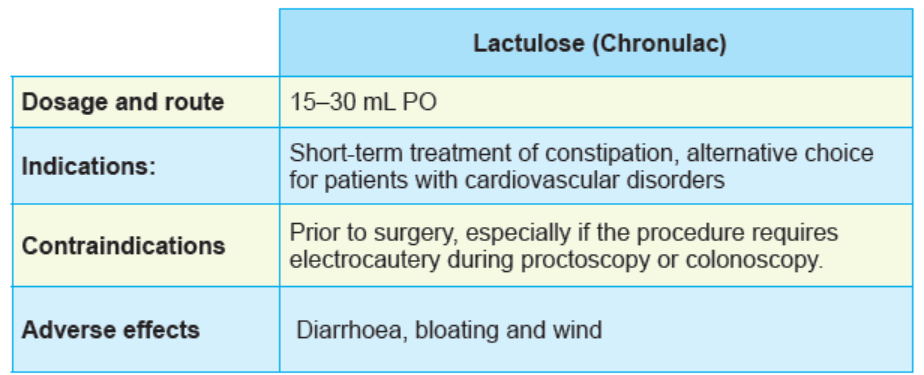
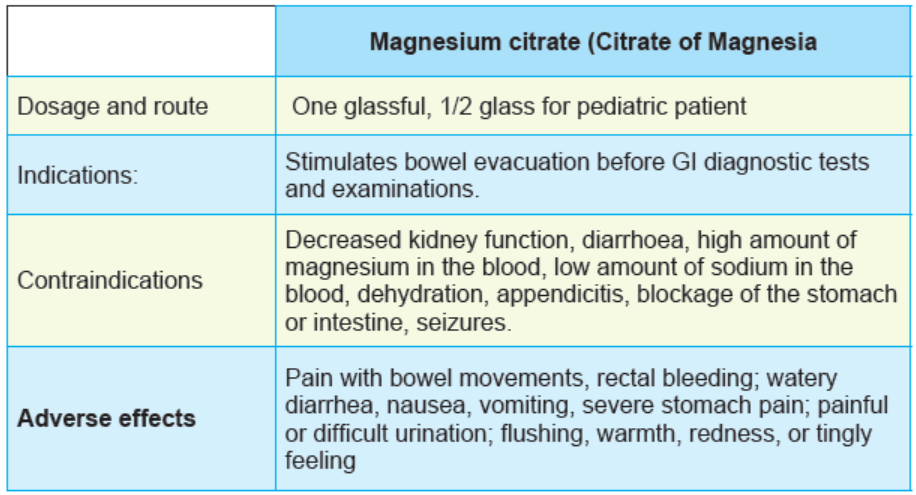
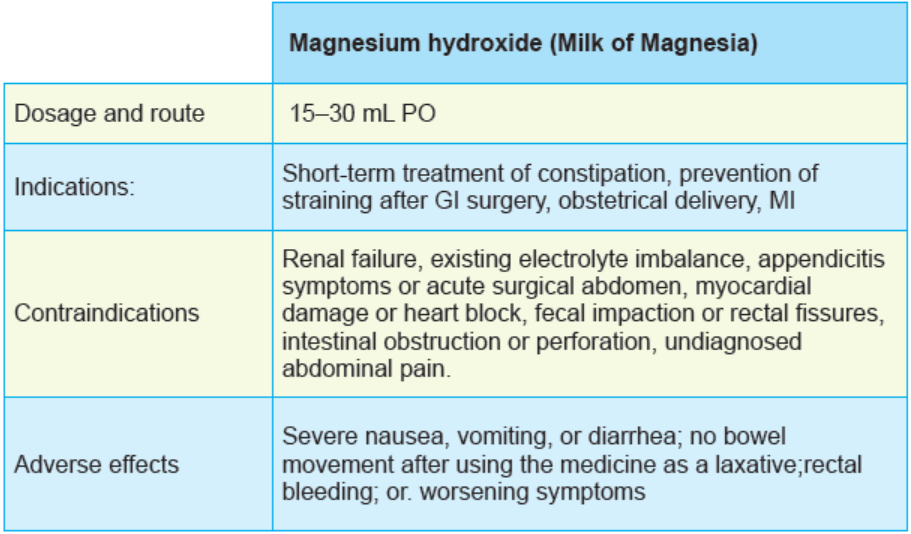
LUBRICANT DRUGS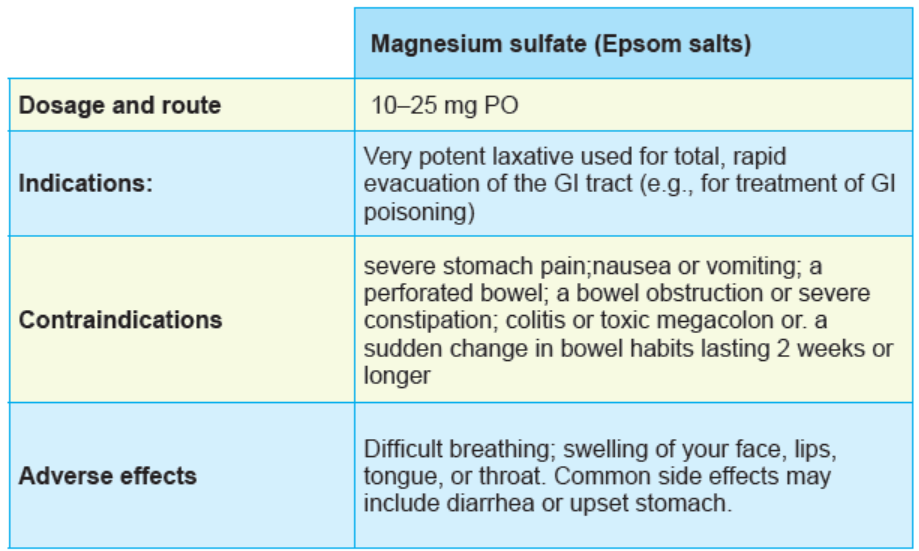
For some persons, there may be a need to make defecation easier without using
drugs designed to stimulate the gastrointestinal tract, in this case they benefit
from lubricants usage. Patients with hemorrhoids and those who have recently
had rectal surgery may need lubrication of the stool. Some patients who could be
harmed by straining might also benefit from this type of laxative. The type of laxative
recommended depends on the condition of the patient, the speed of relief needed,
and the possible implication of various adverse effects. Lubricating laxatives include
docusate (Colace), glycerin (Sani-Supp), and mineral oil (Agoral Plain).
Therapeutic actions
Docusate has a detergent action on the surface of the intestinal bolus, increasing
the admixture of fat and water and making a softer stool. Glycerin is a hyperosmolar
laxative that is used in suppository form to gently evacuate the rectum without
systemic effects higher in the GI tract.
Mineral oil is the oldest of these laxatives. It is not absorbed and forms a slippery
coat on the contents of the intestinal tract. When the intestinal bolus is coated
with mineral oil, less water is absorbed out of the bolus, and the bolus is less
likely to become hard or impacted. These drugs are not absorbed systemically and
are excreted in the feces. Docusate and mineral oil are given orally. Glycerin isavailable as a rectal suppository or as a liquid for rectal retention.
These laxatives are contraindicated with allergy to any component of the drug
to prevent hypersensitivity reactions and in acute abdominal disorders, including
appendicitis, diverticulitis, and ulcerative colitis, when increased motility could leadto rupture or further exacerbation of the inflammation.
The adverse effects most commonly associated with lubricant laxatives are GI
effects such as diarrhea, abdominal cramping, and nausea. In addition, leakage
and staining may be a problem when mineral oil is used and the stool cannot be
retained by the external sphincter. CNS effects, including dizziness, headache,
and weakness, are not uncommon and may relate to loss of fluid and electrolyte
imbalances that may accompany laxative use. Sweating, palpitations, flushing, and
even fainting have been reported after laxative use. These effects are less likely to
happen with the lubricant laxatives than with the chemical or mechanical stimulants.
Frequent use of mineral oil can interfere with absorption of the fat-soluble vitaminsA, D, E, and K.
Tables 2.9. Lubricant laxatives:
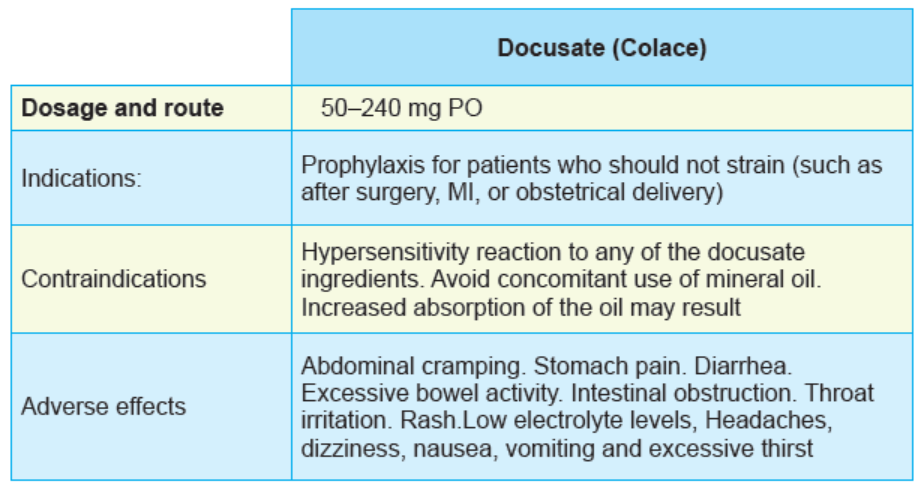
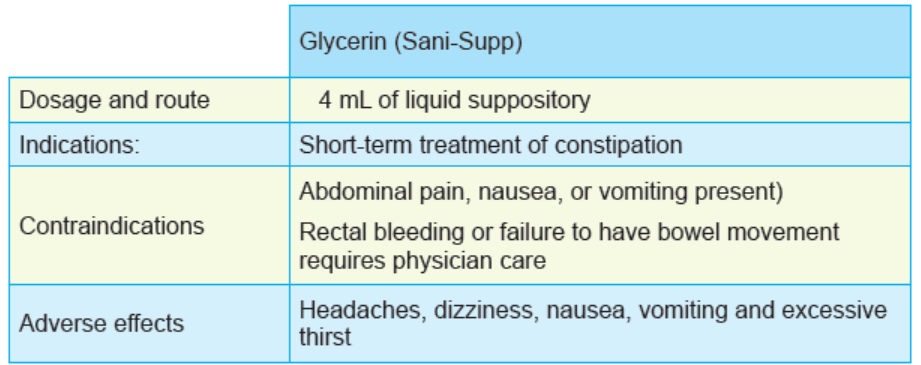
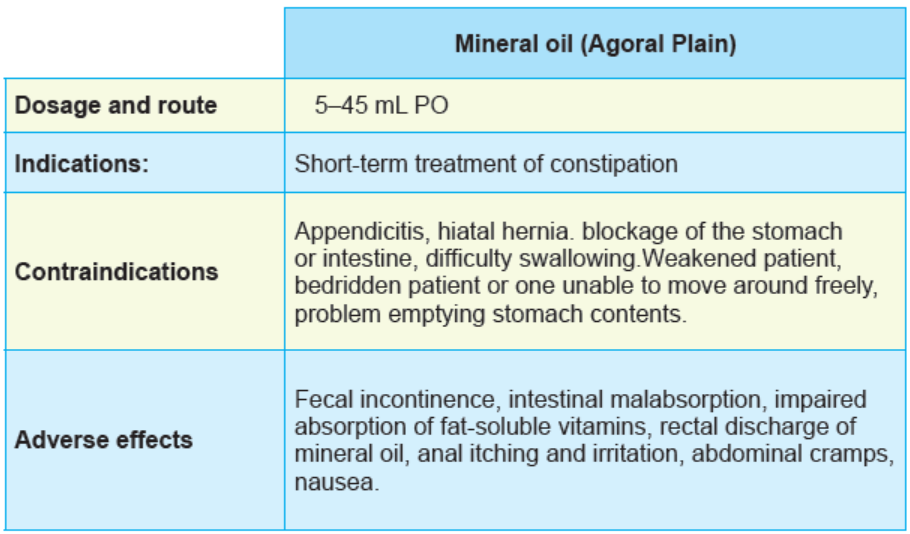
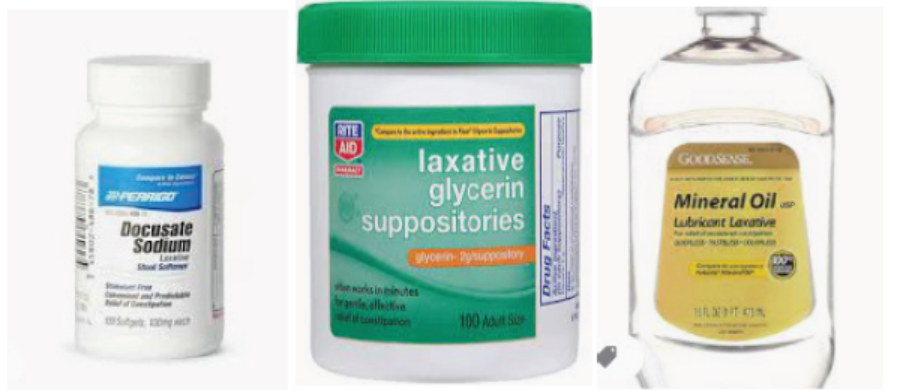
Figure 2.7.2 Forms of lubricant laxatives
Self assessment 2.7
1. All of the following drugs are bulk laxatives, EXCEPT:
A. Polycarbophil
B. Glycerin
C. Lactulose
D. Magnesium hydroxide
2. Which of the following drugs is a lubricant laxative?
A. Bisacodyl
B. Lactulose
C. Mineral oil
D. Magnesium hydroxide
3. All of the following conditions are indications of laxatives, EXCEPT:
A. To treat simple, chronic constipation.
B. To accelerate the movement of ingested
C. Before diagnostic procedures of the colon
D. To treat mild to moderate diarrhea
4. Explain the mechanism of action of bulk laxatives.5. Explain the mechanism of action of chemical stimulant laxatives.
2.8. Body fluid compartments
Learning Activity 2.8
On your first day of clinical practice in a hospital you find Mr.MN a 34 year-old
male patient who has been hospitalized since yesterday. In the file you find that
on the prescription that the patient must be given intravenous fluids, namely
ringer lactate and normal saline 4l/24hrs in alternation, with close monitoring of
vital signs. The nurse working at that health facility is explaining the mechanism
of action of intravenous fluids, and factors to consider while prescribing the
fluids. After 2 days, one of your colleagues wants you to remind the content you
covered with the nurse in that teaching session. Answer the following questionsrelated to the fluids in order to help your colleague:
1. What are the 3 key factors in the movement of fluids?
2. What are the 4 components of extracellular fluid?
3. Which of the following statements are the 2 main compartments of fluids
in the body?
A. Extracellular fluid and interstitial fluid compartments
B. Intracellular fluid and extracellular fluid compartments
C. Intracellular fluid and interstitial fluid compartmentsD. Transcellular fluid and interstitial fluid compartments
CONTENT SUMMARY
In human body, the fluids travel between compartments that are separated by
semipermeable membranes. Control of water balance in the various compartments
is indispensable to homeostasis. The imbalances of body fluids are frequent and
require the treatment most of the times using drugs.
The body fluids are mostly consisted with water, which serves as the universal
solvent in which most nutrients, electrolytes, and minerals are dissolved. Water
alone is responsible for about 60% of the total body weight in a middle- age adult.
A new-born may contain approximately 80% water, whereas an older adult may
contain only 40%.
In a simple model, water in the body can be located in one of two places, or
compartments. The intracellular fluid (ICF) compartment, which contains water that
is inside cells, accounts for about two thirds of the total body water.
The remaining one third of body fluid resides outside cells in the extracellular fluid
(ECF) compartment. The ECF compartment is further divided into two parts: fluid inthe plasma, or intravascular space, and fluid in the interstitial spaces between cells.
The extracellular fluid is divided into:
1. Plasma
2. Interstitial fluid and lymph
3. Bone and dense connective tissue water
4. Transcellular (cerebrospinal, pleural, peritoneal, synovial, and digestive
secretions)
The plasma and interstitial fluids are the two most important because of constant
exchange of fluid and electrolytes between them. Plasma and interstitial fluid are
separated by the capillary endothelium. Plasma circulates in the blood vessels,whereas the interstitial fluid bathes all tissue cells except for the formed elements
of blood. For this reason, Claude Bernard, the French physiologist, called the
interstitium “the true environment of the body”. For fluids movement, the osmolality,
tonicity and osmolarity are key. The osmolality is a fluid is a measure of the number
of dissolved particles, or solutes, in 1 kg (1 L) of water. In most body fluids sodium,
glucose, and urea, determine the osmolality. Sodium is the greatest contributor to
osmolality due to its abundance in most body fluids. The normal osmolality of body
fluids ranges from 275 to295 milli-osmols per kilogram (mOsm/kg). Tonicity is the
ability of a solution to cause a change in water movement across a membrane due
to osmotic forces. Whereas osmolality is a laboratory value that can be precisely
measured, tonicity is a general term used to describe the relative concentration ofIV fluids.
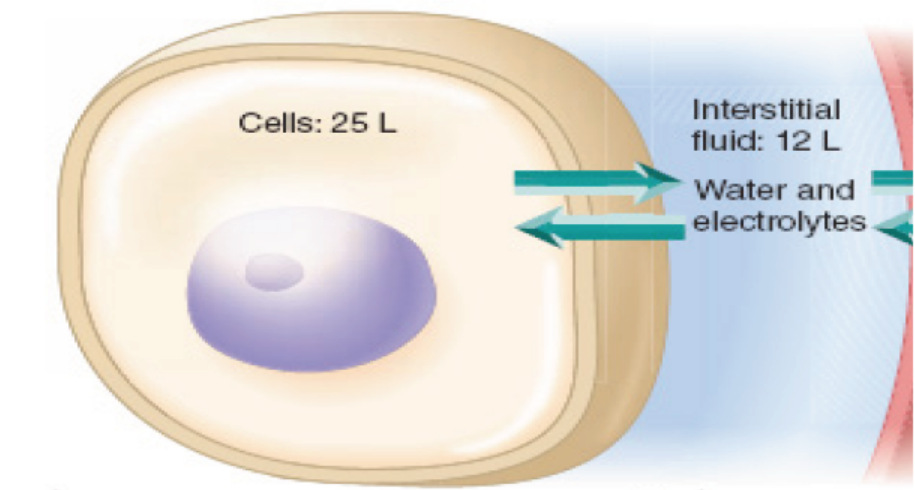
Figure 2.8.1. Fluid compartments
There is a continuous exchange and mixing of fluids between the various
compartments, which are separated by membranes. For example, the plasma
membranes of cells separate the intracellular fluid (ICF) from the extracellular
fluid (ECF). The capillary membranes separate plasma from the interstitial fluid.
Although water travels freely among the compartments, the movement of large
molecules and those with electrical charges is governed by processes of diffusion
and active transport. Movement of ions and drugs across membranes is a primary
concept of pharmacokinetics.
Normally there should be a balance between fluid input and output. When the
output is greater than fluid intake, body fluid deficit may result and the person has
dehydration, electrolytes imbalances and / or shock that may be fatal depending onthe severity.
Fluid requirements
In human, body fluid requirement varies according across the life span and its
calculation is based on weight and there is a need to adjust up or down based on
specific medical conditions.
In general, infants, children and adolescents have higher ml/kg requirement
than adults.Table 2.8.1: In adults, the fluid requirements are as follows:

Table 2.8.2.Fluid requirements in children
In pediatric population, fluid requirements are calculated considering the child
weight.
Self assessment 2.8
1. Which of the following statements indicates the fluid requirements in adults
aged 30 years and above?
A. 30-35ml/kg
B. 10-15 ml/kg
C. 5-10 ml/kgD. 3-5 ml/kg
2. Which of the following would be a basis to ideally calculate body fluid
requirements in humans?
A. Gender
B. Height
C. Weight
D. Race
3. Children and adolescents have higher ml/kg requirement than adults. TRUEor FALSE
2.9. Intravenous fluids and calculation of drop rate
Learning Activity 2.9
MM a 60 kg female was treated with ORS after a consultation for diarrhoea with
mild to moderate dehydration. After 24 hours ,you notice that she presents the
signs of severe dehydration and change in vital signs. You decide to administer
normal saline 500ml for 1hr as an intravenous infusion.
Using library textbooks and internet, discuss the following:
1. Discuss the classifications of intravenous fluids
2. List the indications of IV fluids and give an example for each class
3. Demonstrate how drop rate is calculated. How many drops of NS will run
per minute to make 500ml of NS to flow in 2hrs, with a drop factor of 20drops per mL?
CONTENT SUMMARY
In human, there must be a balance between fluid input and fluid output. The latter
should not exceed the intake, if this is the case then, there will be manifestations
of fluid volumes deficits if the opposite edema is the result. In general, fluid is
lost through gastrointestinal tract when a person vomits, has diarrhea, with chronic
laxative use, gastric suctioning but also with excessive sweating, athletic activity,
prolonged fever, severe burns, hemorrhage, excessive diuresis, complications of
diabetes like diabetic ketoacidosis etc.
In clinical practice, restoring and maintaining proper fluid volume, composition, and
distribution is a significant problem in the treatment of seriously ill patients andthose with or at risk of fluid and electrolytes imbalance. Nurses are in good position
for the intravenous fluid administration and monitoring. Fluids are administered to
refill total body water, restore blood volume and pressure and/or shift water from
one fluid compartment to another, restore and maintain electrolyte and acid–base
balance.
Classification of intravenous fluids
The IV fluids are classified considering the effect that they may cause to cells when
reach human body. According to their tonicity, intravenous fluids are classified as
isotonic, hypertonic and hypotonic.
Solutions that are isotonic have the same concentration of solutes (same
osmolality) as plasma. Hypertonic solutions contain a greater concentration of
solutes than plasma, whereas hypotonic solutions have a lesser concentration of
solutes than plasma. If hypertonic solution is administered, the plasma gains more
solutes than the interstitial fluid. Water will move, by osmosis, from the interstitial
fluid compartment to the plasma compartment. This type of fluid shift removes water
from cells and can result in dehydration. Water will move in the opposite direction,
from plasma to interstitial fluid, if a hypotonic solution is administered. This type of
fluid shift could result in hypotension due to movement of water out of the vascularsystem. Isotonic solutions will produce no net fluid shift.
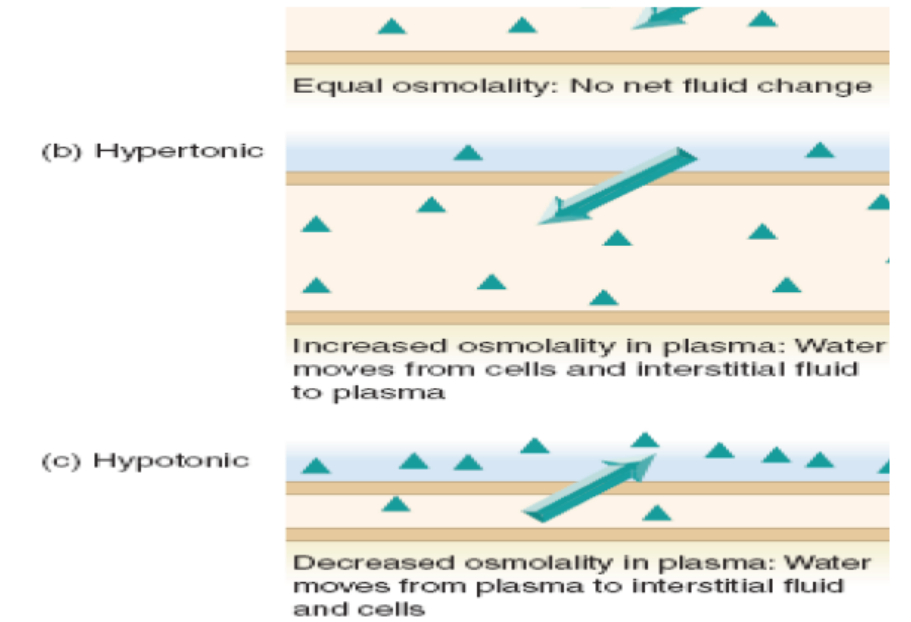
Figure 2.9.1: Movement of fluids
Another important classification considering the components of the IV fluid. There
are crystalloid and colloidal IV fluids.
Crystalloids are IV solutions that contain electrolytes and other substances that
closely mimic the body’s ECF. They are used to replace depleted fluids and to
promote urine output. Crystalloid solutions are capable of quickly diffusing across
membranes, leaving the plasma and entering the interstitial fluid and ICF. It is
estimated that two thirds of infused crystalloids will distribute in the interstitial space.Isotonic, hypotonic, and hypertonic solutions are available.
Table 2.9.1. CRYSTALLOID IV SOLUTIONSt
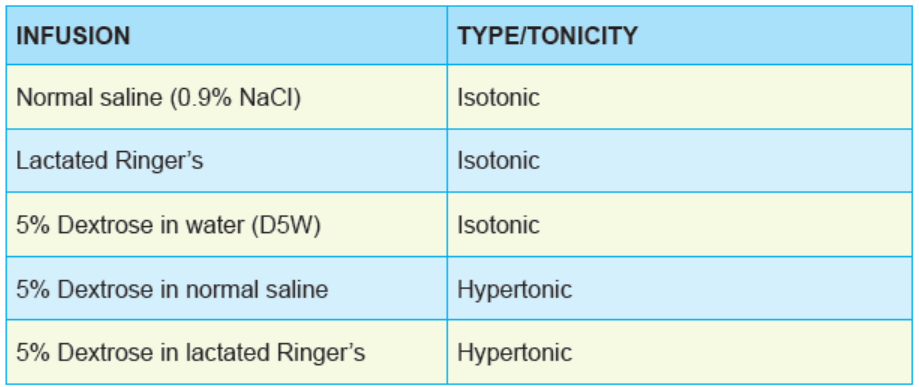
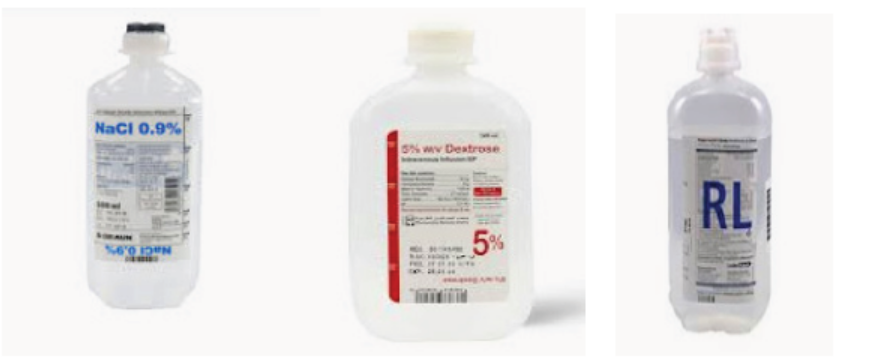
Figure 2.9.2 Crystalloids
Note: 5% of dextrose in water (D5W) is quickly metabolized, it is considered as
hypotonic solution.
COLLOIDS IV FLUID
Colloids contain large molecules like proteins that remain in the blood for a long
time because they are too large to easily cross the capillary membranes. When theyare circulating, they have the same effect as hypertonic solutions. They pull water
molecules from the cells and tissues into the plasma through their ability to increase
plasma osmolality and osmotic pressure. They are plasma volume expanders that
are used in treatment of hypovolemic shock due to burns, haemorrhage or aftersurgery.
Table 2.9.2. COLLOIDS IV FLUID
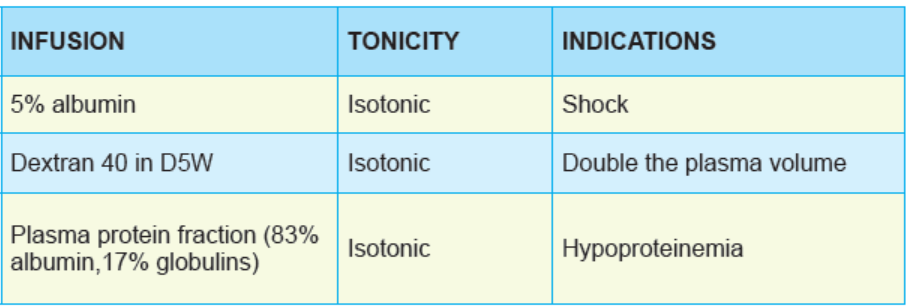
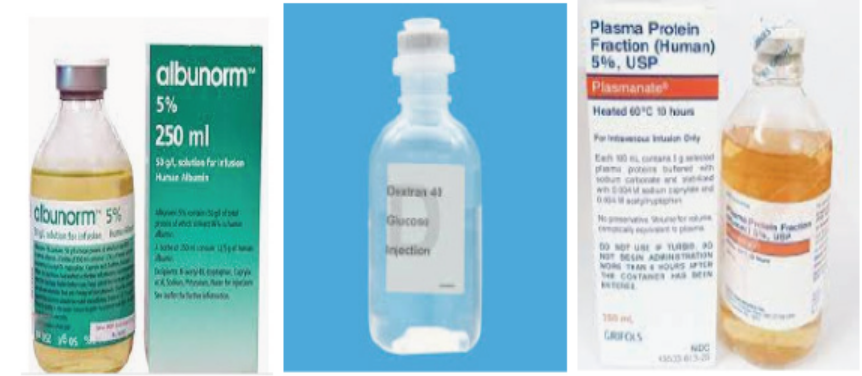
Figure 2.9.3: Colloids
DROP RATE CALCULATION
In all health facilities across health care system, many different types of medications
are delivered as continuous IV infusions in acute, ambulatory, long-term and critical
care settings. With poor attention before during even after IV drug medications,
Medication error arise. These errors, which may be having serious negative
consequences, can be eliminated or kept to a minimum by knowing the standard to
medication errors. The drop rate calculation is very important for all continuous or
intermittent IV infusion Continuous IV infusions are often used when the medication
needs to be greatly diluted, the drug level in the blood must be tightly controlled, or
large volumes of fluids need to be infused.The drop rate calculation requires to have the following information
1. Amount of infusion/medication to be given(volume)
2. Ordered dose
3. Time or length of administration in minutes
4. Drop factor: the number of the drops in the iv chamber that is equivalent to 1mlHaving all this information the drop rate or flow rate is calculated as follow:
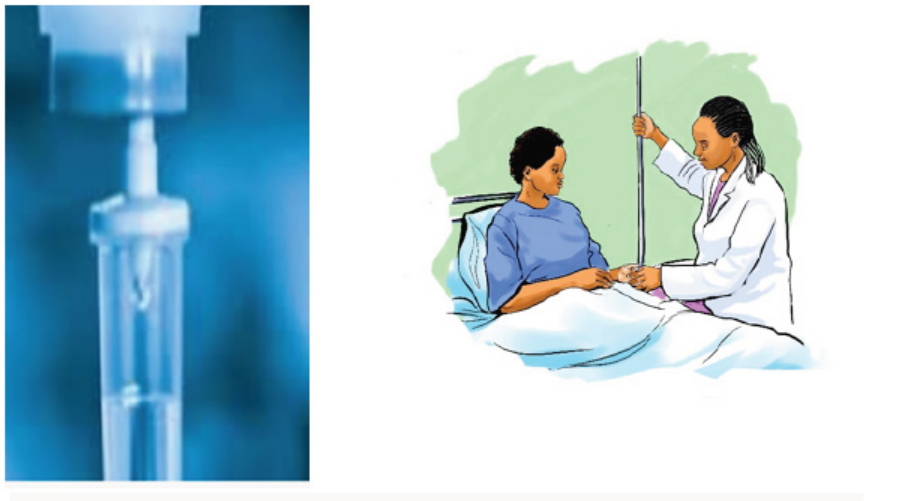
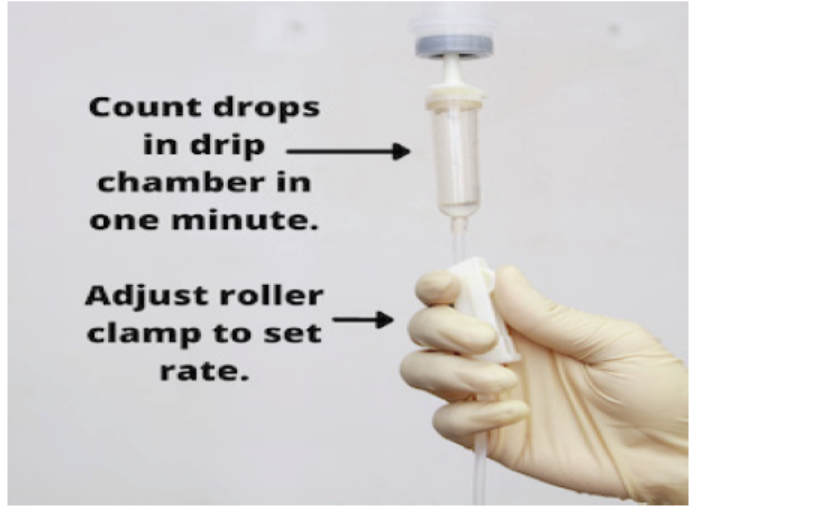
For IV infusion, tubing varies in size. The macrodrip tubing delivers 10 to 20 gtts/
mL and is used to infuse large volumes or to infuse fluids quickly. Microdrip tubing
delivers 60 gtts/mL and is used for small or very precise amounts of fluid, as with
neonates or pediatric patients. In general, the drop factor is considered as 20 but
may change depending on the manufacturer of the infusion set. Before administeringIV fluid a nurse must verify it on the available set.
If you simply need to figure out the mL per hour to infuse, take the total volume inmL, divided by the total time in hours, to equal the mL per hour.
An IV drip rate is a way of describing the rate of an intravenous infusion based on
the number of drops (gtt) that are administered to the patient per minute. This is
influenced by the type of the tubing (microdrip or macrodrip), the total volume that
is required to be infused, and the time over which the infusion is ordered to run.
An IV drop factor reflects the specific size of the drops of IV fluid that the tubing
set creates. This is a predetermined number based on the tubing required andavailable to administer the medication
NURSING CONSIDERATONS FOR IV INFUSIONS ADMINISTRATION
1. Assess baseline assessment prior to administration:
• It is the responsibility of a nurse to take a complete health history prior to
IV fluid administration. This may include but not limited to cardiovascular
conditions like hypertension, neurologic conditions, and endocrine, hepatic,
renal….
• Also obtain a drug history including allergies, current prescription and overthe-
counter (OTC) drugs, and herbal preparations.
• Obtain baseline weight and vital signs, level of consciousness (LOC), breath
sounds, and urinary output as appropriate.
• Evaluate appropriate laboratory findings like electrolytes, full blood count, if
possible, urine specific gravity and urinalysis, blood urea nitrogen [BUN] and
creatinine, total protein and albumin levels, renal and liver function studies
• Assess for desired therapeutic effect
• Double check doses with another nurse before giving any IV fluids.
2. After administration, a nurse should continue the monitoring
• Continue frequent assessments for therapeutic effects.
• Monitoring of vital signs, urinary output, and the level of consciousness.
• Assess for and promptly report adverse effects: tachycardia, HTN,
dysrhythmias, decreasing LOC, increasing dyspnea, lung congestion,
decreased urinary output, muscle weakness or cramping, or allergic reactions.
• Monitor for signs of fluid volume excess or deficit like increasing or decreasing
BP , tachycardia, changes in quality of pulse
• Monitor for signs of potential electrolyte imbalance including nausea,
vomiting, GI cramping, diarrhea, muscle weakness, cramping or twitching,
paresthesias, and irritability.
• Weigh the patient daily and report a weight gain or loss of 1 kg ormore in a
24-hour period
• Assist the patient with obtaining fluids and with eating as needed.
• Closely monitor for signs and symptoms of allergy if colloids are used.
• Closely monitor IV sites when infusing potassium or ammonium.
• Monitor nutritional status and encourage appropriate fluid intake toprevent
electrolyte imbalances as electrolyte imbalances may occur dueto inadequatenutrition or fluid intake as well as from drug therapy-like diuretics.
3. Teaching
• Instruct the patient to immediately report dyspnea, itching, feelings of Throat
tightness, palpitations, chest pain or tightening, or headache.
• Instruct the patient to report any irritation, pain, redness, or swelling at the IV
site or in the arm where the drug is infusing.
• Teach the patient to continue to consume enough liquids to remain adequately,
but not overly, hydrated. Drinking when thirsty, avoiding alcoholic beverages,
maintaining a healthy diet, and ensuring adequate but not excessive salt
intake will assist in maintaining normal fluid and electrolyte balance.
• Teach the patient to rise from lying or sitting to standing slowly to avoid
dizziness or falls.
• Instruct the patient to call for assistance prior to getting out of bed or attempting
to walk alone,
• Teach the patient that excessive heat conditions contribute to excessive
sweating that leads to fluid and electrolyte loss, and extra caution is warrantedin these conditions.
Self assessment 2.9
True or false
1. By their mechanism of action, the isotonic intravenous fluids expand plasma
volume True or false
2. By their mechanism of action, hypotonic solutions cause a decrease in
plasma volume True or false
3. Colloids IV fluids frequently cause allergies compared to crystalloids. True
or false
4. It is optional to take history before intravenous fluid administration True or
false
Choose the correct answer
1. The following are examples of crystalloids isotonic IV fluids, EXCEPT
B. Ringer lactate
C. Normal saline
D. Dextran
E. Dextrose 5%
2. One of the following is a colloid that is mostly indicated in treatment of shock
F. Normal saline
G. Albumin 5%
H. Dextran
I. Dextrose 5%
3. Which of the following options is a nursing consideration before intravenous
fluids administration?
A. Closely monitor for signs and symptoms of allergy if colloids are used.
B. Obtain baseline weight and vital signs
C. Instruct the patient to report any irritation or swelling at the IV siteD. Monitor for signs of fluid volume excess
4. Which of the following statements is the nursing consideration after
intravenous fluid administration?
A. Complete history taking
B. Obtain baseline weight and vital sign
C. Double check the prescriptionD. Monitor for signs of fluid volume exces
Case study
You receive a 45 years old female with history of nausea and vomiting. When you
take vital signs, you realize that this client has mild hypotension. The prescription
for this patient is 1l of normal saline in 3hrs. Considering the available infusion
set, the drop factor is 20drops/min.Calculate the drop rate.
2.10. Oral Rehydration Salts (ORS) and homemade rehydration
solution
Learning Activity 2.10
A nurse receives a 23years old female patient in health centre who is complaining
of diarrhea. When a patient is asked about frequency, she responded that she
is passing 3 watery stool every 12hrs and this started 2days ago. The nurse
decided to give oral rehydration salts to that patient for rehydration.
Using internet, work on the following topics and make notes
1. Discuss the composition of oral rehydration salt
2. What are the indications of oral rehydration salts?3. Discuss how you can prepare homemade rehydration solutions
CONTENT SUMMARY
The oral rehydration solution (ORS) is an oral powder that contains mixture of
glucose, sodium chloride, potassium chloride, and sodium citrate. It is dissolvable
in water and after being dissolved in the requisite volume of water they are intendedto be used for the prevention and treatment of dehydration due to diarrhea. It is
always combined with zinc are recommended by the WHO and UNICEF to be
used collectively to ensure the effective treatment of diarrhea. ORS replaces the
essential fluids and salts lost through diarrhea. Zinc decreases the duration and
severity of an episode and reduces the risk of recurrence in the immediate short
term. ORS and zinc are highly effective and affordable products for treatment ofchildhood diarrhea that could prevent deaths in up to 93% of diarrhea cases.
ORS is a powder for dilution in 200ml, 500ml and 1L and they are hermetically
sealed, laminated sachets made of multiply laminations with aluminium foil or
polyethylene foil. They are two types of ORS; high osmolality rehydration salt
that has the osmolality of 311molm/L, low osmolality oral rehydration solution
that has 245molm/L. The latter,being very effective, it is recommended by WHO for
use due to its great pharmacological and therapeutic effect. It is available as lowosmolarity 20.5g/1L and low osmolarity 10.2g/0.5L
Table 2.10.1: COMPOSITIONS OF ORAL REHYDRATION SALUTION
ORS has contributed to life saving due to the pharmacokinetics and therapeutic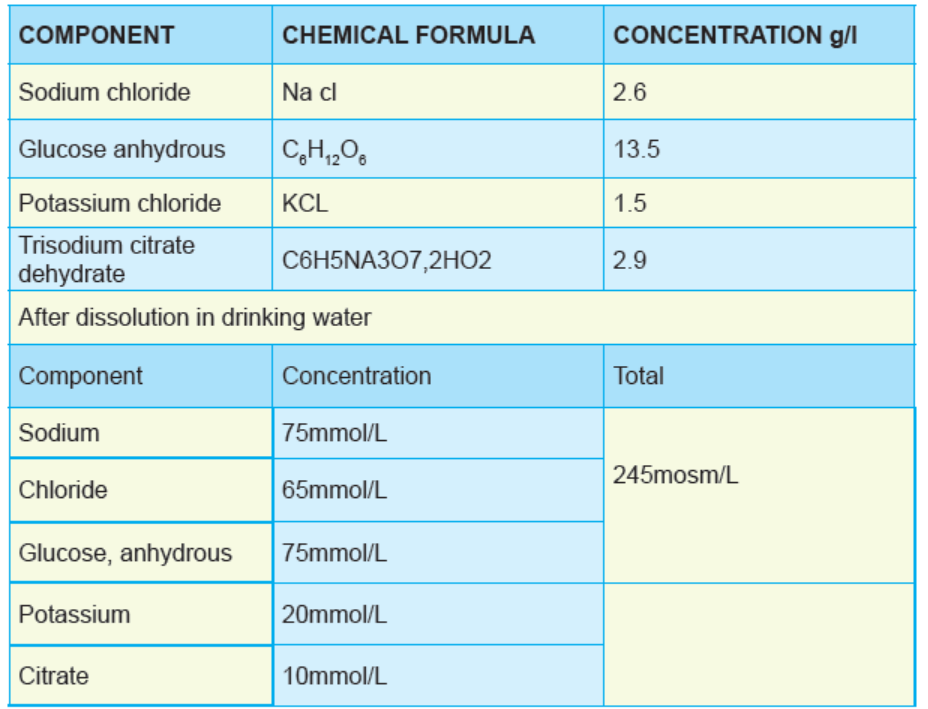
values of its components.
Glucose facilitates the absorption of sodium and hence water in small intestine.Sodium and potassium are important in replacement of losses of the essential ions
during diarrhea and vomiting. Citrate corrects the acidosis that occurs as a resultof diarrhea and dehydration.
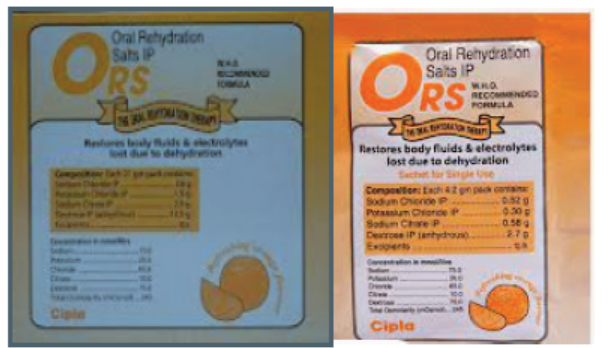
Figure 2.10.1 ORS FORMS
In clinical practice, ORS is indicated for the treatment of fluid losses especially in
case of diarrhea in infants, children and adults with mild to moderate dehydration.
The amount to be given is determined on basis of weight and the amount of solution
require depend largely on child status. For child with marked signs of dehydration
or who combines to pass frequently watery stools will require more solution than
those with less marked signs or who are not passing frequent stools.
The approximate amount of ORS solution to give in the first 4 hours:
Below 4 months / less than 5 kg: 200–400 mL
4–11 months / 5–7.9 kg: 400–600 mL
12–23 months / 8–10.9 kg: 600–800 mL
To 4 years / 11–15.9 kg: 800–1,200 mL
To 14 years / 16–29.9 kg: 1,200–2,200 mL
15 years or older / 30 kg or more: 2,200–4,000 mL
If a child wants more than the estimated amount of ORS solution, and there are no
signs of overhydration, give more.
In case the child’s weight is unknown, use patient’s age and if the weight is known
the amount of ORS is estimated by multiplying the child’s weight in kg times 75ml.
During the initial stages of therapy, while still dehydrated, adults can consume up
to 750 mL per hour, if necessary, and children up to 20 mL/kg body weight per
hour. Normal feeding can continue after the initial fluid deficit has been corrected.Breastfeeding should continue between administrations of ORS.
Edematous (puffy) eyelids are a sign of overhydration. If this occurs, stop giving
ORS solution, but give breast milk or plain water, and food. Do not give a diuretic.
When the edema has gone, resume giving ORS solution or home fluids according
to Treatment Plan A. After 4 hours, reassess the child fully. Then decide what
treatment to give next: If signs of severe dehydration have appeared, IV therapyshould be started following WHO Treatment Plan C
If the patient still has signs indicating some dehydration, continue oral rehydration
therapy by repeating the treatment described above. At the same time, start to offer
food, milk and other fluids, as described in WHO Treatment Plan A. If there are nosigns of dehydration, the patient should be considered fully rehydrated.
ORS should not be taken when a patient has cirrhosis of liver, congestive heart
cardiac failure, nephrotic syndrome acute and renal failure, ischemic heart diseases
,adrenocortical insufficiency, hyperkalemic periodic paralysis, hyperkalemia,
hypoventilatory states, chloride depletion due to continuous gastric fluid loss,
metabolic or respiratory alkalosis, hypocalcaemia, hyperosmolar states in anuria
or oliguria, edematous sodium retaining conditions, hypertension, peripheral
or pulmonary edema or toxaemia of pregnancy, severe vomiting, diarrhea and
dehydration requiring fluid therapy, dextrose malabsorption, diabetes mellitus,
thiamine deficiency, severe under nutrition as another specific solution ’’ReSoMal’’is appropriate, hemodilution, hypophosphatemia, sepsis, and trauma.
ORS is also contraindicated for use in patients undergoing treatment with the
following: sodium-retaining drugs such as corticosteroids, NSAIDs, carbenoxolone,or diuretics known to produce hypochloremic alkalosis.
It is very important to note that, ORS is administered with care in cases of acute
dehydration, heat cramps, extensive tissue destruction, or if patients are receiving
potassium-sparing diuretics. Concurrent use with other potassium-containing drugsmay precipitate hyperkalemia.
It is very important to dissolve ORS in water of the correct volume. A weak solution
will not contain optimum glucose and electrolyte concentration and a strong
solution may give rise to electrolyte imbalance. Diarrhea can have very serious
consequences in children under 3 years old. Immediate medical advice should
be sought. In other age groups, if symptoms persist for more than 24–48 hours,consult a doctor.
If nausea and vomiting are present with the diarrhea, small and frequent amounts
of ORS should be drunk first. In infants, immediate medical assistance should
be obtained. Use within 1 hour of reconstitution, or within 24 hours if stored in arefrigerator.
ORS interact with other medicinal products.
It increases excretion of lithium, resulting in a reduced plasma-lithium concentration.
Potassium chloride ACE inhibitors (hyperkalemia); cyclosporine leads to increased
risk of hyperkalemia; potassium-sparing diuretics where hyperkalemia may result.No known interactions to other actives.
For more details, see also under “Contraindications” section.
Undesirable effects
Adverse effects are not very common but in case of excessive amount, hypernatremia,
edema, nausea, vomiting, diarrhea, abdominal cramps, thirst, reduced salivation,
lachrymation, sweating, fever, tachycardia, renal failure, respiratory arrest,
headache, dizziness, restlessness, irritability, weakness, muscular twitching, coma,
convulsions, hyperkalemia, gastrointestinal ulceration, metabolic alkalosis, musclehypertonicity, flatulence, dehydration, and raised blood pressure may arise
In case of overdose, sodium, potassium restriction, and water intake plus measures
to increase renal sodium, potassium and water output by using loop diuretics forexample are recommended.
HOMEMADE ORAL REHYDRATION SALT
Homemade oral rehydration solution is a rehydration solution prepared at home
using sugar, salt and water locally available at home. It less expensive most effective
but require attention in preparation as in case of error in preparation it may worsendiarrhoea or cause imbalances.
Table 2.10.2: COMPONENTS OF HOMEMADE ORAL REHYDRATION SALTSAND DOSAGE
Materials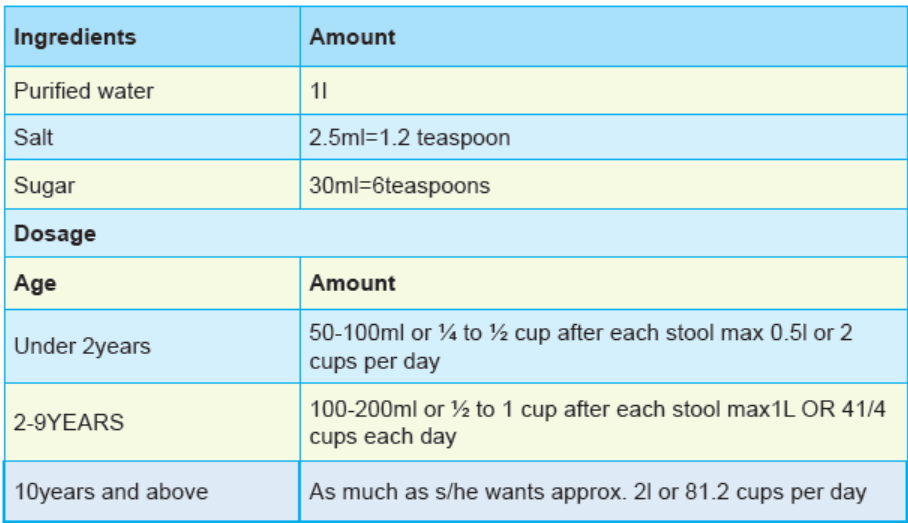
Teaspoon
Salt
Sugar
Clean or boiled waterContainer 1 L OR above
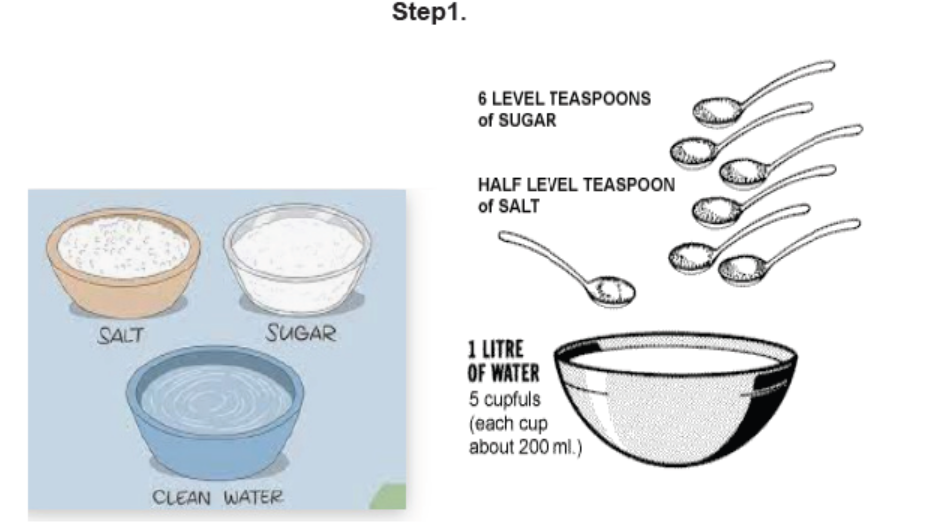
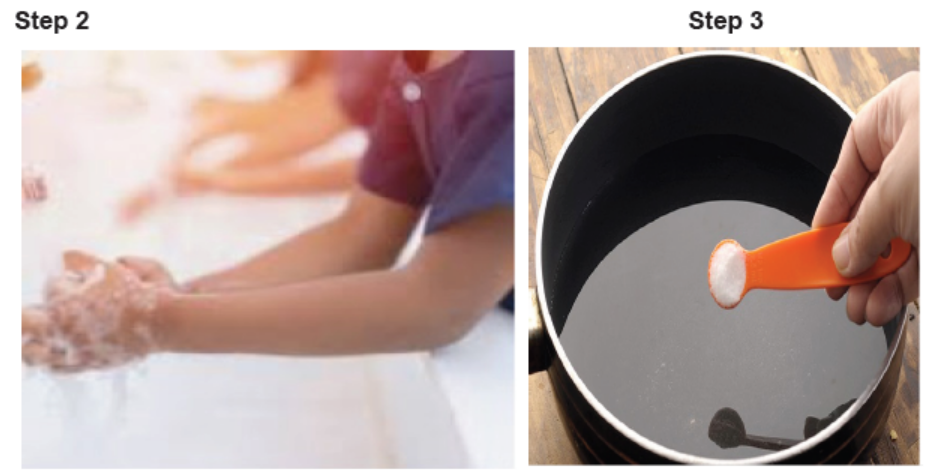
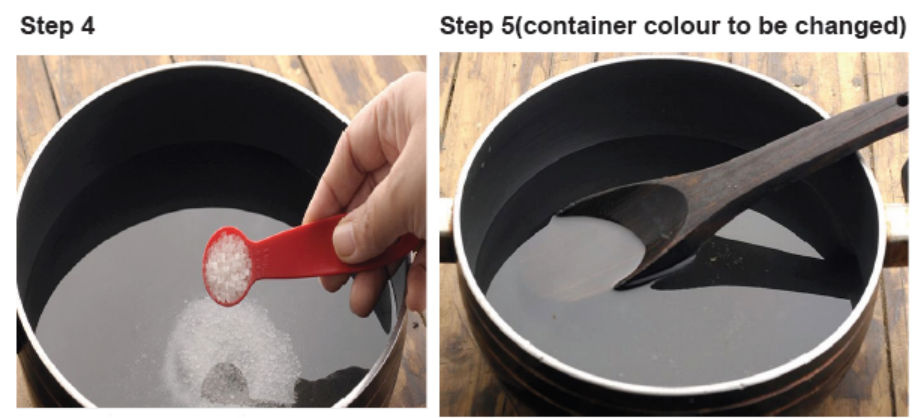
Self assessment 2.10
Respond by True or false
4. High osmolality oral rehydration solutions are more effective than low
osmolality solutions.
5. Oral rehydration salt is indicated in case of diarrhea with mild dehydration.
6. You have to avoid oral rehydration salt for a patient with severe acute
malnutrition.
7. When treating a child with mild diarrhea, there is no need to go to the healthfacility as you can offer homemade oral rehydration solution.
Chose the correct answer
1. The components of oral rehydration salt include the following Except
A. Sodium
B. Magnesium
C. Sugar
D. Citrate
2. What is the amount of ORS to be given to a patient weighing 30Kg in the first
4hours?
A. 2,200–4,000 mL
B. 3000-5000ml
C. 1000-2100mlD. 500ml-1500ml
3. For a child with diarrhea, which advice will you give to the caregiver about
moment of ORS administration
A. When child wake up
B. When the child asks
C. After each stool
D. B and C
4. The ingredients for homemade oral rehydration solution are
A. Salt, beans, sugar and water
B. Rice, sugar and beans
C. Sugar, salt and water
D. Sugar, salt and rice
5. Which action should be taken for a patient when there is no improvement and
the dehydration worsened, after 4hrs of ORS administration?
A. Increase the amount
B. Start IV fluids
C. Administer antibioticsD. Continuation of monitoring
2.11. Anti-spasmodic drugs
Learning Activity 2.11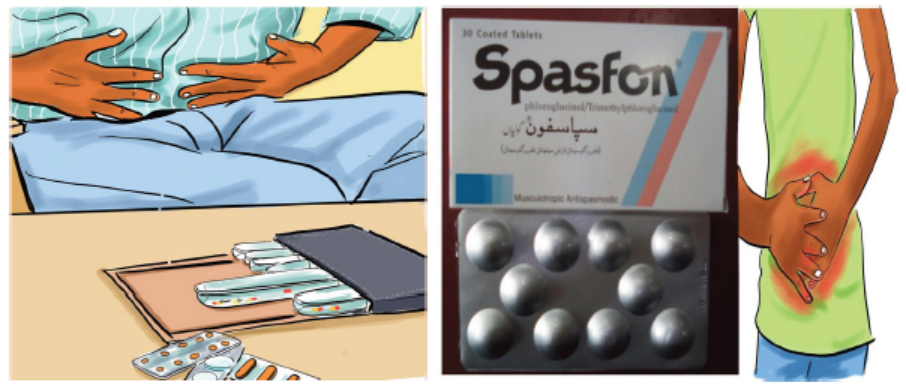
1. What is an antispasmodic drug?2. Give 4 indications of antispasmodic drugs?
CONTENT SUMMARY
Gastrointestinal antispasmodics are medications used to treat spasms of the
gastrointestinal tract muscles, which can occur in diseases like irritable bowel
syndrome, or IBS for short, biliary colic, and pancreatitis it relieves some of the
symptoms of Irritable Bowel Syndrome (IBS) , prevents, or lowers the incidence of
muscle spasms(colic), bloating and tummy (abdominal) pain, especially those of
smooth muscle such as in the bowel wall, and it reduce the movement (motility) ofthe gut (intestines).
Antispasmodics are also used in some other conditions such as:
• Diverticular disease.
• Prevention of nausea, vomiting, and dizziness associated with motion
sickness.
• Adjunctive therapy for treatment of GI ulcers
• Decrease secretions before anesthesia or intubation
• Maintenance treatment of bronchospasm associated with COPD.• Treatment of irritable or hyperactive bowel in adults.
The most common antispasmodic contain anticholinergic properties, which is
helpful in relieving symptoms, such as abdominal pain. They are classified into
two main types: smooth muscle relaxant such as alveline and mebeverine, and
anticholinergics such as hyoscin. However not everybody with IBS finds that
antispasmodics work well, but they are worth trying, as they work well in a goodnumber of cases.
There are two main types antispasmodic drugs: Antimuscarinics drugs andSmooth muscle relaxants:
Smooth muscle relaxants work directly on the smooth muscle in the wall of the
gut. Here they help to relax the muscle and relieve the pain associated with acontraction of the gut.
A. Antimuscarinic drugs
Antimuscarinic medications are a group of anticholinergic agents, specificallyknown for blocking the activity of muscarinic receptors. These receptors play an
important role in mediating the functions of the parasympathetic nervous system,
which controls many involuntary functions to conserve energy, including the
contraction of smooth muscle, dilation of blood vessels, increased bodily secretions,
gastrointestinal activity, and heart rate. Because muscarinic receptors are also
found in other parts of the body, taking an antimuscarinic can have other effects.
For example, muscarinic receptors also help to control the production of saliva in
the mouth.
Therefore, antimuscarinics work by inhibiting the functions of the parasympathetic
nervous system. The two most commonly prescribed antimuscarinics
are atropine and scopolamine(Hyoscine), derived from the Atroppa belladonna
plant.1. Hyoscine (Buscopan 10 mg Tablets)
Hyoscine butylbromide are indicated for the relief of spasm, by helps dismiss lower
tummy (abdominal) muscle cramp and pain, it one of antispasmodic medicine
which is indicated to treat cramps in the stomach, the genito-urinary tract or gastrointestinal
tract and for the symptomatic relief of Irritable Bowel Syndrome or bladder.
In gastro- intestinal tract, specificaly it helps to ease bloating and the spasm-type
pain that can be associated with irritable bowel syndrome and diverticular disease. It
works by relaxing some of the muscles in your gastrointestinal and urinary systems.Each tablet contains hyoscine butylbromide 10 mg.
Posology and method of administration
Buscopan 10 mg tablets are for oral administration only.
Buscopan 10 mg tablets should be swallowed whole with adequate water.
Adults: 2 tablets four times daily. For the symptomatic relief of Irritable Bowel
Syndrome, the recommended starting dose is 1 tablet three times daily, this can be
increased up to 2 tablets four times daily if necessary.Children: 6 - 12 years: 1 tablet three times daily.
Contraindications
Buscopan 10 mg Tablets are contraindicated in: patients who have demonstrated
prior hypersensitivity to hyoscine butylbromide or any other component of the
product, myasthenia gravis, mechanical stenosis in the gastrointestinal tract,paralytic or obstructive ileus, megacolon, narrow angle glaucoma.
Special Precautions: Buscopan 10 mg Tablets should not be taken on a
continuous daily basis or for extended periods without investigating the cause of
abdominal pain. In case severe, unexplained abdominal pain persists or worsens,or occurs together with symptoms like fever, nausea, vomiting, changes in bowel
movements, abdominal tenderness, decreased blood pressure, fainting, or blood instool, medical advice should immediately be sought.
Interaction with other medicinal products and other forms of interaction
The anticholinergic effect of drugs such as tri- and tetracyclic antidepressants,
antihistamines, quinidine, amantadine, antipsychotics (e.g. butyrophenones,
phenothiazines), disopyramide and other anticholinergics (e.g. tiotropium,
ipratropium, atropine-like compounds) may be intensified by Buscopan. Concomitant
treatment with dopamine antagonists such as metoclopramide may result in
diminution of the effects of both drugs on the gastrointestinal tract. The tachycardiceffects of beta-adrenergic agents may be enhanced by Buscopan.
Adverse Reactions:
Many of the listed undesirable effects can be assigned to the anticholinergic
properties of buscopan
• Immune system disorders: anaphylactic shock, anaphylactic reactions,
dyspnoea, other hypersensitivity
• Cardiac disorders: tachycardia
• Gastrointestinal disorders: dry mouth
• Skin and subcutaneous tissue disorders: skin reactions (e.g. urticaria,
pruritus), abnormal sweating• Renal and urinary disorders urinary retention (Rare)
Overdose
Serious signs of poisoning following acute overdosage have not been observed in
man. In the case of overdosage, anticholinergic effects such as urinary retention,
dry mouth, reddening of the skin, tachycardia, inhibition of gastrointestinal motility
and transient visual disturbances may occur, and Cheynes-Stokes respiration hasbeen reported.
Pharmacokinetics
Absorption
As a quaternary ammonium compound, hyoscine butylbromide is highly polar and
hence only partially absorbed following oral (8%) or rectal (3%) administration. After
oral administration of single doses of hyoscine butylbromide in the range of 20 to
400 mg, mean peak plasma concentrations between 0.11 ng/mL and 2.04 ng/mLwere found at approximately 2 hours.
Distribution
Because of its high affinity for muscarinic receptors and nicotinic receptors, hyoscine
butylbromide is mainly distributed on muscle cells of the abdominal and pelvic
area as well as in the intramural ganglia of the abdominal organs. Plasma protein
binding (albumin) of hyoscine butylbromide is approximately 4.4%. Animal studies
demonstrate that hyoscine butylbromide does not pass the blood-brain barrier, butno clinical data to this effect is available.
Metabolism and elimination
Following oral administration of single doses in the range of 100 to 400 mg, the
terminal elimination half-lives ranged from 6.2 to 10.6 hours. The main metabolic
pathway is the hydrolytic cleavage of the ester bond. Orally administered hyoscine
butylbromide is excreted in the faeces and in the urine. Studies in man show that
2 to 5% of radioactive doses is eliminated renally after oral, and 0.7 to 1.6% after
rectal administration. Approximately 90% of recovered radioactivity can be found in
the faeces after oral administration. The urinary excretion of hyoscine butylbromide
is less than 0.1% of the dose. The mean apparent oral clearances after oral doses of
100 to 400 mg range from 881 to 1420 L/min, whereas the corresponding volumes
of distribution for the same range vary from 6.13 to 11.3 x 105 L, probably due to
very low systemic availability. The metabolites excreted via the renal route bind
poorly to the muscarinic receptors and are therefore not considered to contribute to
the effect of the hyoscine butylbromide.
2. Atropine
Atropine is a type of medicine called an antimuscarinic (or sometimes called an
anticholinergic). It works by relaxing the involuntary muscle that is found in the
walls of the stomach and intestines (gastrointestinal tract). Cholinergic antagonism
with atropine reduces proximal gastric emptying, reduces atrial contractility and
notably slows gastric emptying. Atropine is also used in case of hypersalvation,
bronchial secretions, or bradycardia. This drug can be used also before anesthesiato prevent the mucus secretion.
Indication
Relieving stomach cramps or colicky-type abdominal pain, for example associatedwith conditions such as irritable bowel syndrome (IBS).
Therapeutic action
Atropine is a type of medicine called an antimuscarinic (or sometimes called an
anticholinergic). It works by relaxing the involuntary muscle that is found in the walls
of the stomach and intestines (gastrointestinal tract). Atropine works by blocking
receptors called muscarinic (sometimes called cholinergic) receptors that are found
on the surface of the muscle cells in the walls of the gut. This prevents a natural
body chemical called acetylcholine from acting on these receptors. Normally when
acetylcholine acts on these receptors it causes the muscle in the gut to contract.
By preventing this, atropine helps the muscle in the gut to relax. This reduces
involuntary contractions and spasms of the muscle. Spasms in the muscle of the
gut wall can cause colicky abdominal pain, cramps, bloating, wind and discomfort.Atropine relieves these symptoms by relaxing the muscle.
Administration
Atropine tablets should be swallowed whole with a glass of water. They can be
taken either with or without food. The usual dose is one or two tablets to be takenat night. Follow the instructions given by your doctor or pharmacist.
Use with caution in Elderly people, Children, People with Down’s syndrome. Gastro-
esophageal reflux disease (GORD). Inflammation of the bowel and back passage
(ulcerative colitis), Diarrhea, People with a high temperature (fever). People with
disorders of the involuntary nervous system that controls body functions such as
blood pressure, heart rate, sweating, bowel and bladder emptying, and digestion
(autonomic neuropathy), People with an overactive thyroid gland (hyperthyroidism),
High blood pressure (hypertension), Heart attack (myocardial infarction) and
Glaucoma.
Atropine should not be used in people with a condition called myasthenia gravis,
where there is abnormal muscle weakness, people with inactivity of the muscle in
the gut that is causing a blockage or obstruction of the gut (paralytic ileus), people
who have narrowing of the outlet of the stomach, making it difficult for food to
pass into the intestines (pyloric stenosis), Men with an enlarged prostate gland
(prostatic hypertrophy) and people with allergic of its ingredients. If you feel you
have experienced an allergic reaction, stop using this medicine and inform yourdoctor or pharmacist immediately.
Pregnancy and breastfeeding
This medicine should be used with caution during pregnancy, and only if the
expected benefit to the mother is greater than any possible risk to the developing
baby, it passes into breast milk in small amounts. It should be used with caution
by breastfeeding mothers, and only if the expected benefit to the mother is greater
than any possible risk to the nursing infant.
Side effects
Medicines and their possible side effects can affect individual people in different
ways. The following are some of the side effects that are known to be associated
with Atropine. Just because a side effect is stated here, it does not mean that all
people using this medicine will experience that or any side effect.Pregnancy and breastfeeding
This medicine should be used with caution during pregnancy, and only if the
expected benefit to the mother is greater than any possible risk to the developing
baby, it passes into breast milk in small amounts. It should be used with caution
by breastfeeding mothers, and only if the expected benefit to the mother is greater
than any possible risk to the nursing infant.
Side effects
Medicines and their possible side effects can affect individual people in different
ways. The following are some of the side effects that are known to be associated
with Atropine. Just because a side effect is stated here, it does not mean that allpeople using this medicine will experience that or any side effect.
Constipation, dry mouth, flushing and dryness of the skin, increased body
temperature, blurred vision, dilated pupils and dislike of bright light, faster than
normal heartbeat (tachycardia), awareness of your heartbeat (palpitations), irregular
heartbeats (arrhythmias), difficulty passing urine (urinary retention), confusion(especially in elderly people), feeling or being sick, closed angle glaucoma.
Interaction
It is important to tell your doctor or pharmacist what medicines you are already
taking, including those bought without a prescription and herbal medicines,
before you start treatment with this medicine. Similarly, check with your doctor or
pharmacist before taking any new medicines while using this one, to make sure
that the combination is safe. There may be an increased risk of antimuscarinic side
effects, such as dry mouth, blurred vision, constipation, difficulty passing urine and
confusion in elderly people, if this medicine is taken with other medicines that have
antimuscarinic effects, for example the following:
• Amantadine: antihistamines, e.g. brompheniramine, chlorphenamine
• Antimuscarinic medicines for Parkinson’s symptoms, eg procyclidine,
orphenadrine, trihexyphenidyl
• Certain antipsychotic medicines, e.g. haloperidol, chlorpromazine, clozapine
• Other antispasmodic medicines, e.g. hyoscine
• Antidepressants, e.g. phenelzine, tranylcypromine• Tricyclic antidepressants, e.g. amitriptyline, clomipramine.
Drug interactions
This medicine may reduce the effects of the following medicines: Cisapride,
domperidone, ketoconazole, metoclopramide. If you experience a dry mouth as
a side effect of this medicine you may find that medicines that are designed to
dissolve and be absorbed from under the tongue, e.g. sublingual glyceryl trinitrate
(GTN) tablets, become less effective. This is because the tablets do not dissolve
properly in a dry mouth. To resolve this, drink a mouthful of water before taking
sublingual tablets.
B. Smooth muscle relaxants
Smooth muscle relaxants work directly on the smooth muscle in the wall of the gut.
Here they help to relax the muscle and relieve the pain associated with a contraction
of the gut. A muscle relaxant is a drug that affects skeletal muscle function and
decreases the muscle tone. It may be used to alleviate symptoms such as muscle
spasms, pain, and hyperreflexia. The term “muscle relaxant” is used to refer to two
major therapeutic groups: neuromuscular blockers and spasmolytic. Neuromuscular
blockers act by interfering with transmission at the neuromuscular end plate and
have no central nervous system (CNS) activity. They are often used during surgical
procedures and in intensive care and emergency medicine to cause temporary
paralysis. Spasmolytics, also known as “centrally acting” muscle relaxant, are used
to alleviate musculoskeletal pain and spasms and to reduce spasticity in a variety
of neurological conditions. While both neuromuscular blockers and spasmolytics
are often grouped together as muscle relaxant, the term is commonly used to refer
to spasmolytics only. The most common Smooth muscle relaxant prototype arealverine, mebeverine, peppermint oil (colpermin ) and papaverine
Self assessment 2.11
1. The antimuscarinics are used:
B. To accelerate the parasympathetic system
C. To block the parasympathetic system
D. As the drugs of choice for treating ulcers
E. To stimulate gastrointestinal activity
2. Atropine belongs to the class of antimuscarinics. True or False.
3. All of the following antispasmodic drugs belongs to the class of smooth
muscle relaxants, EXCEPT:
A. Atropine
B. Papaverine
C. AlverineD. Peppermint oil
2.12. END UNIT ASSESSMENT
End of unit assessment
1. Which of the following is NOT a risk for peptic ulcer diseases?
B. Smoking
C. NSAIDs use
D. Skin color
E. Stress
2. Which of the following groups of drugs is used to treat peptic ulcer diseases?
A. Antifungals
B. Antivirals
C. Analgesics
D. Antacids.
3. Which statement is true about the mechanism of action of H2 receptor
antagonists?
A. The occupy the histamine receptors and prevent acid secretion
B. They bind to enzyme H-,K-ATPase and increase histamine release
C. They block prostaglandin secretion and decrease histamine release
D. They neutralize the secreted acid directly in the stomach lining
4. Which of the following is among the side effects of metoclopramide?
A. Constipation
B. Drowsiness
C. Fever
D. Headache
5. Which of the following laxatives acts without causing the systemic effect?
A. Bisacodyl
B. Lactulose
C. GlycerinD. Magnesium citrate
6. Which one among the following conditions reflects a contraindication of
antispasmodic drugs?
A. Irritable bowel syndrome
B. Biliary colic
C. Pancreatitis
D. Gastrointestinal obstruction
7. Which of the following options is a nursing consideration before intravenous
fluids administration?
A. Closely monitor for signs and symptoms of allergy if colloids are used.
B. Obtain baseline weight and vital signs
C. Instruct the patient to report any irritation, pain, redness, or swelling at
the IV site
D. Monitor for signs of fluid volume excess
8. The patient should receive ½ l of dextrose 5% in 3hrs. Knowing that the dropfactor is 20 drops per mL . Calculate the drop rate
UNIT 3 MEDICATIONS USED FOR NON-COMMUNICABLE DISEASES
Key Unit Competence:
At the end of this unit, the learner will be able to provide appropriate medications forhypertension, diabetes mellitus and asthma
Introductory activity 3.0
1) What do you observe on these images?
2) In which medical conditions are the materials in these images used?3) What types of medications are the patients taking?
Learning Activity 3.1
As an associate Nurse Student doing a clinical placement in the hospital,
you received a 66-year-old male patient in consultation room. His vitals were:
the blood pressure was 150/100 mmHg, temperature 36.50C, heart rate 17
movements per minute, SPO2: 99%, and pulse of 65 beats per minute. The
physician concluded that the patient had hypertension.
a) What is hypertension?
b) Identify the classes of hypertension considering their grade.c) Enumerate at least 3 classes of hypertensive drugs.
3.1. Introduction to antihypertensive drugs
CONTENT SUMMARY
The cardiovascular system is a closed system of blood vessels that is responsible
for delivering oxygenated blood to the tissues and removing waste products from
the tissues. Blood pressure is the force exerted by circulating blood against the
walls of the body’s arteries, the major blood vessels in the body.
A Blood pressure is written as two numbers. The first (systolic) number represents
the pressure in blood vessels when the heart contracts or beats. The second
(diastolic) number represents the pressure in the vessels when the heart rests
between beats.
The body uses this responsiveness to regulate blood pressure on a constant basis,
to ensure that there is enough pressure in the system to deliver sufficient blood to
the brain.
Hypertension is defined as a high blood pressure. It is diagnosed if, when it is
measured on two different days, the systolic blood pressure readings on both days
is ≥140 mmHg and/or the diastolic blood pressure readings on both days is ≥90
mmHg.
As blood pressure increases, it is more difficult to control it at the target level through
lifestyle modifications alone, and treatment with antihypertensive drugs becomes
necessary. The occurrence of cardiovascular disease can be prevented by reducingthe blood pressure with antihypertensive drugs.
Table 3.1.1: CLASSIFICATION OF HYPERTENSION
Antihypertensive drugs
Anti-hypertensive drugs are a class of drugs that are used to treat hypertension.
Antihypertensive therapy seeks to prevent the complications of high blood
pressure, such as stroke and myocardial infarction. Appropriate antihypertensive
drugs should be selected considering compelling indications, contraindications and
conditions that require the careful use of drugs and the presence or absence of
complications. Antihypertensive drugs are administered once a day, in principle, but
as it is more important to control the blood pressure over 24 h splitting the dose into
twice a day is desirable in some situations.
A gradual reduction in blood pressure is desirable in hypertensive patients in general,
but the target control level should be achieved within several weeks in high-risk
patients, such as those with grade III hypertension and multiple risk factors. The
use of two or three drugs in combination is often necessary to achieve the target
of blood pressure control Simplification of the prescription using fixed-combination
drugs is useful for improving adherence and controlling blood pressure.
The major classes of antihypertensive drugs are:
• Diuretics
• Calcium channel blockers
• Angiotensin converting enzyme inhibitors
• Angiotensin II receptor antagonists/blockers,
• Adrenergic blockers, centrally and peripherally acting blockers
(sympatholytics),• Peripheral vasodilators
Self-assessment 3.1
You are working in a health centre and today you receive a client in the consultation
room. When you take the blood pressure you find that the patient has a B.P of
160/100mmHg, then you tell your client that he has hypertension. The latter asks
you what about the grade of his B.P.
1. What would be the response to the client?
2. Which one among the following classes of drugs is an antihypertensive?
a) Diuretics
b) Analgesics
c) Antibioticsd) Antihistamines
3.2.Diuretic drugs
Learning Activity 3.2
As associate Nurse Student in the clinical placement in hospital, you receive a
50-year-old male patient in the consultation room. His vital signs are: the blood
pressure is150/100 mmHg, temperature 36.50C, heart rate 17 movements per
minute, SPO2: 99%, and pulse of 65 beats per minute. The patient complains of
increased urination, and the nurse informs the patient that the drugs the patient
is taking are associated with an increased urination. When the student wants
more explanation, the nurse replies that the drugs fall to the class of diuretics.
Using library textbooks, read and take note while responding to the following
questions.
1) What is diuretic drug?2) Identify the categories of diuretic drugs and give an example for each.
CONTENT SUMMARY
Diuretics are drugs that increase sodium excretion and lower blood volume,
consequently lower the blood pressure. Diuretics are divided into four categories
according to their action: thiazide diuretics, loop diuretics, potassium-sparing
diuretics, and osmotic diuretics. The type of diuretic used is determined by the
condition being treated. They are used to treat mild hypertension and often first
agents used, often used in combination with other agents
Thiazide diuretics
Thiazide agents are the most commonly used type of diuretic, increasing excretion
of water, sodium, chloride, and potassium. Their site of action is proximal part of the
distal convoluted tubule, and all of them have antihypertensive effect.
They are contraindicated in case of diabetes, severe renal failure, impaired liver
function, and a history of gout.Tables 3.2.1. Thiazide diuretics


Figure 3.2.1: Thiazide diuretics
Loop diuretics
Loop diuretics are drugs that act on the Loop of Henle not prescribed routinely for
hypertension, but are used when diuresis is required. Loop diuretics are used in
the treatment of oedema associated with impaired renal kidney function or liver
disease. They are also commonly prescribed for the treatment of congestive heart
failure, pulmonary oedema, and ascites caused by malignancy or cirrhosis.
If thiazides are ineffective in the treatment of hypertension, loop diuretics sometimes
are used in combination with other antihypertensive(s).
The most commonly used loop diuretic is furosemide (Lasix). Its usual dose is
20–80 mg/d but up to 600mg /d may be given.
For Intravenous or intramuscular20–40 mg IM or IV given slowly; 40 mg IV over
1–2 min for acute pulmonary oedema, increase to 80 mg after 1 h if response is not
adequate; 40 mg PO b.i.d. for hypertension.
Pediatric: 2 mg/kg/d PO for hypertension, not to exceed 6 mg/kg/d; 1 mg/kg IV or IM
for edema, increased by 1 mg/kg as needed; not to exceed 6 mg/kg Treatment of
acute HF; acute pulmonary edema; hypertension; and edema of HF, renal disease,
or liver disease
Loop diuretics are contraindicated in dehydrated patients, those with anuria and incase of hypersensitivity to the drug or its components.
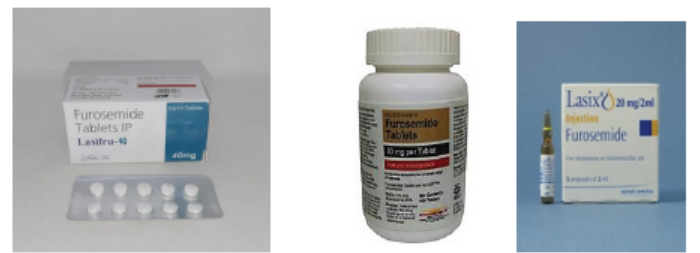
Figure 3.2.2: Dosage forms of furosemide
Potassium-Sparing Diuretics
The potassium-sparing agents are used in the management of edema associated
with congestive heart failure, hepatic cirrhosis with ascites, the nephrotic syndrome,
and idiopathic edema and used in combination with other drugs in the management
of hypertension. Their site of action is Distal tubule and collecting duct. They are
aldosterone antagonist. Potassium-sparing drugs are contraindicated for patients
with anuria, acute renal insufficiency, impaired renal function, or hyperkalemiaTables 3.2.2: Potassium sparing diuretics:


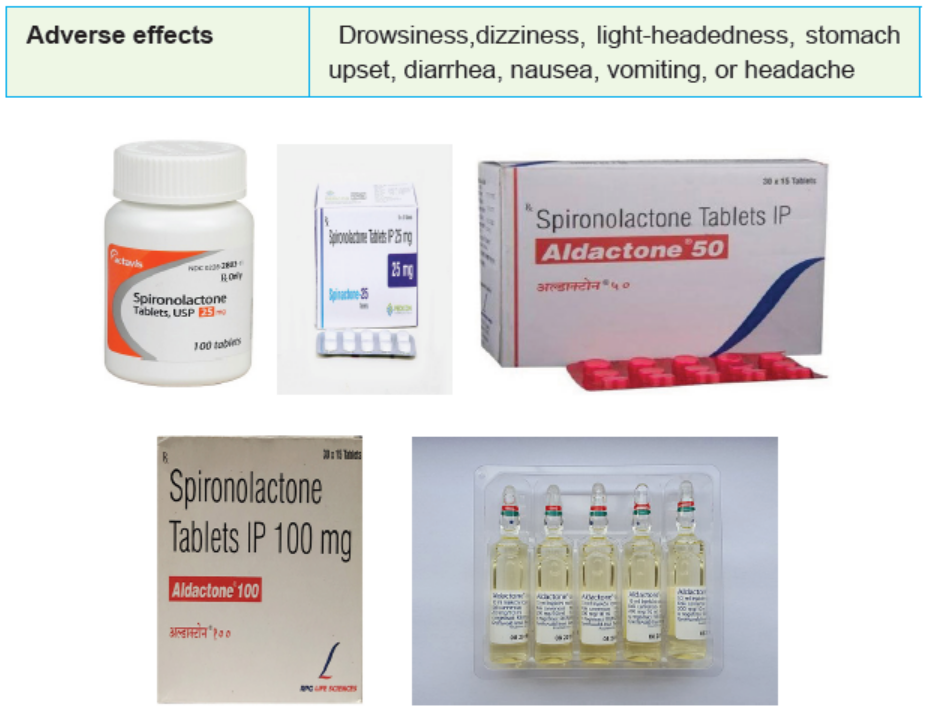
Figure3.2.3: Dosage forms of Thiazide diuretics
NURSING CONSIDERATIONS FOR PATIENT RECEIVING DIURETICS
• Assess for contraindication or cautions including any allergy or hypersensitivity
• Perform a physical assessment to establish baseline data before beginning
therapy, to determine the effectiveness of therapy, and to evaluate for
occurrence of any adverse effects associated with drug therapy.
• Obtain an accurate body weight to provide a baseline to monitor fluid balance.
• Monitor intake and output and assess voiding patterns to evaluate fluid
balance and renal function
• Administer oral drug with food or milk to buffer the drug effect on the stomach
lining if GI upset is a problem.
• Administer intravenous diuretics slowly to prevent severe changes in fluid
and electrolytes.
• Administer oral form early in the day so that increased urination will not
interfere with sleep.
• Monitor the dose carefully and reduce the dose of one or both drugs if givenwith antihypertensive agents; loss of fluid volume can precipitate hypotension.
• Monitor the patient response to the drug (e.g., blood pressure, urinary output,
weight, serum electrolytes, hydration, periodic blood glucose monitoring) to
evaluate the effectiveness of the drug and monitor for adverse effects
• Assess weight daily to evaluate fluid balance.
• Check skin turgor to evaluate for possible fluid volume deficit, and assess
edematous areas for changes, including a decrease in amount or degree of
pitting.
• Provide comfort measures, including skin care and nutrition consultation, to
increase compliance with drug therapy and decrease the severity of adverse
effects; provide safety measures if dizziness and weakness are a problem to
prevent injury.
Note:
Spironolactone can be used in children but with careful monitoring of electrolytes.Amiloride is indicated for use in children.
Self-assessment 3.2
The thiazide diuretics work at the proximal part of the convoluted tubule. TRUE
or FALSE
Which drug among the following is a potassium sparing diuretic?
a) Furosemide
b) Captopril
c) Aldactone
d) Diuril
Which of the following is a side effect of hydrochlorothiazide?
a) High blood pressure
b) Decreased urination
c) Excessive dysphagia
d) Erectile dysfunctionEnumerate the contraindications of Lasix.
3.3. CALCIUM CHANNEL BLOCKERS DRUGS
Learning Activity 3.3
A patient was given medications and he tells you that he wants to know much
about the regimen he was given to control his hypertension. When you read, you
found that among them there is one called nifedipine. Remembering that he had
only covered diuretic drugs among hypertensive drugs, you want to give him full
information about the class where nifedipine belongs.
Using library texbooks and internet, read and take note about the following:
1) In which class does nifedipine belong?
2) What are the other drugs found in this class?3) What is the mechanism of action of the drugs from this class?
CONTENT SUMMARY
Calcium channel blockers are a type of drug that block the entry of calcium into
smooth muscle cells as well as myocytes. They produce arterial vasodilation and
thereby reduce arterial blood pressure. Calcium channel blockers relax and open
up narrowed blood vessels, reduce heart rate and lower blood pressure. They lower
blood pressure by reducing myocardial contractility.Tables 3.3. 1: Commonly used calcium channel blockers:


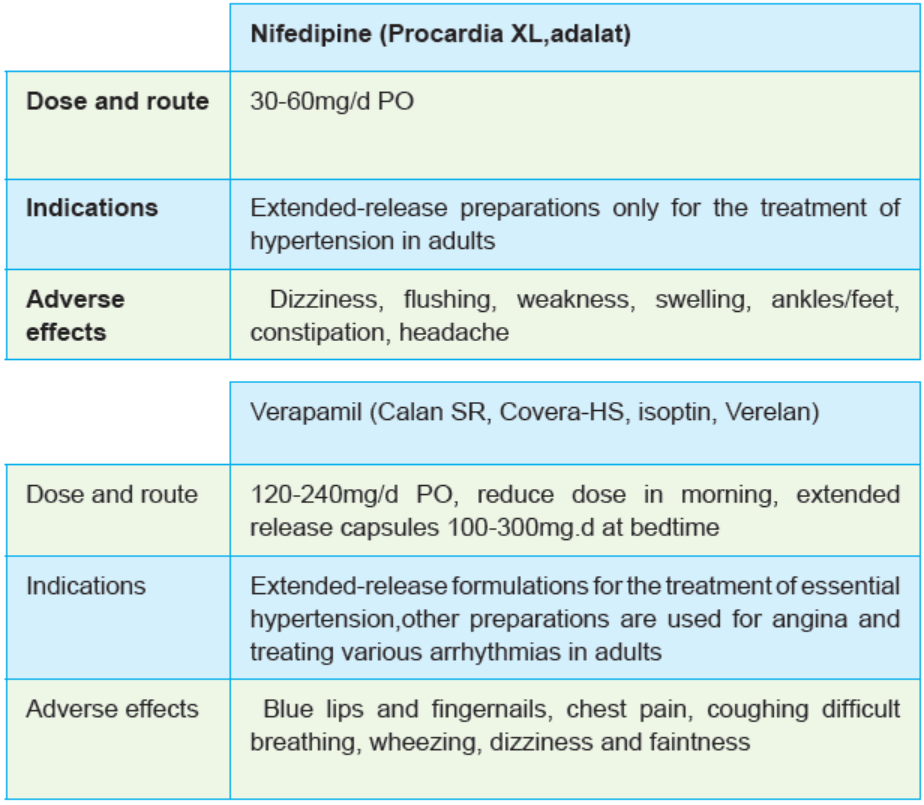

Figure 3.3.1: Forms of calcium channel blockers
Nursing considerations
• Assess for contraindications or cautions : known Allergies, impaired liver or
kidney function, heart block, and current status of pregnancy or lactation.
• Perform a physical assessment to establish baseline status before beginning
therapy and during therapy to determine the effectiveness and evaluate for
any potential adverse effects.
• Inspect skin for color and integrity to identify possible adverse skin reactions
• Assess cardiopulmonary status closely, including pulse rate, blood pressure,
heart rate, and rhythm, to determine the effects of therapy and identify any
adverse effects.
• Monitor vital signs and auscultate lungs to evaluate changes in cardiac output.
• Monitor laboratory test results, including liver and renal function tests, to
determine the need for possible dose adjustment.
• Provide comfort measures to help the patient tolerate drug effects.
• Offer support and encouragement to help the patient deal with the diagnosis
and the drug regimen.
• Provide thorough patient teaching
• Monitor patient response to the drug
• Monitor for adverse effects
• Monitor the effectiveness of comfort measures and compliance with the
regimen.• Evaluate the effectiveness of the teaching plan.
Self-assessment 3.3
1) Which among the following drugs is a calcium channel blocker?
a) Atenolol
b) Aldactone
c) Adalat
d) Furosemide
2) You are assigned to take care of a patient who is on verapamil. Give at
least five elements you must monitor while you are caring for that patient.3) Enumerate the side effects of amlodipine.
3.4. Angiotensin converting enzyme inhibitors and
angiotensin II receptor blockers
Learning Activity 3.4
In a class of pharmacology, the teacher asked her students about antihypertensive
drugs and wanted to know if they know the drugs that interfere with the activity of
angiotensin in human body.
Using library textbooks, read and take note on the following points:
a) Identify 2 categories of drugs that interfere with the activity of angiotensinb) Give one example for each category
Content summary
Angiotensin-converting enzyme (ACE) inhibitors slow the formation of angiotensin II,
which reduces vascular resistance, blood volume, and blood pressure. ACE inhibitors
are becoming the drugs of choice in the first-line treatment of essential hypertension.
ACE inhibitors are contraindicated in patients with hypersensitivity to these agents,
kidney damage, heart failure, hepatic impairment, and diabetes mellitus. ACE inhibitors
are avoided during pregnancy (category D). Safety during lactation or in children is not
established. Although ACE inhibitors as a group are relatively free of side effects or
toxicities in most patients, they do occur, and some can be life-threatening.
The adverse effects of ACE inhibitors may include: dizziness, angioedema, loss of
taste, photosensitivity, severe hypotension, dry cough, hyperkalemia, blood dyscrasias,and renal impairment.
ACE inhibitors should be used cautiously in patients with renal impairment or
hypovolemia, or who are receiving diuretics or undergoing dialysis. These drugs
are used with caution in patients with congestive heart failure, hepatic impairment,and diabetes mellitus.
Table 3.4.1 commonly used ACE inhibitors


Figures 3.4.1: ACE inhibitors
Nursing considerations
• Assess for the cautions or contraindications to use of the drug like known
allergies to these drugs to prevent hypersensitivity reactions; impaired kidney
function, pregnancy or lactation
• Physical assessment to determine the baseline status before beginning
therapy to determine any potential adverse effects.
• Encourage patient to implement lifestyle changes, including weight loss,
smoking cessation, decreased alcohol and salt in the diet, and increased
exercise, to increase the effectiveness of antihypertensive therapy.
• Administer on an empty stomach 1 hour before or 2 hours after meals to
ensure proper absorption of the drug.
• Consult with the prescriber to reduce the dose in patients with renal failure.
• Monitor the patient carefully in any situation that might lead to a drop in fluid
volume (e.g., excessive sweating, vomiting, diarrhea, dehydration) to detect
and treat excessive hypotension that may occur.
• Provide comfort measures to help the patient tolerate drug effects. These
include small, frequent meals; access to bathroom facilities; bowel program
as needed; environmental controls; safety precautions; and appropriate skin
care as needed.
• Provide thorough patient teaching, including the name of the drug, dosage
prescribed, measures to avoid adverse effects, warning signs of problems,
and the need for periodic monitoring and evaluation, to enhance patient
knowledge about drug therapy and to promote compliance.
• Offer support and encouragement to help the patient deal with the diagnosisand the drug regimen.
Angiotensin II receptor antagonists/blockers :
Angiotensin II receptor antagonist drugs work by blocking the binding of angiotensin
II to the angiotensin I receptors. By blocking the receptor site, these agents inhibit
the vasoconstrictor effects of angiotensin II as well as preventing the release of
aldosterone due to angiotensin II from the adrenal glands. This class of drugs
has been one of the most rapidly growing groups of drugs for the treatment of
hypertension
All of the ACE inhibitors are administered orally. Angiotensin II receptor antagonists
are contraindicated in patients with a known hypersensitivity to these agents. These
drugs are also contraindicated in pregnancy (category C, first trimester; category D,
second and third trimesters) and lactation.
Angiotensin II receptor antagonists are used cautiously in patients with concurrent
administration of high-dose diuretics, potassium-sparing diuretics, or potassium
salt substitutes, and in diabetes or lactation.
Angiotensin II receptor antagonists should be used with caution in patients withhepatic or renal impairment, or in elderly patients.
Table.3.5. Commonly used Angiotensin receptor blockers


Figure3.4.2: Angiotensin receptor blockers
Nursing considerations
• Assess for the contraindications and cautions before administration. These
include allergies, impaired kidney or liver functions, pregnancy and lactation,
hypovolemia
• Assess the baseline status before beginning therapy to determine any
potential adverse effects
• Encourage patient to implement lifestyle changes, to increase the effectiveness
of antihypertensive therapy.
• Administer without regard to meals; give with food to decrease GI distress
• Ensure that the female patient is not pregnant before beginning therapy, and
suggest the use of barrier contraceptives while she is taking these drugs
• Monitor the patient carefully in any situation that might lead to a drop in fluid
volume like excessive sweating, vomiting, diarrhea, dehydration, to detect
and treat excessive hypotension that may occur.
• Provide comfort measures to help the patient tolerate drug effects, including
small, frequent meals; access to bathroom facilities; safety precautions if
central nervous system effects occur; environmental controls; appropriate
skin care as needed; and analgesics as needed.
• Provide thorough patient teaching, including the name of the drug, dosage
prescribed, measures to avoid adverse effects, warning signs of problems,
and the need for periodic monitoring and evaluation, to enhance patient
knowledge about drug therapy and to promote compliance.
• Offer support and encouragement to help the patient deal with the diagnosis
and the drug regimen.
• Monitor patient response to the drug (maintenance of blood pressure within
normal limits).
• Monitor for adverse effects
• Evaluate the effectiveness of the teaching plan (patient can name drug,
dosage, adverse effects to watch for, measures to avoid them, and the
importance of continued follow-up).
• Monitor the effectiveness of comfort measures and compliance with theregimen.
Self-assessment 3.4
1) Which of the following drugs is an ACE inhibito?
a) Captopril
b) Lasix
c) Cozaar
d) Diovan
2) Which of the following drugs is an ARB drug?
a) Captopril
b) Lasix
c) Cozaar
d) Enalapril
3) Enumerate at least two contraindications of ARBs.4) What are the side effects of ACE inhibitors?
3.5. Vasodilators and Sympathetic Nervous SystemBlockers
Learning Activity 3.5
You are a Senior six associate nurse student in clinical practicum at the emergency
department and they receive a 39 years old female with history of hypertension.
Her blood pressure was found to be 280/150mmHg. After notifying the physician,
the latter ordered an IV drug which is a vasodilator in attempt to manage this
hypertension. You want to know more about how the vasodilators may help in
controlling the blood pressure, and you are assigned to read more about these
drugs and present in the morning staff meeting the next day. In addition, you
have been requested to read on other drugs that decrease the blood pressure
by working on the sympathetic nervous system.
1) How do vasodilators work to reduce the blood pressure? Give at least two
examples of vasodilator drugs.
2) Give at least two classes of drugs that work on the sympathetic nervous
system to reduce the blood pressure.Guidance: Use library textbooks and internet.
CONTENT SUMMARY
Vasodilators are used to relax or dilate vessels throughout the body. They block
the movement of calcium into the smooth muscle of the blood vessels to cause
relaxation of the smooth muscle, and dilation of the resistance vessels.
Some work on either veins or arteries; others work on both. Vasodilators are
prescribed as second-line agents to initial therapy in patients taking diuretics, betablockers,
ACE inhibitors, calcium-channel blockers, alpha adrenergic blocker, or
alpha/betaadrenergic blockers.
Vasodilator agents are reducers of hypertension. A peripheral vasodilator is
frequently used in the treatment of moderate to severe hypertension.
Common adverse effects of vasodilator drugs include headache, dizziness,
tachycardia, palpitations, anxiety, nausea, vomiting, disorientation, depression,
edema, impotence, and allergic reactions.
They are contraindicated in patients with coronary artery disease, mitral valvular
rheumatic heart disease, atriovenous shunt, and myocardial infarction. Safe use ofvasodilators during pregnancy (category C) or lactation is not established.
Table 3. 5. 1Commonly used vasodilators


SYMPATHETIC NERVOUS SYSTEM BLOCKERS
Drugs that block the effects of the sympathetic nervous system are useful in
blocking many of the compensatory effects of the sympathetic nervous system.
They include beta-blockers, alpha blockers, alpha and beta blockers and alphaadrenergicblockers.
Beta-blockers act by blocking vasoconstriction, decrease heart rate, decrease
cardiac muscle contraction, and tend to increase blood flow to the kidneys, leading
to a decrease in the release of renin. These drugs have many adverse effects and
are not recommended for all people. They are often used as monotherapy in step
2 treatment, and in some patients, they control blood pressure adequately. The
commonly used beta blockers are acebutolol, atenolol (Tenormin) and propranolol.
Their common contraindications are diabetes mellitus, chronic obstructivepulmonary disease (COPD) and asthma.
Table 3. 5.2: Commonly used beta blockers
Self-assessment 3.5
1) Among the antihypertensive drugs, which one is a vasodilator used in
case of hypertensive crisis?
a) Atenolol
b) Acebutelol
c) Carvedilol
d) Nitroprusside
2) Which of the following classes of antihypertensive drugs acts on
sympathetic nervous system?
a) Diuretics
b) Beta-blockers
c) Calcium channel blockersd) ACE inhibitors
3.6. Treatment guidelines of hypertension
Learning Activity 3.6
A 40-year-old female patient consults a health facility where you are placed
in the clinical placement. It is a known case of prehypertension who was on
lifestyle measures and on her arrival, her blood pressure is 150/90 mmHg. She
is then screened for diabetes, and the glycaemia shows that the patient meets
the criteria to be diagnosed as a diabetic patient. The fellow associate nurse
student in the clinical placement wants you to advice on the class of first line
antihypertensive medications.
1) What class of antihypertensive medications can you advise to prescribe
for this patient according the national guidelines?
2) Apart from glycemia, what other laboratory investigations may be
requested before starting the antihypertensive drugs according to thenational guidelines?
CONTENT SAMMURY
The national guideline on hypertension focus on diagnosis of hypertension,
determining the cause of increased blood pressure and to establish the follow up
visit.
A diagnosis of hypertension is only made when: Systolic blood pressure>=140
mmHg OR Diastolic blood pressure >= 90mmHg. Blood pressure needs to be
elevated on two separate visits.
There is a need to take history and do investigation and decide whether the patient
has essential or secondary hypertension. This is applicable in children and adults.
Again it is important to assess the grade of hypertension as seen in the first lesson
of this unit. Finally, establish or confirm that the patient has hypertension, identify or
confirm the stage of hypertension, assess medication compliance and hypertension
control and discuss about Life style modification.
The management of hypertension will depend on the stage and whether the patientis pregnant or is a child.
Stage I: 140/90mmhg-159/99mmHg
Stage II: 160mmhg-179/109mmHg,
Stage III: 180/110 mmHg
Before starting antihypertensive drugs, a complete history, physical examination
as well as some laboratory tests and investigation like HIV test must be taken
because HIV positive patients are managed with precaution and some regimen may
change. Again, it is very important to test the electrolytes to rule out hypokalemia
and hyperkalemia, as well as taking creatinine to rule out renal failure. In females,
a pregnancy test must be taken before initiating antihypertensive drugs because
some drugs like Ace-Inhibitors, Atenolol, and HCTZ should not be used in pregnantwomen.
Treatment of hypertensive Emergency
BP > 180/110 with evidence to damage to brain, eye, heart, kidneys or fetus
1) Give medication every 30 minutes
2) Call physician and admit to hospital3) Check blood pressure every thirty minutes until transfer
Table 3.6.1: Treatment of hypertensive emergency
Treatment of essential hypertension
STAGE 1 (BP 140/90 – 159/99) WITHOUT RISK FACTORS
1) Encourage lifestyle modifications
2) If unable to achieve a blood pressure < 140/90 in 12 months, start one
antihypertensive3) Monitor every 3 months
STAGE 1 (BP 140/90 – 159/99) WITH RISK FACTORS:
1) Encourage lifestyle modifications
2) If unable to achieve a blood pressure <140/90 in 3 months, start one
antihypertensive
3) Monitor every 3 months
STAGE 2 (BP 160/100 – 179/109):
1) Start two hypertensive medications
2) Encourage lifestyle modifications
3) Follow-up in 1 month
4) Lifestyle Modifications:
STAGE 3 (BP > 180/110) without danger signs:
1) Start two anti-hypertensive drugs immediately.
2) Encourage lifestyle modifications.
3) Follow-up in 2 weeksTable 3.6.2: Treatment of essential hypertension


Treatment of Hypertension with complications
Diabetes: ACE-Inhibitors are first line.
Proteinuria: ACE-Inhibitors are first line.
Cardiomyopathy: Ace-Inhibitors, Beta-blockers, Spironolactone are preferred.
Chronic Renal Failure:
1st Line: Furosemide, Amlodipine or Nifedipine
2nd Line: Beta-blockers and hydralazineTable 3.6.3: Treatment of Hypertension with complications

Self-assessment 3.6
Read carefully the scenario below:
1) Two patients A and B presented to the outpatient department of the
hospital where you work as an associate nurse. The first has a high B.P
of 144/95mmHg and the second one has a BP of 198/150mmHg. Both
of them have no other risk factors.
i. All of the following are the options for patient A management, EXCEPT:
a) Encourage lifestyle modifications
b) If BP >140/90 in 12 months, start one antihypertensive
c) Monitor every 3 months
d) Administer hydralazine
ii. All of the following are the options for patient B management:
a) Encourage lifestyle modifications
b) If BP >140/90 in 12 months, start one antihypertensive
c) Administer hydralazine IV if available
d) Monitor every 3 months
2) Which of the following antihypertensive drugs is classified in the third line
of anti-hypertensive drugs based on national guidelines?
a) Captopril
b) Atenolol
c) Amlodipined) Hydralazine
3.7. Oral antidiabetic medications
Learning Activity 3.7
The patient has been followed up after episode of hyperglycemia but the advice
given on a diet and exercise do not impact on his blood glucose level. Today, the
health care providers would like to prescribe oral antidiabetic drugs.
Using library textbooks and internet respond to the following questions:
1) When are oral anti diabetic agents indicated?2) What are the contraindication of Metformin anti diabetic drug
CONTENT SUMMARY
Diabetes Mellitus (DM), is a group of metabolic diseases that occur with increased
levels of glucose (hyperglycemia) in the blood. It is non-communicable disease
resulting from defects in insulin secretion, insulin action or both. It is associated with
acute complications
Insulin is a hormone that allows the body to efficiently use glucose as fuel. Diabetes
has major classifications that include type 1 diabetes, type 2 diabetes, gestationaldiabetes, and diabetes mellitus associated with other conditions.
Table 3.7.1: Classification of diabetes based on etiology.

Table 3.7.2: Diagnosis of diabetes mellitus based on glycaemia

To convert mmol/l into mg/dl, multiply mmol/l by 18
Diabetes is a serious chronic disease that has no cure. However, it can be controlled
but its complications are inevitable. Their prevention is the cornerstone of therapy
and include non-pharmacological management measures like nutrition, exercise,
monitoring and education (what foods to eat, how much and how often to eat,
how to exercise and its precautions) and pharmacological management (how and
when to take medications) including oral antidiabetic medications and parenteral
antidiabetic medications. The goal is to keep the blood sugar level as close to
normal as possible to delay or prevent complications. Generally, the goal is to keep
daytime blood sugar levels before meals between 80 and 130 mg/dL (4.44 to 7.2
mmol/L) and after-meal numbers no higher than 180 mg/dL (10 mmol/L) two hoursafter eating.
ORAL ANTIDIABETIC MEDICATIONS
Oral hypoglycaemic agents stimulate the pancreas to secrete more insulin and
increase the sensitivity of insulin receptors in target tissues. Oral hypoglycaemic
agents are indicated for the treatment of uncomplicated type II diabetes in patients
whose diabetes cannot be controlled by diet or exercise only.
They are grouped in five classes: Sulfonylureas, alphaglucosidase inhibitors,
biguanides, meglitinides, and thiazolidinediones. Their common adverse effects
are nausea, vomiting, headache, blurred vision, sedation, confusion, anxiety,
nightmares, and tachycardia.
Oral hypoglycemic agents are contraindicated in patients who are receiving
sulfonamide or thiazide-type diuretics, who are hypersensitive to the agents, and
who have acidosis, severe burns, or severe diarrhea. These agents should be used
cautiously in patients with high fevers, severe infections, hyperthyroidism, or kidneyfunction impairment.
Commonly used oral hypoglycemic agents:
1) METFORMIN
Metformin hydrochloride (glucophage®):
Metformin belongs to the class of biguanides. It lowers blood glucose by helping the
body to make better use of insulin. It is an adjunct to diet to lower blood glucose in
type 2 diabetics.
Indications: Type 2 diabetes mellitus, prediabetes, Type 1 diabetes mellitus
(T1DM) Metformin is sometimes used in T1DM to limit insulin dose requirement.
Contraindications: Hypersensitivity, chronic heart failure, metabolic acidosis with
or without coma, diabetic ketoacidosis (DKA), severe renal disease, abnormal
creatinine clearance resulting from shock, septicaemia, or myocardial infarction
and lactation
The commonly reported side effects of metformin include: lactic acidosis, diarrhea,
nausea, nausea and vomiting, vomiting, and flatulence. Other side effects
include asthenia, and decreased vitamin b12 serum concentrate.
Dose: Adults: 500–850 mg/d PO in divided doses; reduce dose in geriatric and
renal-impaired patients; maximum dose: 2,550 mg/d.
Children: 10–16 y: 500 mg/d PO with a maximum dose of 2,000 mg/d; do not useextended release form.

Figure 3.7.1: Forms of metformin
2) GLIBENCLAMIDE
Glibenclamide (GBC) or glyburide is an oral hypoglycemic drug that stimulates
the pancreatic beta cells to secrete insulin and is used to treat type 2 diabetes,
including diabetes during pregnancy.
It belongs to a group of medicines called sulfonylureas. Glibenclamide lowers
blood glucose by increasing the amount of insulin produced by your pancreas. It is
recommended that it be taken together with diet and exercise. It may be used with
other antidiabetic medication and t is not recommended for use by itself in type 1diabetes.
Dose: Initially 2.5-5mg daily, adjusted in increments of 2.5mg at weekly intervals,based on patient’s response. Maximum: 20mg daily.
Dose 10mg may be given in 2 divided doses
In elderly >70 years contraindicated.

Forms of Glibenclamide
3) VILDAGLIP TIN
Vildagliptin (Galvus) is an oral anti-hyperglycaemic agent of the dipeptidylpeptidase-4 inhibitor class of drugs.
Dose: 50 mg once or twice daily. The maximum daily dose of Galvus is 100 mg. For
monotherapy, and for combination with metformin, with a TZD or with insulin (withor without metformin), the recommended dose of Galvus is 50 mg or 100 mg daily.

Figure 3.7.2: Forms of vildagliptin
Self-assessment 3.7
1) Among the following drugs, which one is an oral antidiabetic drug?
a) Insulin
b) Lasix
c) Daonil
d) Diovan
2) 2. For a patient who is taking oral antidiabetic agents, which complain a
nurse will expect from them?
a) Hypertension
b) Nightmares
c) Fever
d) Chills
3) 3. Which of the following drug is a sulfonylurea?
a) Vildagliptin
b) Glucophage
c) Glibenclamided) All of them
3.8. Parenteral antidiabetic drugs
Learning Activity 3.8
In clinical session students were shown different oral antidiabetic medications
used to treat diabetic patients. After a long discussion, students wanted to know if
apart from oral medications, there are no other forms of antidiabetic medications
available. A senior nurse replied that there are injectable antidiabetic medications
that were kept in the fridge in another room and requested them to take this as
an assignment that they will present the following week. You are among the
class members, respond the following questions to prepare that presentation.
1) Which antidiabetic drug is administered parenterally?
2) When is that drug indicated?3) What are different types of that drug?
CONTENT SUMMARY
Insulin is the only parenteral antidiabetic available for use in treatment of diabetes.
Normally, insulin is used for the treatment of type I diabetics if the pancreas does
not produce enough insulin but some patients with type 2 diabetes already on
maximum oral therapy may also require insulin injections or in case of DKA orglucose >400mg/dL, pregnancy, renal (>150mmol/L) and Children < 18 years old.
Insulin preparations are available from three different species, including cows, pigs,
and humans. Human insulin now is produced by chemical conversion from porcine
insulin and by Escherichia coli, into which the human genes for insulin have been
inserted. The recombinant product has the same physiological properties as insulinfrom beef or pork but is much less likely to cause allergic reactions.
Adverse Effects
The most dangerous adverse effect of insulin therapy is hypoglycemia. The other
adverse effects include tachycardia, sweating, drowsiness, and confusion. If severe
hypoglycemia is not immediately treated with glucose, convulsions, coma, anddeath may occur.
Indications for insulin: Insulin is used to control hyperglycemia in the diabetic
patient, and for the emergency treatment of acute ketoacidosis. It may beadministered intravenously or subcutaneously.
Contraindications and Precautions
Insulin is contraindicated in patients with hypersensitivity to insulin animal protein.
It is also contraindicated during episodes of hypoglycemia. Insulin should be used
with caution in patients with insulin-resistant hyperthyroidism or hypothyroidism,
during lactation, in older adults, during pregnancy (category B), and in those withrenal or hepatic impairment.
Drug Interactions
Alcohol, anabolic steroids, MAOIs, and salicylates may potentiate hypoglycemic
effects. Dextrothyroxine, corticosteroids, and epinephrine may antagonize
hypoglycemic effects. Herbals such as garlic and ginseng may potentiate the
hypoglycemic effects of insulin.
• Type 1 or malnutrition type diabetes
• DKA or glucose >400mg/dL
• Type 2 DM patients already on maximum oral therapy
• Pregnancy
• Renal (>150mmol/L)• Children < 18 years old
Types of insulin
Insulins are classified based on their time of pharmacological action as rapid actinginsulin, short-acting, intermediate-acting, and long-acting and mixed.
1. Rapid-acting insulin: Rapid-acting insulin starts working somewhere between
2.5 to 20 minutes after injection. Its action is at its greatest between one and 3 hours
after injection and can last up to 5 hours. This type of insulin acts more quickly after
a meal, similar to the body’s natural insulin, reducing the risk of a low blood glucose
(blood glucose below 4 mmol/L). When use this type of insulin, patient must eat
immediately or soon after injection. Eg are: insulin glulisine (Apidra), insulin lispro(Humalog) and insulin aspart (Novolog).
2. Short-acting insulin(regular) include:. Short-acting insulin takes longer to start
working than the rapid-acting insulins. Short-acting insulin begins to lower blood
glucose levels within 30 minutes, so you need to have your injection 30 minutes
before eating. It has its maximum effect 2 to 5 hours after injection and lasts for 6 to8 hours. Examples: Actrapid®, Humulin R and Novolin R
3. Intermediate-acting insulins include: Intermediate-acting and long-acting
insulins are often termed background or basal insulins. The intermediate-acting
insulins are cloudy in nature and need to be mixed well. These insulins begin to
work about 60 to 90 minutes after injection, peak between 4 to 12 hours and last
for between 16 to 24 hours. Example: Humulin® NPH (a human isophane insulin),insulin NPH (Novolin N, Humulin N), Protaphane® (a human isophane insulin).
4. Mixed insulin: Mixed insulin contains a pre-mixed combination of either very
rapid-acting or short-acting insulin, together with intermediate-acting insulin
The mixed insulins currently available are:
– Rapid-acting and intermediate-acting insulin: NovoMix® 30 (30%
rapid, 70% intermediate Protaphane), Humalog® Mix 25 (25% rapid,
75% intermediate Humulin NPH), Humalog®, Mix 50 (50% rapid, 50%
intermediate Humulin NPH)
– Rapid-acting and long-acting inslulin ;Ryzodeg 70:30 (70% long acting
Degludec, 30% rapid Aspart)
– Short-acting and intermediate-acting insulin: Mixtard® 30/70 (30%
short, 70% intermediate Protaphane), Mixtard® 50/50 (50% short, 50%
intermediate Protaphane), Humulin® 30/70 (30% short, 70% intermediate
Humulin NP
5. Long-acting insulin: Lantus® (glargine insulin) – slow, steady release of insulin
with no apparent peak action. One injection can last up to 24 hours. It is usually
injected once a day but can be taken twice daily, (glargine insulin) – this insulin has
a strength of 300 units per ml so is 3 times the concentration of another insulin. It
is given once a day and lasts for at least 24 hours. It should not be confused withregular Lantus which has a strength of 100 units per ml.

Insulin delivery devices
Different insulin devices are available. Many people who take insulin use a syringe,but there are other options as well like insulin pens and insulin pumps.
Insulin syringes: Syringes are manufactured in 30-unit (0.3 ml), 50-unit (0.5 ml)
and 100-unit (1.0 ml) measures. The size of the syringe needed will depend on the
insulin dose. The needles on the syringes are available in lengths ranging from 6 to
8 mm. For example, it is easier to measure a 10-unit dose in a 30-unit syringe and55 units in a 100 unit syringe.
Insulin pens: Insulin companies have designed insulin pens (disposable or
reusable) to be used with their own brand of insulin.
Disposable insulin pens already have the insulin cartridge in the pen. They are
discarded when they are empty, when they have been out of the fridge for onemonth, or when the use-by date is reached.
Reusable insulin pens require insertion of a 3 ml insulin catridge. The insulin
strength per ml is 100 units. When finished, a new cartridge or penfill is inserted.
Reusable insulin pens are designed by the insulin companies to fit their particularbrand of insulin cartridge/penfill.
Pen cartridges also need to be discarded one month after commencing if insulin stillremains in the cartridge.
They are available in different lengths, ranging from 4 to 12.7 mm. However,
research recommends that size 4 to 5 mm pen needles are used. The thickness
of the needle (gauge) also varies – the higher the gauge, the finer the needle. It is
important that a new pen needle is used with each injection. Your diabetes nurse
educator can advise you on the appropriate needle length and show you correctinjection technique
Insulin pumps: An insulin pump is a small programmable device that holds a
reservoir of insulin and is worn outside the body. The insulin pump is programmed
to deliver insulin into the fatty tissue of the body (usually the abdomen) through thin
plastic tubing known as an infusion set or giving set. Only rapid-acting insulin is
used in the pump.
The infusion set has a fine needle or flexible cannula that is inserted just below the
skin. This is changed every 2 to 3 days.
The pump is pre-programmed by the user and their health professional to
automatically deliver small continual amounts of insulin to keep blood glucose
levels stable between meals. Individuals can instruct the pump to deliver a burst
of insulin each time food is eaten, similar to the way the pancreas does in peoplewithout diabetes.
Insulin injection sites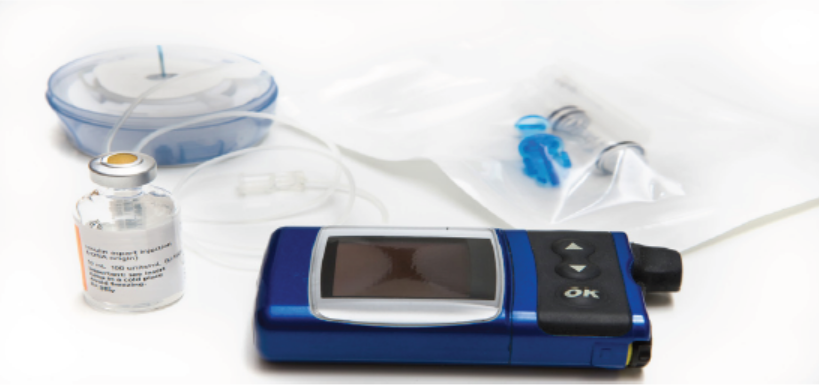
Insulin is injected through the skin into the fatty tissue known as the subcutaneous
layer. It shouldn’t go into muscle or directly into the blood, as this changes how
quickly the insulin is absorbed and works. Absorption of insulin varies dependingon where in the body it is injected.
• The abdomen absorbs insulin the fastest and is used by most people.
• The upper arms, buttocks and thighs have a slower absorption rate and can
also be used.
• The proper technics is to Pinch the skin up and use a 90-degree angle. The
best angle for a thin person is 90 degrees with the skin pinched up.
• The area is not massaged and it is not necessary to warm it.
• Injections are made into the subcutaneous tissue. Most individuals are able tolightly grasp a fold of skin, release the pinch, then inject at a 90° angle.
Factors affecting insulin absorption
Variation in insulin absorption can cause changes in blood glucose levels. Insulin
absorption is increased by:
• Injecting into an exercised area such as the thighs or arms, and the abdomen
is used for a more consistent absorption
• High temperatures due to a hot shower, bath, hot water bottle, spa or sauna
• Massaging the area around the injection site
• Injecting into muscle – this causes the insulin to be absorbed more quickly
and could cause blood glucose levels to drop too low.
Insulin absorption can be delayed by:
• Over-use of the same injection site, which causes the area under the skin to
become lumpy or scarred (known as lipohypertrophy)
• Insulin that is cold (for example, if insulin is injected immediately after taking
it from the fridge)• Cigarette smoking.
Insulin storage
Insulin needs to be stored correctly. This includes:
• Store unopened insulin on its side in a fridge.
• Keep the fridge temperature between 2 and 8 °C.
• Make sure that insulin does not freeze.
• Once opened, keep it at room temperature (less than 25 °C) for not more than
one month and then dispose of it safely.
• Avoid keeping insulin in direct sunlight.
Extreme (hot or cold) temperatures can damage insulin so it doesn’t work properly.
It must not be left where temperatures are over 30 °C. In summer your car can getthis hot (above 30 °C) so don’t leave your insulin there.
Insulin safety
All insulin should be checked for expiration date and clearness. Insulin should not
be given if it appears cloudy, Vials should not be shaken but rotated in between
the hands to mix contents, the vial in use can be stored at room temperature. Vials
should not be put in glove. compartments, suitcases, or trunks. If regular insulin
is to be mixed with NPH or Lente insulin, the regular insulin should be drawn into
the syringe first. Record of blood glucose levels and insulin doses it is important
and keeping a record of blood glucose levels helps the patient and your healthcare
professional to know when the insulin dosage needs adjustment.
When the patient is using insulin, the nurse has responsibility to educate and
support the patient about the following:
• The type and action of your insulin
• How, where and when to inject insulin
• How to rotate injection sites
• Where to get your insulin and how to store it safely
• How to manage low blood glucose
• How to keep a record of your blood glucose levels and insulin dose
Other medication used in case of diabetes
Additional medications also may be prescribed for people with diabetes milletu ,
such as:
High blood pressure medications: Angiotensin-converting enzyme (ACE)
inhibitors or angiotensin II receptor blockers (ARBs) for patients with diabetes who
have blood pressures above 140/90 millimetres of mercury (mm Hg).
Aspirin: junior or regular aspirin daily to protect the heart when there is an increased
risk for a cardiovascular event, but if there is no the potential risk of bleeding.
Cholesterol-lowering drugs as patients with diabetes have a higher risk of increasein cholesterol and elevated risk of heart disease.
Self-assessment 3.8
1) When is insulin indicated?
a) For treating hypoglycemia
b) Patient with diabetes ketoacidosis
c) Patient with high blood pressure
d) For a patient with high cholesterol
2) What is the most common route of administration of insulin?
a) Oral
b) Intra-rectal
c) Subcutaneous
d) Intradermal
3) Nurse A. is given a report on a patient who is going to start insulin therapy.
She is wondering the appropriate site where she will inject the prescribed
insulin. The correct answer will be:
a) On abdomen subcutaneously
b) Abdomen intramuscularly
c) On the back intramuscularlyd) On the back subcutaneously
3.9. Nursing considerations during diabetes mellitusdrug therapy
Learning Activity 3.9
1) Patient X, a 18-year-old female, a hard working chef accountant who
stays long time in the office presents to the health centre with complaints
of polydipsia, polyphagia, and fatigue for the past month, while she takes
antidiabetic medication regularly. The patient reveals that she has had
diabetes for the past 2 years, and likes to take often carbohydrates on
every serving of food. Which of the following nursing considerations
should the associate student nurse in the clinical placement take intoaccount while assessing this patient?
a) Do not focus on the nutritional intake as it usually has no effect on the
anticipated response to insulin therapy.
b) Monitor the patient’s food intake and ensure that the patient eats when
using insulin to ensure therapeutic effect and avoid hypoglycemia.
c) Monitor the patient’s food intake and ensure that the patient avoids any
kind of eating when using insulin as it can limit its effectiveness.
d) Focus on the nutritional intake and encourage the patient to keep taking
a lot of carbohydrates to increase the effectiveness of insulin.
2) Which the following discharge notes should the nurse include in the client
teaching for a type 1 patient who uses insulin?
a) Self-inject insulin at home by the subcutaneous route only, and rotate
injection sites regularly
b) Self-inject insulin at home by the intramuscular route only, and rotate
injection sites regularly
c) Self-inject insulin at home by the intramuscular route only, and never
rotate injection sites
d) Self-inject insulin at home by the subcutaneous route only, and neverrotate injection sites
CONTENT SUMMARY
During care of patient with diabetes under medication, nurses should provide
accurate and up-to-date information about the patient’s condition so that the healthcare
team can come up with appropriate interventions and management.A nurse will assess the following:
Assess for contraindications or cautions: any known allergy to any insulin and
current status of pregnancy or lactation so that appropriate monitoring and dose
adjustments can be completed, including possible need to use animal-source
insulin. Perform a physical assessment to establish a baseline before beginning
therapy, and during therapy to evaluate the effectiveness of therapy and for any
potential adverse effects. Assess for presence of any skin lesions; orientation and
reflexes; baseline pulse and blood pressure; respiration or adventitious breath
sounds, which could indicate response to high or low glucose levels and potentialrisk factors in giving insulin.
Assess body systems for changes suggesting possible complications associatedwith poor blood glucose control. Investigate nutritional intake, noting any problems
with intake and adherence to prescribed diet that could alter the anticipatedresponse to insulin therapy.
Assess activity level, including amount and degree of exercise, which could alteranticipated response to insulin therapy.
Inspect skin areas that will be used for injection of insulin; note any areas that
are bruised, thickened, or scarred, which could interfere with insulin absorption
and alter anticipated response to insulin therapy. Obtain blood glucose levels as
ordered to monitor response to insulin and need to adjust dose as needed. Monitorthe results of laboratory tests, including urinalysis, for evidence of glycosuria.
The nurse will also:
Ensure that the patient is following a dietary and exercise regimen and using good
hygiene practices to improve the effectiveness of the insulin and decrease adverse
effects of the disease. Gently rotate the vial containing the agent and avoid vigorous
shaking to ensure uniform suspension of insulin.
Select a site that is free of bruising and scarring to ensure good absorption of the
insulin.
Give maintenance doses by the subcutaneous route only, and rotate injection sites
regularly to avoid damage to muscles and to prevent subcutaneous atrophy. Give
regular
insulin intramuscularly or intravenously in emergency situations.
Monitor response carefully to avoid adverse effects; blood glucose monitoring is the
most effective way to evaluate insulin dose.
Monitor the patient for signs and symptoms of hypoglycemia, especially during
peak insulin times, when these signs and symptoms would be most likely to appear,
to assess the response to insulin and the need for dose adjustment or medical
intervention.
Always verify the name of the insulin being given because each insulin has a
different peak and duration, and the names can be confused.
Use caution when mixing types of insulin; administer mixtures of regular and NPH
insulins within 15 minutes after combining them to ensure appropriate suspension
and therapeutic effect.
Store insulin in a cool place away from direct sunlight to ensure effectiveness.
Predrawn syringes are stable for 1 week if refrigerated; they offer a good way toensure the proper dose for patients who have limited vision.
Monitor the patient during times of trauma or severe stress for potential dose
adjustment needs.
Monitor the patient’s food intake; ensure that the patient eats when using insulin toensure therapeutic effect and avoid hypoglycemia.
Monitor the patient’s exercise and activities; ensure that the patient considers the
effects of exercise in relationship to eating and insulin dose to ensure therapeuticeffect and avoid hypoglycemia
Protect the patient from infection, including good skin care and foot care, to prevent
the development of serious infections and changes in therapeutic insulindoses.
Monitor the patient’s sensory losses to incorporate his or her needs into safetyissues, as well as potential problems in drawing up and administering insulin.
Help the patient to deal with necessary lifestyle changes, including diet and
exercise needs, sensory loss, and the impact of a drug regimen that includes givinginjections, to help encourage compliance with the treatment regimen.
Instruct patients who are also receiving beta-blockers about ways to monitor glucose
levels and signs and symptoms of glucose abnormalities to prevent hypoglycemicand hyperglycemic episodes when SNS and warning signs are blocked.
Provide thorough patient teaching, including diet and exercise needs; measures
to avoid adverse effects, including proper food care and screening for injuries;
warning signs of problems, including signs and symptoms of hypoglycemia and
hyperglycemia; the importance of increased screening when ill or unable to eat
properly; proper administration techniques and proper disposal of needles andsyringes; and the need
to monitor disease status, to enhance patient knowledge about drug therapy andpromote compliance.
The nurse will evaluate the following
Monitor patient response to the drug (stabilization of blood glucose levels).
Monitor for adverse effects (hypoglycemia, ketoacidosis, and injection-site
irritation).
Evaluate the effectiveness of the teaching plan (patient can name drug,
dosage, adverse effects to watch for, specific measures to avoid them, and
proper administration technique).Monitor the effectiveness of comfort measures and compliance with the regimen.
Self-assessment 3.9
A nurse R is assigned to manage a patient for whom antidiabetic medications
are going to be initiated.
1) Which statement is correct about the nursing assessment before initiation
of antidiabetic administration?
a) Assess for contraindications or cautions
b) Assess the drug effect
c) Assess for the side effects
d) Monitor sensory losses
2) Which statement is NOT CORRECT about the nursing evaluation after
antidiabetic administration?
a) Evaluate the drug’s effectiveness
b) Evaluate for the side effects
c) Evaluate contraindicationsd) Evaluate the blood glucose levels
3.10. National treatment guidelines for diabetes mellitus
Learning Activity 3.10
The patient diagnosed of type 2 diabetes mellitus, and was admitted in Medical
unit in the hospital where most of health care providers were new and studied
outside of the country. The nurse had heard that the patient was shifted to the
third line of antidiabetic drugs but doesn’t know about the national guideline. The
latter wants the guidance from the matron.
1) Which information do you expect to be delivered by the matron?Guidance: Use the national guideline for NCDs book in Rwanda 2016
CONTENT SUMMARY
Management of type 1 Diabetes
Anyone who has type 1 diabetes needs lifelong insulin therapy. Treatment for type
1 diabetes includes: Taking insulin; carbohydrate, fat and protein counting; eating
healthy foods; frequent blood sugar monitoring; exercising regularly and maintaining
a healthy weight.
Management of type 2 Diabetes (Oral Therapy)
Management of type 2 Diabetes is based on Lifestyle and observe measures:
Healthy diet, physical activity, avoid /decrease alcohol, weight control. In addition to
lifestyle modification, the patients are started on oral antidiabetic drugs.Table 3.10.1: First Line
Glimepiride is alternative of Glibenclamide when there is frequent hypoglycemia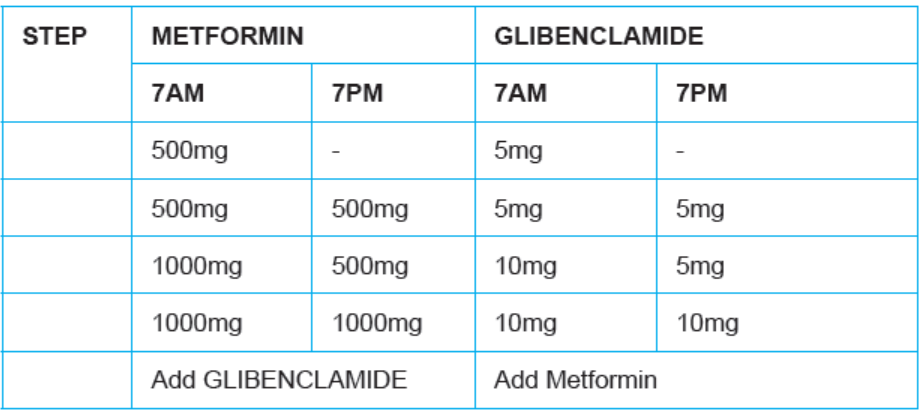
with Glibenclamide,1 or 2 mg given orally once daily with breakfast or the first major
meal of the day.
The dose may be increased by 1-2 mg in 1-2 weeks’ interval up to 4 mg maximum
based on blood sugar response and is given once daily.
Second Line
If despite adequate titration of doses of medication blood glucose targets are not
being attained after 6 months at the most (HbA1C should fall at least by 1% or
persistent hyperglycemia of more than 180mg/dl in the past 3 months). Check the
patient’s adherence (understanding of medical and self-management, reinforcement
of lifestyle factors influencing health and fitness targets). Exclude other conditions
that can disturb glycaemic control (e.g., steroids).
In addition to lifestyle measures, adherence to medication and dose Optimization
add
Vildagliptin (50mg) + Metformin (850 or 1000mg) Twice/day.Third line
On third line in addition to lifestyle measures, adherence to medication and dose
optimization. Give in preference Metformin (if tolerated) + Basal (long acting)Insulin. Add Prandial (short acting) with time if required.
Self-assessment 3.10
1) According to the national guide line for NCDs, which drug is given as first
line to treat a patient with diabetes type 2?
a) Glibenclamide
b) Insulin
c) Amoxicillin
d) Vildagliptin
2) According to the national guide line for NCDs, which drug is given as
second line to treat a patient with diabetes type 2?
a) Insulin+ metformin
b) Vildagliptin + Metformin
c) Glibenclamide+ Glucophaged) Insulin+ Glibenclamide
3.11. Anti-inflammatory drugs in asthma management
Learning Activity 3.11
Read the scenario below and answer the related questions.
During your clinical practice you receive a client in consultation room. The client
reports that he is taking anti-asthmatic drugs. Visit the library or use internet andcome with:
1) List classes of anti-asthmatic drugs
2) List four types of inhalation devices use when administering anti-asthmatic
drug by inhalation
3) Give two examples of drugs fall into Anti-inflammatory anti-asthmaticclass.
CONTENT SUMMARY
Asthma is a common chronic inflammatory disorder characterized by breathlessness
and tightness in the chest, together with wheezing, dyspnea, and cough. The
underlying cause is immune-mediated airway inflammation.
Anti-asthmatic drugs fall into two main pharmacologic classes: Anti-inflammatoryagents mainly the glucocorticoids, and bronchodilators mainly ,beta2 agonists .
For chronic asthma, glucocorticoids are administered on a fixed schedule, almost
always by inhalation. Beta2 agonists may be administered on a fixed schedule (for
long-term control) or PRN (to manage an acute attack). Like the glucocorticoids,
beta2 agonists are usually inhaled.
Most anti-asthma drugs can be administered by inhalation. This route has three
advantages:
1) Therapeutic effects are enhanced by delivering drugs directly to their site of
action,
2) Systemic effects are minimized, and3) Relief of acute attacks is rapid.
Inhalation Devices
Four types of inhalation devices are employed: metered-dose inhalers, Respimats,
dry-powder inhalers, and nebulizers.
Metered-Dose Inhalers (MDIs): are small, hand-held, pressurized devices that
deliver a measured dose of drug with each actuation. Dosing is usually accomplishedwith one or two inhalations.
Dry-Powder Inhalers (DPIs) are used to deliver drugs in the form of a dry, micronized
powder directly to the lungs.
A nebulizer: is a small machine used to convert a drug solution into a mist. The
droplets in the mist are much finer than those produced by inhalers, resulting in
less drug deposit on the oropharynx and increased delivery to the lung. Inhalation
of the nebulized mist can be done through a face mask or through a mouthpieceheld between the teeth.
Steroidal Anti-Inflammatory Drugs
The anti-inflammatory drugs, especially inhaled glucocorticoids are the foundation
of asthma treatment. These drugs are taken daily for long-term control.
The drugs used to affect inflammation are the inhaled steroids, the leukotriene
receptors, and a mast cell stabilizer, which can affect both bronchodilator and
inflammation.
1. INHALED STEROIDS
Inhaled steroids have been found to be a very effective treatment for bronchospasm.
Agents approved for this use include beclomethasone (Beclovent and others),
budesonide (Pulmicort), ciclesonide (Alvesco), fluticasone (Flovent), and
triamcinolone (Azmacort and others). The drug of choice depends on the individual
patient’s response; a patient may have little response to one agent and do very well
on another. It is usually useful to try another preparation if one is not effective within
2 to 3 weeks.
Therapeutic Actions and Indications: Inhaled steroids are used to decrease the
inflammatory response in the airway. They have two main effects: Decreased swelling
associated with inflammation and promotion of beta-adrenergic receptor activity,
which may promote smooth muscle relaxation and inhibit bronchoconstriction.
Pharmacokinetics: These drugs are rapidly absorbed from the respiratory tract,
but they take from 2 to 3 weeks to reach effective levels, and so patients must be
encouraged to take them to reach and then maintain the effective levels. They are
metabolized by natural systems, mostly within the liver, and are excreted in urine.The glucocorticoids are known to cross the placenta and to enter breast milk.
Contraindications and Cautions: Inhaled steroids are not for emergency use and
not for use during an acute asthma attack or status asthmaticus. They should not
be used during pregnancy or lactation.
Adverse Effects: Adverse effects are limited because of the route of administration.
Sore throat, hoarseness, coughing, dry mouth, and pharyngeal and laryngeal fungal
infections are the most common side effects encountered. If a patient does not
administer the drug appropriately or develops lesions that allow absorption of the
drug, the systemic side effects associated with steroids may occur.Table 3.11.1: Inhaled steroids

2. Leukotriene Receptor Antagonists
This is a newer class of drugs, the leukotriene receptor antagonists, was developed
to act more specifically at the site of the problem associated with asthma. Because
this class is relatively new, long-term effects and the benefits of one drug over
another have not yet been determined.
Examples: Zafirlukast (Accolate) ,Montelukast (Singulair) and zileuton (Zyflo)
Therapeutic Actions and Indications: Leukotriene receptor antagonists selectively
and competitively block (zafirlukast, montelukast) or antagonize (zileuton) receptorsfor the production of leukotrienes. As a result, these drugs block many of the signs
and symptoms of asthma, such as neutrophil and eosinophil migration, neutrophil
and monocyte aggregation, leukocyte adhesion, increased capillary permeability,
and smooth muscle contraction. These factors contribute to the inflammation,
edema, mucus secretion, and bronchoconstriction seen in patients with asthma.
Pharmacokinetics: These drugs are given orally. They are rapidly absorbed from
the GI tract. Zafirlukast and montelukast are extensively metabolized in the liver
by the cytochrome P450 system and are primarily excreted in feces. Zileuton is
metabolized and cleared through the liver. These drugs cross the placenta and
enter breast milk (see Contraindications and Cautions).
Contraindications and Cautions: These drugs should be used cautiously in
patients with hepatic or renal impairment , these drugs should be used during
pregnancy only if the benefit to the mother clearly outweighs the potential risks
to the fetus. No adequate studies have been done on the effects on the baby if
these drugs are used during lactation; caution should be used. These drugs are
not indicated for the treatment of acute asthmatic attacks, because they do not
provide any immediate effects on the airways. Patients need to be cautioned that
they should not rely on these drugs for relief from an acute asthmatic attack
Adverse Effects: Adverse effects associated with leukotriene receptor antagonists
include headache, dizziness, nausea, diarrhea, abdominal pain, elevated liver
enzyme concentrations, vomiting, generalized pain, fever, and myalgia. Because
these drugs are relatively new, there is little information about their long-term
effects. Patients should be advised to monitor their use of these drugs and to report
any increase of acute episodes or lack of response to the drug, which could indicate
a worsening problem or decreased responsiveness to drug therapy
Clinically Important Drug–Drug Interactions
Use caution if propranolol, theophylline, terfenadine, or warfarin is taken with these
drugs because increased toxicity can occur. Toxicity may also occur if these drugs
are combined with calcium channel blockers, cyclosporine, or aspirin; decreaseddose of either drug may be necessary.
Table 3.11.2: Leukotriene Receptor Antagonists
3. Mast Cell Stabilizer
A mast cell stabilizer prevents the release of inflammatory and bronchoconstricting
substances when the mast cells are stimulated to release these substances
because of irritation or the presence of an antigen. Cromolyn (Nasacort) is the only
drug still available in this class, only available in an over-the-counter form, and it is
no longer considered part of the treatment standards because of the availability of
more specific and safer drugs.
CROMOLYN
Cromolyn is an inhalational agent that suppresses bronchial inflammation. The drug
is used for prophylaxis—not quick relief in patients with mild to moderate asthma.
Anti-inflammatory effects are less than with glucocorticoids; therefore, cromolyn is
not a preferred drug for asthma therapy. When glucocorticoids create problems,
however, cromolyn may be prescribed as alternative therapy.
Mechanism of Action: Cromolyn suppresses inflammation; it does not cause
bronchodilation. The drug acts in part by stabilizing the cytoplasmic membrane
of mast cells, preventing release of histamine and other mediators. In addition,
cromolyn inhibits eosinophils, macrophages, and other inflammatory cells.
Pharmacokinetics: Cromolyn is administered by nebulizer. The fraction absorbed
from the lungs is small and rarely produces significant systemic effects. Absorbed
cromolyn is excreted unchanged in the urine.
Therapeutic Uses
Chronic asthma: Cromolyn is an alternative to inhaled glucocorticoids for
prophylactic therapy of asthma. When administered on a fixed schedule, cromolyn
reduces both the frequency and intensity of asthma attacks. Maximal effects may
take several weeks to develop. No tolerance to effects is seen with long-term use.
Cromolyn is especially effective for prophylaxis of seasonal allergic attacks and
for acute allergy prophylaxis immediately before allergen exposure (e.g., before
mowing the lawn).
Adverse Effects: Cromolyn is the safest of all antiasthma medications. Significant
adverse effects occur in fewer than 1 of every 10,000 patients. Occasionally, cough
or bronchospasm occurs in response to cromolyn inhalation.
Preparations, Dosage, and Administration
Cromolyn is administered using a power-driven nebulizer. The initial dosage for
adults and children is 20 mg 4 times a day. For maintenance therapy, the lowesteffective dosage should be established.
NURSING CONSIDERATIONS FOR PATIENTS RECEIVING STEROIDAL ANTIINFLAMMATORYDRUGS
Before, during and after administration of steroidal anti-inflammatory drugs, a nurse
the following are nurse’s considerations:
Assessment
• Assess for possible contraindications or cautions
• Perform a physical examination to establish baseline.
• Assess vital signs and parameters
• Examine the nares to evaluate for any lesions that might lead to systemic
absorption of the drug
• Evaluate liver and renal function tests to assess for impairments that could
interfere with metabolism or excretion of the drugs.
• Perform an abdominal evaluation to monitor gastrointestinal (GI) effects of
the drug
Also the nurse will implement the following:
Taper systemic steroids carefully during the transfer to inhaled steroids; deaths
have occurred from adrenal insufficiency with sudden withdrawal.
Do not administer inhaled steroid to treat an acute asthma attack or status
asthmaticus because these drugs are not intended for treatment of acute attack
and will not provide the immediate relief that is needed.
Have the patient use decongestant drops before using the inhaled steroid to
facilitate penetration of the drug if nasal congestion is a problem.
Have the patient rinse the mouth after using the inhaler because this will help to
decrease systemic absorption and decrease gastrointestinal (GI) upset and nausea.
Monitor the patient for any sign of respiratory infection; continued use of steroids
during an acute infection can lead to serious complications related to the depression
of the inflammatory and immune responses.
Provide thorough patient teaching, including the drug name and prescribed dosage,
measures to help avoid adverse effects, warning signs that may indicate problems,
and the need for periodic monitoring and evaluation, to enhance patient knowledge
about drug therapy and to promote compliance
Instruct the patient to continue to take the drug to reach and then maintain effective
levels (drug takes 2 to 3 weeks to reach effective levels).
Offer support and encouragement to help the patient cope with the disease and the
drug regimen. Administer drug on an empty stomach, 1 hour before or 2 hours after
meals; the bioavailability of these drugs is decreased markedly by the presence of
food.
Caution the patient that these drugs are not to be used during an acute asthmatic
attack or bronchospasm; instead, regular emergency measures will be needed.
Caution the patient to take the drug continuously and not to stop the medication
during symptom free periods to ensure that therapeutic levels are maintained.
Provide appropriate safety measures if dizziness occurs to prevent patient injury.
Urge the patient to avoid over-the-counter preparations containing aspirin, which
might interfere with the effectiveness of these drugs.
Provide thorough patient teaching, including the drug name and prescribed dosage,
measures to help avoid adverse effects, warning signs that may indicate problems,
and the need for periodic monitoring and evaluation, to enhance patient knowledge
about drug therapy and to promote compliance.
Offer support and encouragement to help the patient cope with the disease and the
drug regimen.
The nurse monitors the following:
• Monitor patient response to the drug (improved breathing).
• Monitor for adverse effects (nasal irritation, fever, GI upset).
• Evaluate the effectiveness of the teaching plan (patient can name drug,
dosage, adverse effects to watch for, specific measures to avoid them, and
measures to take to increase the effectiveness of the drug).
• Monitor the effectiveness of other measures to ease breathing
• Monitor patient response to the drug (improved breathing).
• Monitor for adverse effects (drowsiness, headache, abdominal pain, myalgia).
• Evaluate the effectiveness of the teaching plan (patient can name drug,
dosage, adverse effects to watch for, specific measures to avoid them, and
measures to take to increase the effectiveness of the drug).• Monitor the effectiveness of other measures to ease breathing
Self-assessment 3.11
1) Most anti-asthma drugs can be administered by inhalation. List three
advantages of administering anti-asthmatic drugs by inhalation.
2) The main anti-inflammatory drugs used in treatment of asthma are ……
3) Patient was consulted at health post for asthma crises arriving at the
health post. The Patient met with associate nurse student G who was
in clinical placement mentored by senior nurse in the service. When the
senior nurse requested the student G to provide treatment to the patient,
the student should reflect on different classes of anti-asthmatic drugs
available to treat the asthma and she found at the health post were only
anti-inflammation drugs .
What should be the nursing evaluation during the use of this anti-inflammatory
drugs ?
3.12. Bronchodilator antiasthmatics
Learning Activity 3.12
During your clinical practice, you receive a client with signs and symptoms of
asthma.
You hear senior nurse saying that he patient will be administered an antiasthmatic
drug that belongs to bronchodilators classes.
Using pharmacology book or internet
1) How do anti-asthmatic bronchodilators facilitate respiration to treat
asthma2) Give three groups of bronchodilator anti-asthmatic drugs
CONTENT SUMMARY
Bronchodilator anti-asthmatics are medications used to facilitate respirations by
dilating the airways. They are helpful in symptomatic relief or prevention of bronchial
asthma and for bronchospasm associated with COPD.
Bronchodilators include xanthines, sympathomimetics, and anticholinergics.
1) XANTHINES
The xanthines have a direct effect on the smooth muscles of the respiratory
tract, both in the bronchi and in the blood vessels. They include aminophylline
(Truphylline), caffeine (Caffedrine and others), dyphylline (Dilor and others), and
theophylline (Slo-Bid, Theo-Dur). They have a relatively narrow margin of safety
and interact with many other drugs, they are no longer considered the first-choice
bronchodilators.
Therapeutic Actions and Indications: Xanthines work by directly affecting the
mobilization of calcium within the cell. They do this by stimulating two prostaglandins,
resulting in smooth muscle relaxation, which increases the vital capacity that has
been impaired by bronchospasm or air trapping.
Also, they inhibit the release of slow reacting substance of anaphylaxis (SRSA) and
histamine, decreasing the bronchial swelling and narrowing that occurs as a result
of these two chemicals for usual indications for these drugs.
Pharmacokinetics: The xanthines are rapidly absorbed from the gastrointestinal
(GI) tract when given orally, reaching peak levels within 2 hours. They are also
given IV, reaching peak effects within minutes. They are widely distributed and
metabolized in the liver and excreted in urine. Xanthines cross the placenta and
enter breast milk
Contraindications and Cautions: Caution should be taken with any patient with
GI problems, coronary disease, respiratory dysfunction, renal or hepatic disease,
alcoholism, or hyperthyroidism because these conditions can be exacerbated by
the systemic effects of xanthines.
Adverse Effects: Adverse effects associated with xanthines are related to
theophylline levels in the blood. Therapeutic theophylline levels are from 10 to
20mcg/mL. With increasing levels, predictable adverse effects are seen, ranging
from GI upset, nausea, irritability, and tachycardia to seizures, brain damage, andeven death.
Xanthines

2) SYMPATHOMIMETICS
Table 3.12.1: Sympathomimetics
Sympathomimetics are drugs that mimic the effects of the sympathetic nervous
system that include the dilation of the bronchi with increased rate and depth of
respiration. The sympathomimetics that are used as bronchodilators include
albuterol/salbutamol (Proventil and others), arformoterol (Brovana), bitolterol
(Tornalate), ephedrine (generic), epinephrine (EpiPen), formoterol (Foradil),indacaterol (Arcapta), isoetharine (generic), isoproterenol (Isuprel and others),
levalbuterol (Xopenex), metaproterenol (Alupent), pirbuterol (Maxair), salmeterol
(Serevent), and terbutaline (Brethaire and others).
The therapeutic Actions and Indications: Most of the sympathomimetics used
as bronchodilators are beta2-selective adrenergic agonists, beta2- receptors found
in the bronchi,other systemic effects of sympathomimetics include increased blood
pressure, increased heart rate, vasoconstriction, and decreased renal and GI blood
flow—all actions of the sympathetic nervous system
Pharmacokinetics: Sympathomimetics available only as an inhalant include the
arformoterol, formoterol, indacaterol, isoetharine, levalbuterol, pirbuterol, and
salmeterol. They vary in their duration of action, long-acting beta adrenergics have
half-lives between 45 and 126 hours.
Other sympathomimetics are available in various forms. Albuterol and metaproterenol
are available in inhaled and oral forms. Terbutaline can be used as an inhalant and
as an oral and parenteral agent. Isoproterenol is available for intravenous use.
Ephedrine is used orally and in parenteral form (for IV, IM, and subcutaneous use).
These drugs are rapidly distributed after injection; they are transformed in the liver
to metabolites that are excreted in the urine. The half-life of these drugs is relatively
short—less than 1 hour.
They are known to cross the placenta and to enter breast milk.The inhaled drugs
are rapidly absorbed into the lung tissue. Although very little of the drug is absorbed
systemically, any absorbed drug will still be metabolized in the liver and excretedin urine
Contraindications and Cautions: These drugs are contraindicated or should
be used with caution, depending on the severity of the underlying condition, in
conditions that would be aggravated by the sympathetic stimulation, including
cardiac disease, vascular disease, arrhythmias, diabetes, and hyperthyroidism.
These drugs should be used during pregnancy and lactation only if the benefits to
the mother clearly outweigh potential risks to the fetus or neonate.
Adverse Effects: Central nervous system stimulation, GI upset, cardiac arrhythmias,
hypertension, bronchospasm, sweating, pallor, and flushing. Isoproterenol isassociated with more cardiac side effects than some other drugs.
Table 3.12.2: Sympathomimetics

1) ANTICHOLINERGIC ANTI-ASTHMATIC DRUGS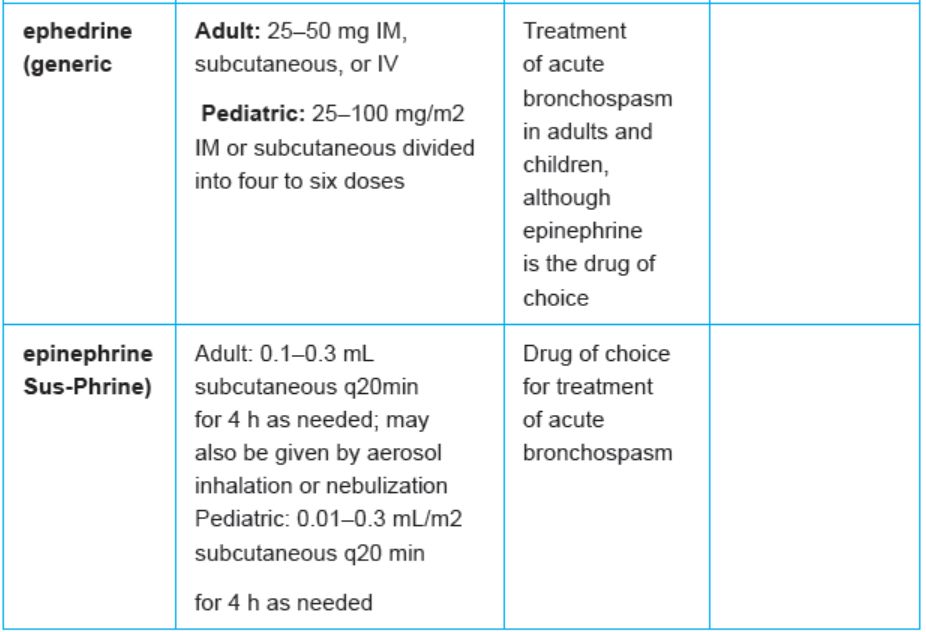
Patients who cannot tolerate the sympathetic effects of the sympathomimetics might
respond to the anticholinergic drugs ipratropium (Atrovent) and tiotropium (Spiriva).
These drugs are not as effective as the sympathomimetics but can provide some
relief to those patients who cannot tolerate the other drugs. Tiotropium is the first
drug approved for once-daily maintenance treatment of bronchospasm associated
with COPD.
Therapeutic Actions and Indications: Anticholinergics are used as bronchodilators
because of their effect on the vagus nerve, which is to block or antagonize the
action of the neurotransmitter acetylcholine at vagal-mediated receptor sites.
Normally, vagal stimulation results in a stimulating effect on smooth muscle, causing
contraction. By blocking the vagal effect, relaxation of smooth muscle in the bronchi
occurs, leading to bronchodilation.
Pharmacokinetics: These drugs are available for inhalation, using an inhaler
device. Ipratropium is also available as a nasal spray for seasonal rhinitis.
Ipratropium has an onset of action of 15 minutes when inhaled. Its peak effects
occur in 1 to 2 hours, and it has a duration of effect of 3 to 4 hours. Little is known
about its fate in the body. It is generally not absorbed systemically. Tiotropium has a
rapid onset of action and a long duration, with a half-life of 5 to 6 days. It is excreted
unchanged in urine.
Contraindications and Cautions: Caution should be used in any condition that
would be aggravated by the anticholinergic or atropine-like effects of the drug,
such as narrow-angle glaucoma (drainage of the vitreous humor can be blocked
by smooth muscle relaxation), bladder neck obstruction or prostatic hypertrophy
(relaxed muscle causes decreased bladder tone), and conditions aggravated
by dry mouth and throat. The use of ipratropium or tiotropium is contraindicated
in the presence of known allergy to the drug or to soy products or peanuts (the
vehicle used to make ipratropium an aerosol contains a protein associated with
peanut allergies) to prevent hypersensitivity reactions. These drugs are not usually
absorbed systemically, but as with all drugs, caution should be used in pregnancy
and lactation because of the potential for adverse effects on the fetus or nursing
baby.
Adverse Effects: Adverse effects are related to the anticholinergic effects of the
drug if it is absorbed systemically. These effects include dizziness, headache,
fatigue, nervousness, dry mouth, sore throat, palpitations, and urinary retention
Clinically Important Drug–Drug Interactions: There is an increased risk of
adverse effects if these drugs are combined with any other anticholinergics; thiscombination should be avoided.
Table 3.12.3: Anticholinergics
Nursing Considerations for Patients Receiving bronchodilators
• Assess for possible contraindications or cautions.
• Perform a physical examination to establish baseline data for assessing
the effectiveness of the drug and the occurrence of any adverse effects
associated with drug therapy.
• Assess reflexes and orientation to evaluate central nervous system (CNS)
effects of the drug.
• Assess the skin color and lesions to assess for dryness or allergic reaction
and to evaluate oxygenation.
• Evaluate orientation, affect, and reflexes to evaluate central nervous system
(CNS) effects.
• Assess pulse and blood pressure to monitor cardiovascular effects of the
drug.
• Evaluate respirations and adventitious sounds to monitor drug effectiveness
and possible adverse effects.
• Evaluate urinary output and prostate palpation as appropriate to monitor
anticholinergic effects (anticholinergic drugs)
• Monitor respirations and adventitious sounds to establish a baseline for drug
effectiveness and possible adverse effects.
• Evaluate pulse, blood pressure, and, in certain cases, a baseline
electrocardiogram to monitor the cardiovascular effects of sympathetic
stimulation.
• Evaluate liver function tests to assess for changes that could interfere with
metabolism of the drug and require dose adjustment.
• Ensure adequate hydration and provide environmental controls, such as the
use of a humidifier, to make the patient more comfortable.
• Encourage the patient to void before each dose of medication to prevent
urinary retention related to drug effects.
• Provide safety measures if CNS effects occur to prevent patient injury.
• Provide small, frequent meals and sugarless lozenges to relieve dry mouth
and GI upset.
• Advise the patient not to drive or use hazardous machinery if nervousness,
dizziness, and drowsiness occur with this drug to prevent injury.
• Provide thorough patient teaching, including the drug name and prescribed
dosage, measures to help avoid adverse effects, warning signs that may
indicate problems, and the need for periodic monitoring and evaluation, to
enhance patient knowledge about drug therapy and to promote compliance.
• Review the use of the inhalator with the patient; caution the patient not to
exceed 12 inhalations in 24 hours to prevent serious adverse effects.
• Offer support and encouragement to help the patient cope with the disease
and the drug regimen
• Reassure patient that the drug of choice will vary with each individual.
The sympathomimetics are slightly different chemicals and are prepared
in a variety of delivery systems. A patient may have to try several different
sympathomimetics before the most effective one is found.
• Advise the patient to use the minimal amount needed for the shortest period
necessary to prevent adverse effects and accumulation of drug levels.
• Teach patients who use one of these drugs for exercise-induced asthma to
use it 30 to 60 minutes before exercising to ensure peak therapeutic effects
when they are needed.
• Alert patient that long-acting adrenergic blockers are not for use during acute
attacks because they are slower acting and will not provide the necessary
rescue in a state of acute bronchospasm.
• Provide safety measures as needed if CNS effects become a problem to
prevent patient injury.
• Provide small, frequent meals and nutritional consultation if GI effects interfere
with eating to ensure proper nutrition.
• Provide thorough patient teaching, including the drug name and prescribed
dosage, measures to help avoid adverse effects, warning signs that may
indicate problems, and the need for periodic monitoring and evaluation, toenhance patient knowledge about drug therapy and to promote compliance.
Carefully teach the patient about proper use of the prescribed delivery
system. Review that procedure periodically because improper use may result
in ineffective therapy
Self-assessment 3.12
1) Which of the following drugs is a xanthine?
a) Amoxicillin
b) Beclomethasone
c) Aminophylline
d) Epinephrine
2) Which of the following drugs belongs to the class of sympathomimetic
anti asthmatic drugs?
a) Amoxycilline
b) Beclomethasone
c) Aminophylline
d) Epinephrine
5) During clinical practice, you receive a client with severe episode of
asthma attack. After the assessment, the nurse recommends you to give
aminophylline via IV route instead of oral route.
Explain why the nurse chose the IV route instead of oral route.
3.13. National treatment guidelines for asthma
Learning Activity 3.13
The patient with known with simple intermittent episodes of asthma comes to
the health facility where you are conducting the clinical practice as an associate
nurse student. The patient has developed as a simple asthma attack that needs
management. The nurse tasks you to manage the patient with reference to the
Rwanda national guidelines of asthma management.
1) Which of the following management options may be instituted for this
patient?
a) Use an inhaled short-acting beta2 agonist (SABA) for quick relief.
b) Use an inhaled glucocorticoid for quick relief of the asthma attack
c) Use salbutamol, beclamethasone and aminophylline for quick relief.
d) Use a combination of beclamethasone and aminophylline for quick
relief.
2) After two days later, the patient comes with complicated episode of asthma
attack and a deep assessment classifies that patient to be managed by
step 2 in the national guidelines of asthma management. Which of the
following drugs may be used?
a) Beclamethasone and aminophylline
b) Salbutamol and aminophylline
c) Salbutamol and beclamethasone
d) Beclamethasone and amoxicillin
CONTENT SUMMARY
Use Respiratory emergency method to treat asthma
If a patient is having an asthma attack, then classify severity based on IUATLD(International Union Against Tuberculosis and Lung Disease) guidelines below:
Table 3.13.1: asthma attack classification
• Position upright, give continuous salbutamol nebulizer, administer I.V
hydrocortisone 100 mg or prednisolone po 60mg if I.V not available.
• Oxygen by facial mask 6l/min if O2 saturation is magnesium 2g IV x 1.
• Give amoxicillin 500mg PO x 1 if pneumonia suspected.
• Give furosemide 40mg IV x 1 if HF suspected.
• Call physician and admit to hospital.
• Intubation if decreased level of consciousness, exhaustion, silent chest,
acidemia, cyanosis.
• Directed therapy if the triggering factor is evident: e.g antibiotics in case of
infection.
Use the step method to treat asthma
Drug dosages and drug classes are stepped up as needed, and stepped down
when possible. Six steps are described. The basic concept is simple.
First, all patients, starting with step 1, should use an inhaled short-acting beta2
agonist (SABA) as needed for quick relief.
Second step all patients except those on step 1 should use a long-term control
medication (preferably an inhaled glucocorticoid) to provide baseline control.
Third, when patients move up a step, owing to increased impairment and risk,
dosage of the control medication is increased or another control medication isadded (typically an LABA), or both.
Fourth, after a period of sustained control, moving down a step should be tried.
For patients just beginning drug therapy, the step they start on is determined by the
pretreatment classification of asthma severity. For example, a patient diagnosed
with intermittent asthma would begin at step 1 (PRN use of an inhaled SABA),
whereas a patient diagnosed with moderate persistent asthma would begin at step
3 (daily inhalation of a low-dose glucocorticoid plus daily inhalation of a long-actingbeta2 agonist (LABA), supplemented with an inhaled SABA as needed).
After treatment has been ongoing, stepping up or down is based on assessment of
asthma control. Like the diagnosis of pretreatment severity, assessment of control
is based on two domains: current impairment and future risk. In EPR-3, three
classes of control are defined: well controlled, not well controlled, and very poorlycontrolled.
Classify asthma severity: Intermittent, Persistent-Mild, Persistent-Moderate andPersistent-Severe (Asthma Attack)
Step-up therapy: When patient’s asthma severity worsens.
Step-down therapy: When the patient achieves 3 months of symptom relief
STEP 5: ASTHMA ATTACK 1. Revert to Respiratory emergency
STEP 4: Persistent – Severe
1) Salbutamol Inh 2 puffs every 4 hr PRN
2) Beclamethasone 1500mcg 2 puff BD3) Aminophylline 100mg PO 3x/day
STEP 3: Persistent – Moderate
1) Salbutamol Inh 2 puffs every 6 hrs2) Beclamethasone 1000mcg 1puff BD
STEP 2: Persistent – Mild
1) Salbutamol Inh 2 puffs every 6 hrs PRN2) Beclamethasone 500mcg 1puff BD
STEP 1: Intermittent1) Salbutamol Inh 2 puffs every 6 hrs PRN
In emergency room treatment must be started while the evaluation is still
going on. Position upright, give continuous salbutamol nebulizer,
• You may be given aerosolized beta-agonist medications through a face
mask or a nebulizer, with or without an anticholinergic agent. Administer I.V
hydrocortisone 100 mg or prednisolone po 60mg if I.V not available.
• Oxygen by facial mask 6l/min if O2 saturation is <92% RA You may be given
oxygen through a face mask or a tube that goes in your nose. If symptoms
uncontrolled after 30 minutes -> magnesium 2g IV x 1.
• Give amoxicillin 500mg PO x 1 if pneumonia suspected.
• Give furosemide 40mg IV x 1 if HF suspected.
• Call physician and admit to hospital.
• Intubation if decreased level of consciousness, exhaustion,
• Silent chest, acidemia, cyanosis.
• Directed therapy if the triggering factor is evident: e.g antibiotics in case of
infection,a) Use the step method to treat asthma
b) Oxygen therapy
Oxygen therapy is a form of treatment that provides the body with additional oxygen,
oxygen therapy used to treat various conditions, including severe asthma attacks.
Typically, oxygen treatments are delivered through a face mask or nasal prongs,
or sometimes an oxygen tent. Oxygen treatments can be done both in the hospital
and in your home. Additionally, oxygen treatments may be required short term or
long term.
Oxygen treatments can be delivered through a device like a tank of liquid or gas
oxygen. (concentrators), Nasal cannula, simple face mask, nonrebreather mask,venturi mask, Bipap.
Self-assessment 3.13
The patient was admitted at the health center for signs and symptoms of asthma.
When asked to provide the drugs to the patient, the student in the clinical
placement consulted the national guidelines for treatment of asthma disease.
1) How is asthma classified based on national guidelines for treatment of
asthma?
2) Give management options used to treat each class of asthma, anddosages of drugs used if any
3.14. End unit Assessment
End of unit assessment
1) Diuretics alone are used to treat which of the following conditions?
a) Severe hypertension
b) Moderate hypertension
c) Mild hypertension
d) Hypertension with complication
2) Which of the following is a nursing consideration regarding the time of
diuretic administration?
a) Administer oral form early in the day so that increased urination will not
interfere with sleep.
b) Administer oral form at night so that increased urination will not disturb
the work of the patient.
c) Administer oral form at noon to ease the digestion of the patient
d) Administer oral form early in the day so that increased urination will not
interfere with other drug action.
3) Which of the following describes the mechanism of action of calcium
channel blockers?
a) Block the effects of the sympathetic nervous system are useful in
blocking many of the compensatory effects
b) Inhibit the formation of angiotensin II and reduces vascular resistance
c) They increase excretion of water, sodium, chloride, and potassium.
d) They relax and open up narrowed blood vessels
4) Among the following is NOT a contra-indication of beta-blockers:
a) Diabetes mellitus,
b) Chronic obstructive pulmonary disease (COPD) and
c) Hypertension
d) Asthma
5) Which of the following drugs is a vasodilator?
a) Captopril
b) Hydralazine
c) Nifedipine
d) Atenolol
6) The medical management of diabetes mellitus is aimed at:
a) Regulating blood glucose levels.
b) Controlling caloric intake.
c) Increasing exercise levels.
d) Decreasing fluid loss.
7) A patient has a BP of 179/109 mmHg, which of the following IS NOT
among the management measures?
a) Start two hypertensive medications
b) Start one antihypertensive
c) Encourage lifestyle modifications
d) Lifestyle Modifications
8) Which of the following drugs is an oral hypoglycemic agent?
a) Metronidazole
b) Metoclopramide
c) Metformind) Methanol
REFERENCES
1) Amy M. Karch. (2013). Focus on Nursing Pharmacology. Sixth edition:
Wolters Kluwer Health | Lippincott Williams &6 Wilkins.
2) Center for Diseases Control and Prevention. (2015). Staying on Track with
Tuberculosis Medicine.
3) Karch (2013). Focus on Nursing Pharmacology, 6th edition. Wolters Kluwer
Health | Lippincott Williams & Wilkins
4) Michael Patrick Adams, Leland Norman Holland, Jr, and Carol Quam Urban
(2014). Pharmacology for Nurses: A Pathophysiologic Approach. 4th edition.
Pearson Education, Inc.
5) David E. Golan, Ehrin J. Armstrong, and April W. Armstrong (2017).
PRINCIPLES of PHARMACOLOGY THE PATHOPHYSIOLOGIC BASIS OF
DRUG THERPY.4th edition. Wolters Kluwer
6) Bertram G.K, Susan B.M., and Anthony.J.Trevor (2012). Basic and Clinical
Pharmacology, 12th Ed.Mc Graw Hill LANGE.
7) Sharkey KA, MacNaughton WK. Pharmacotherapy for gastric acidity, peptic
ulcers, and gastroesophageal reflux disease. In, Brunton LL, Hilal-Dandan
R, Knollman BC, eds. Goodman & Gilman’s the pharmacological basis of
therapeutics. 13th ed. New York: McGraw-Hill, 2018, pp. 909-20, pp. 921-44, 945-54
8) Dicyclomine Capsule/Tablet (A-S Medication Solutions). DailyMed. Source:
U.S. National Library of Medicine. https://dailymed.nlm.nih.gov/dailymed/.
Accessed 04/10/2019.
9) Dicyclomine Solution for Injection (Leucadia Pharmaceuticals, Inc.).
DailyMed. Source: U.S. National Library of Medicine. https://dailymed.nlm.
nih.gov/dailymed/. Accessed 04/10/2019.
10) https://www.pharmacologyeducation.org/clinical-pharmacology/clinicalpharmacokinetics
11) https://www.nestle-watersna.com/sites/g/files/pydnoa606/files/asset-library/
documents/pdfs/fluid_requirements.pdf
12) https://www.nutritioninnovationlab.org/node/437
13) https://www.ebmconsult.com/app/medical-calculators/maintenance-fluidcalculator
14) https://www.google.com/
search?q=homemade+oral+rehydration+salt+preparation+images&
15) tbm=isch&ved=2ahUKEwjNpbfBteP0AhULxeAKHQy_DcMQ2-cCegQIABA16) https://www.google.com/search?q=NORMAL+SALINE&rlz=1C1GCEU_en-A&oq=homemade+oral+rehydration+salt
GBRW877RW877&sxsrf=AOaemvLqWlPhzLJXFwYQOG5PvTJsKx8k5Q :1639575757401&source=lnms&tbm=isch&sa=X&ved=2ahUKEwjftuLU9-
X0AhURZMAKH
17) .https://www.google.com/search?q=5%25+Dextrose+&tbm=isch&ved=2ah
UKEwikqNya-eX0AhXBw4UKHd71CxYQ2
- c C e g Q I A B A A & o q = 5 % 2 5 + D e x t r o s e + & g s _
lcp=CgNpbWcQAzIHCCMQ7wMQJzIFCAAQgAQyBQgAEIAEMgUIA
18) Infusion Nurses Society (INS). (2016). Infusion therapy standards of practice.
Standard 34: Needleless connectors.Journal of Infusion Nursing, 39(Suppl.1), S68-S70. (Level D)
